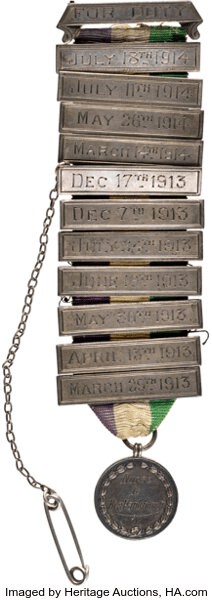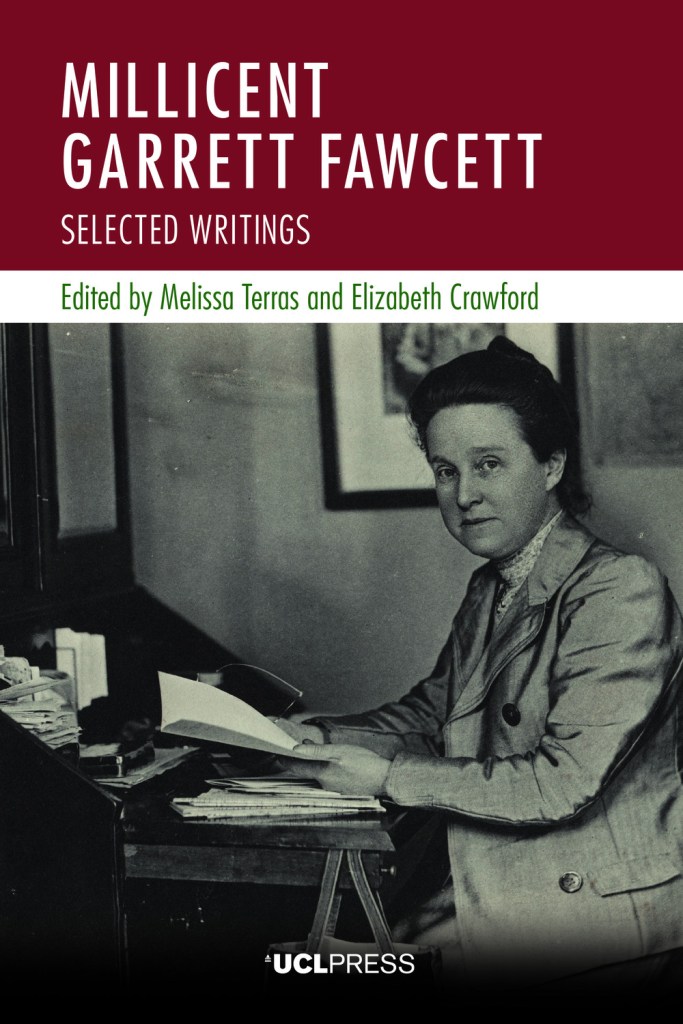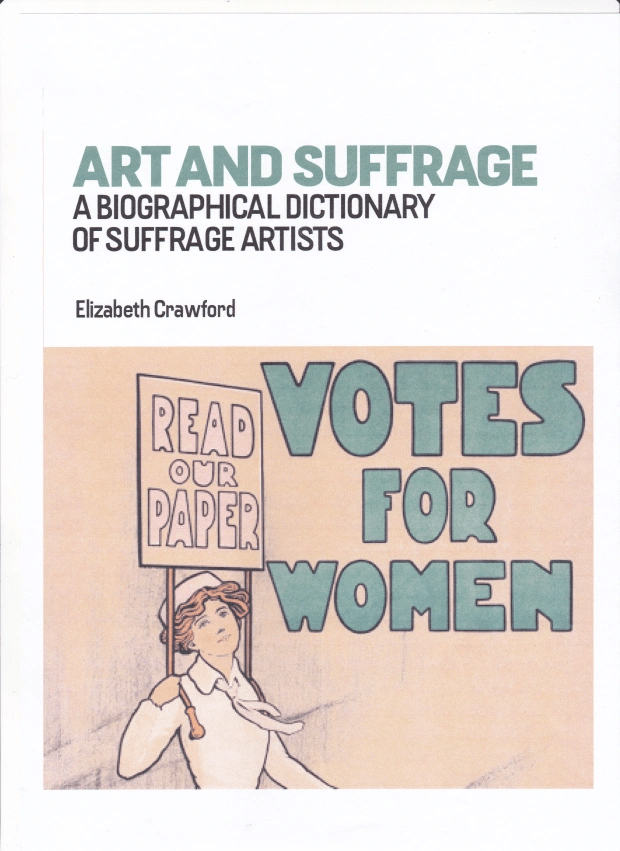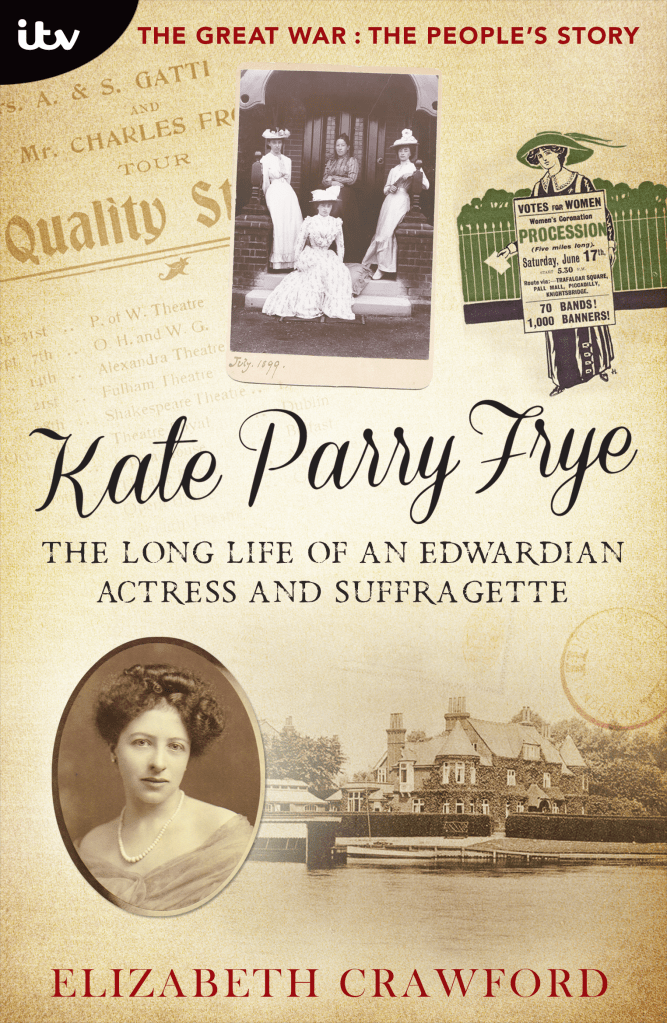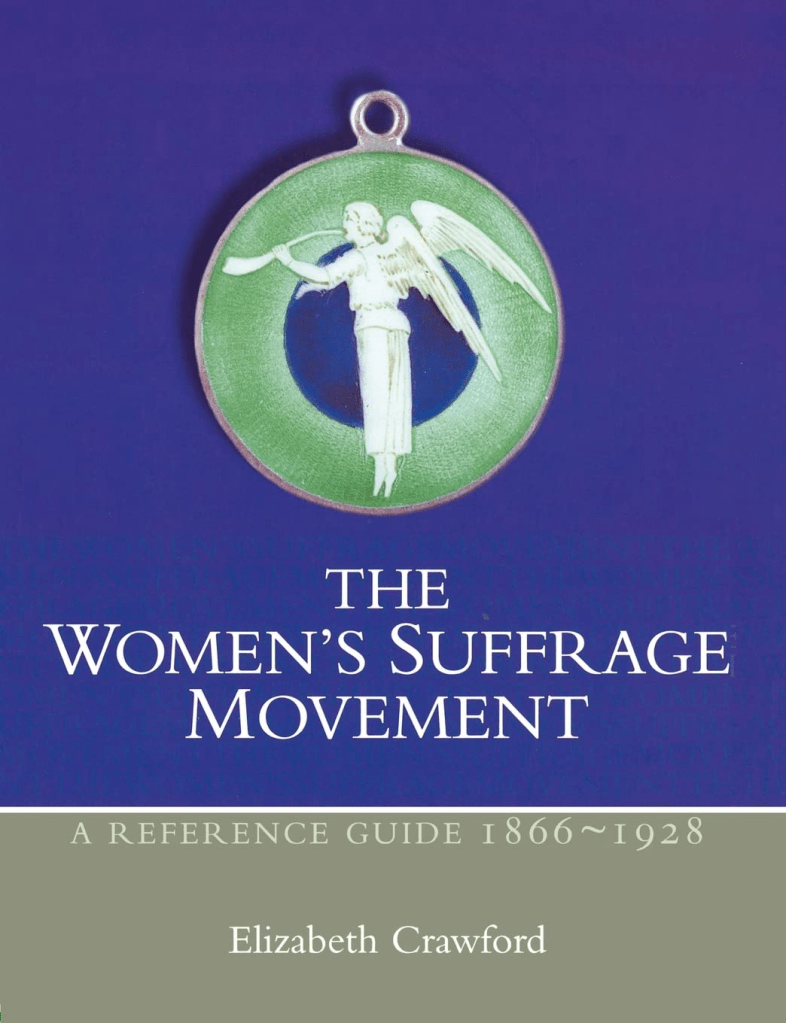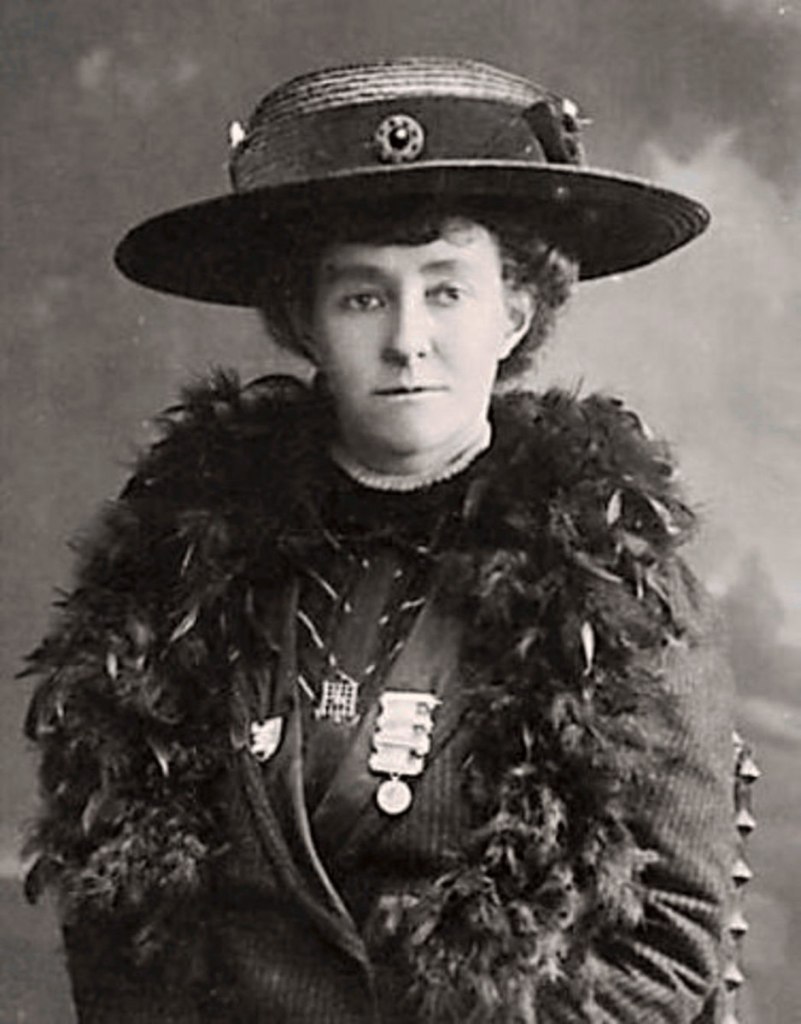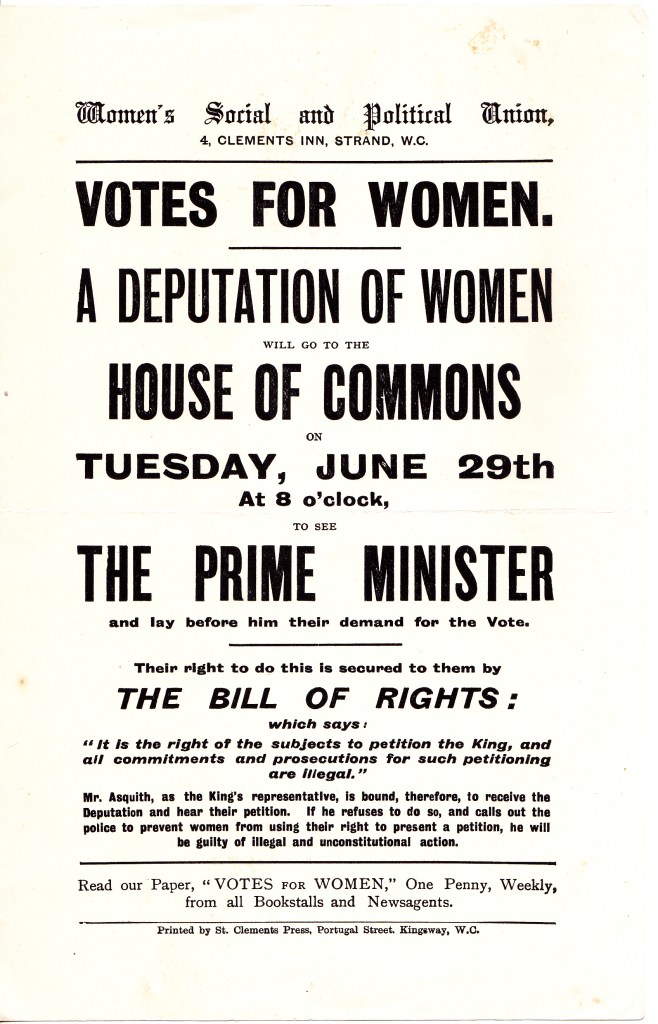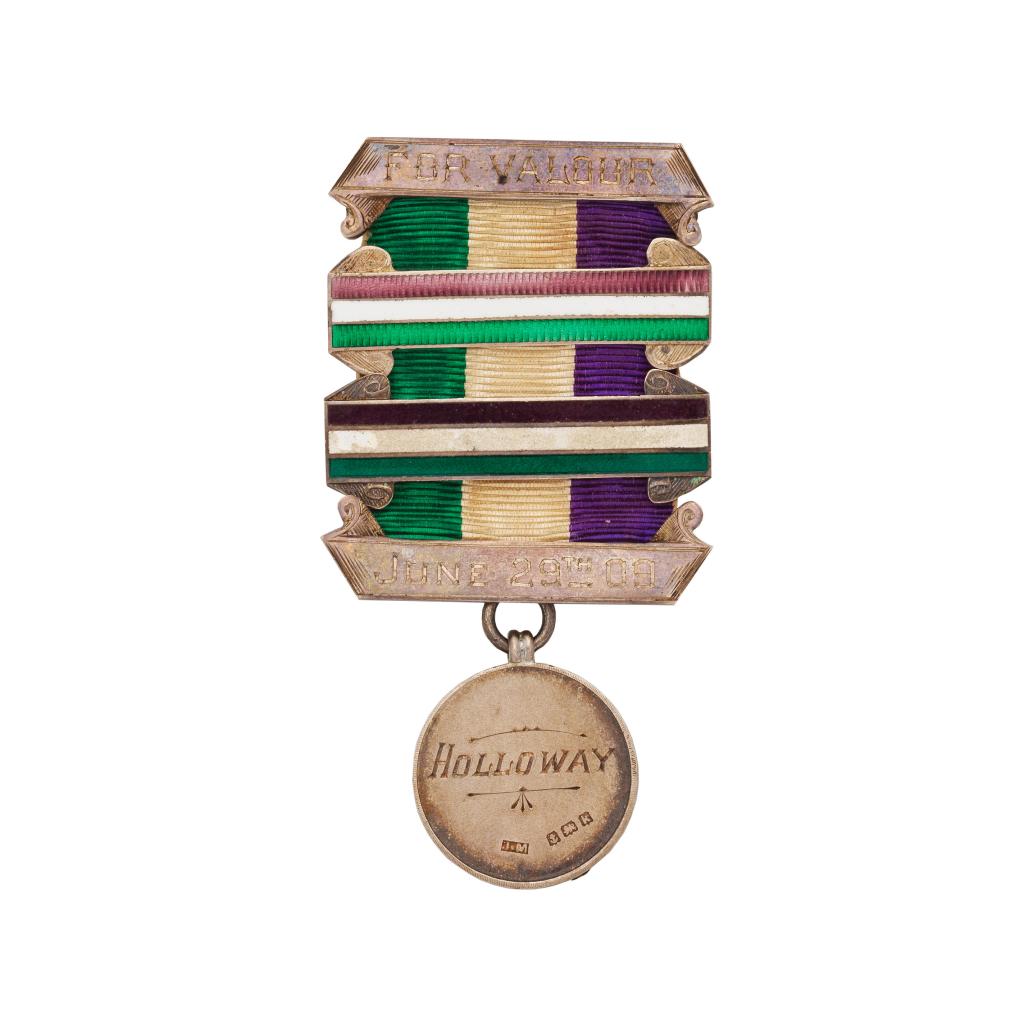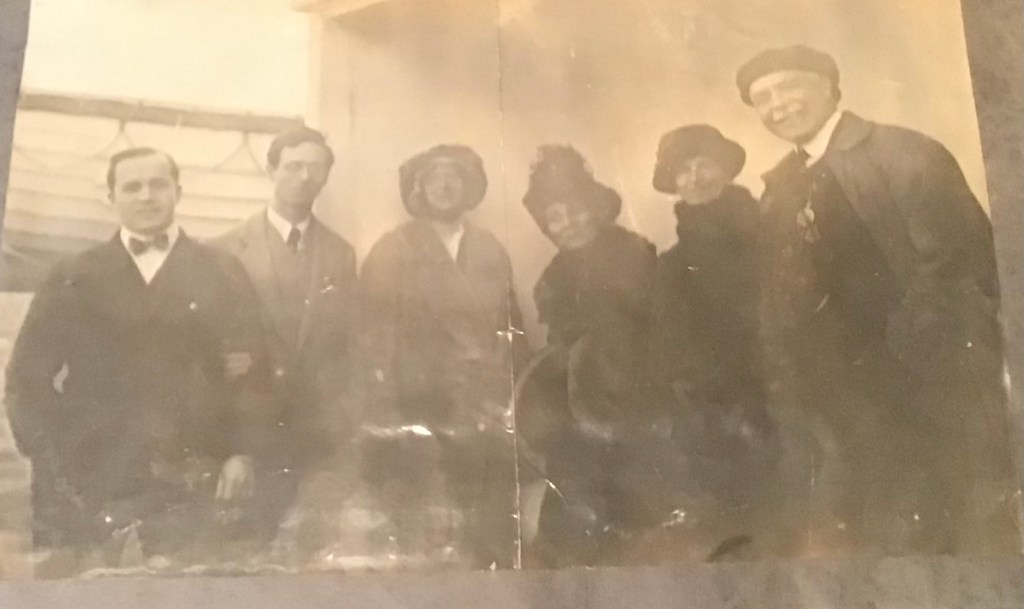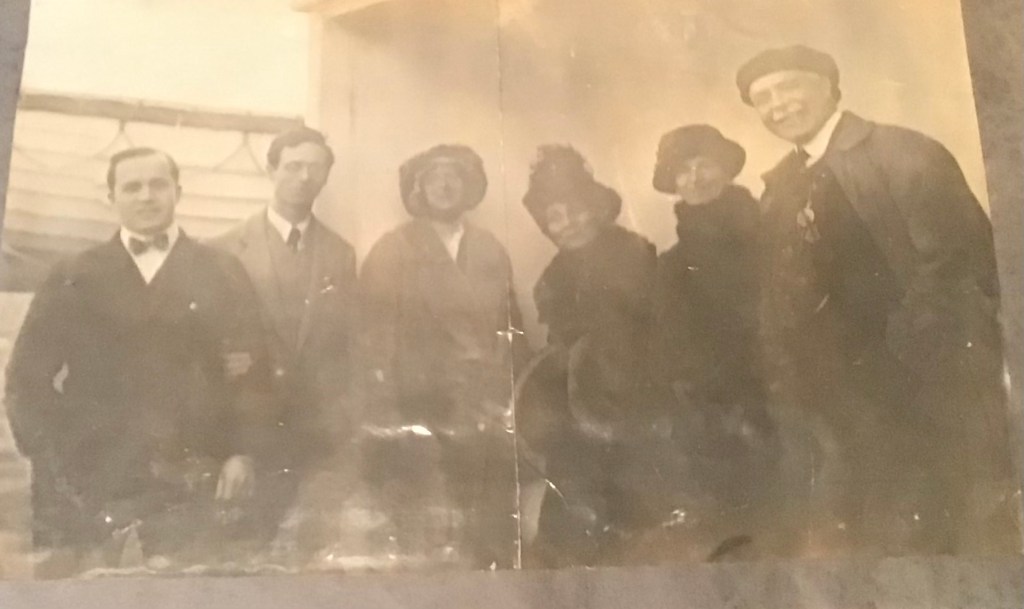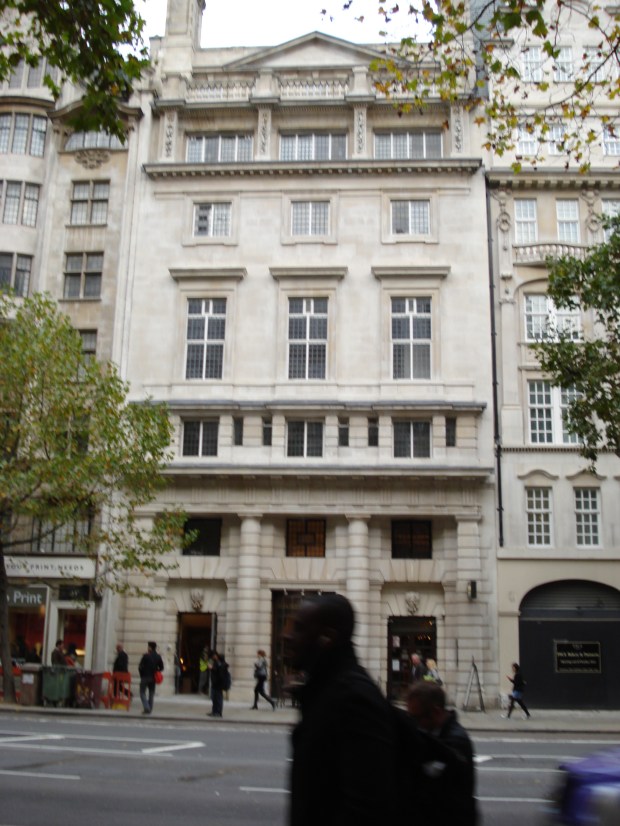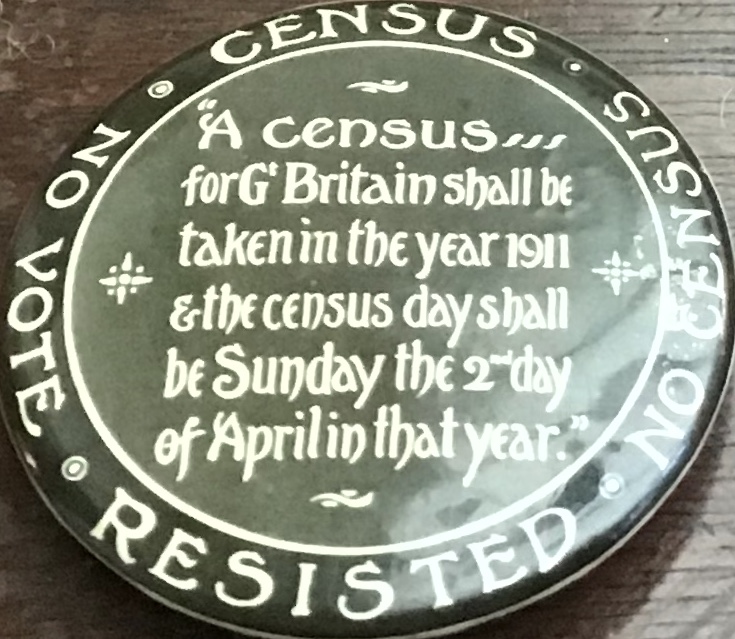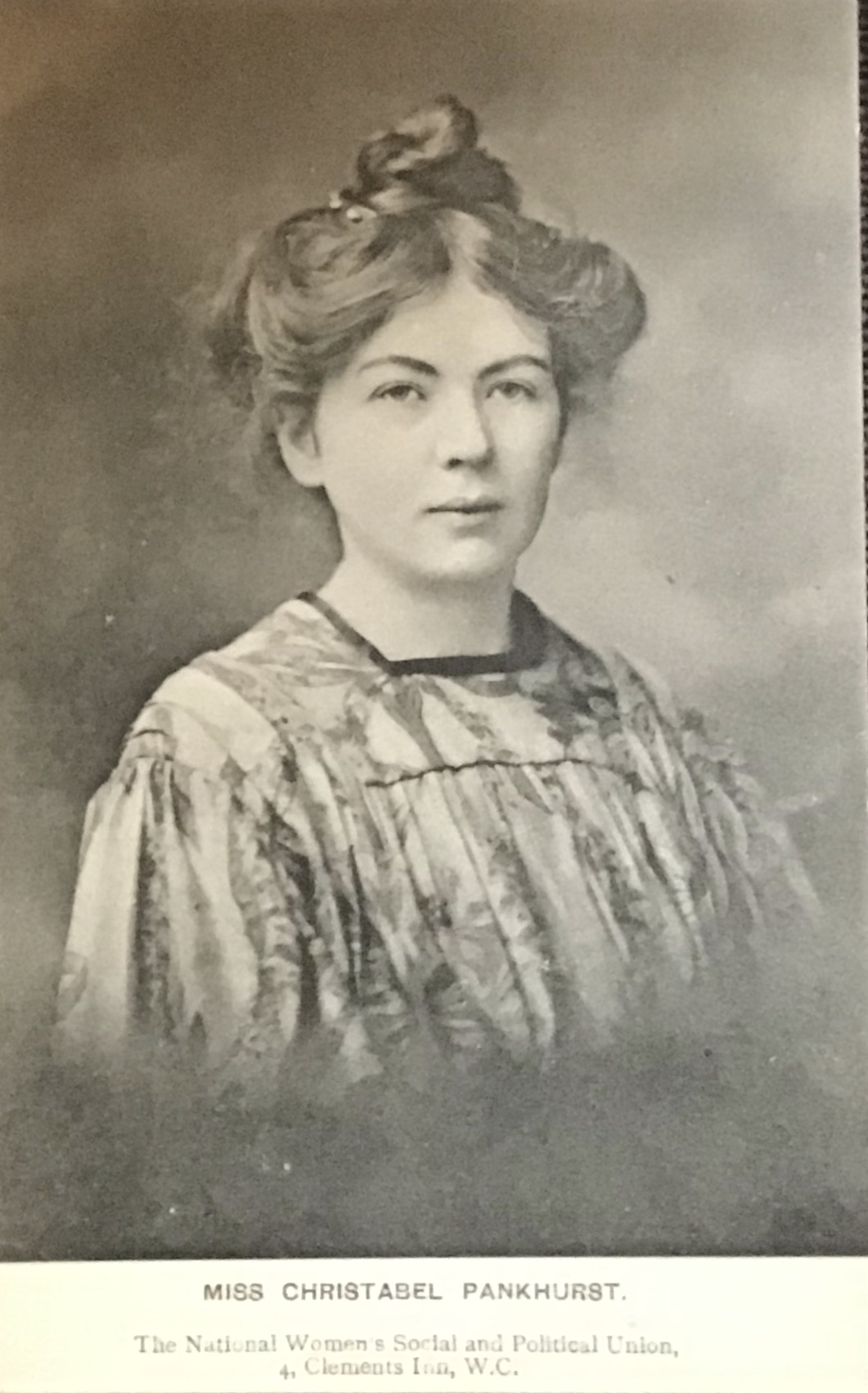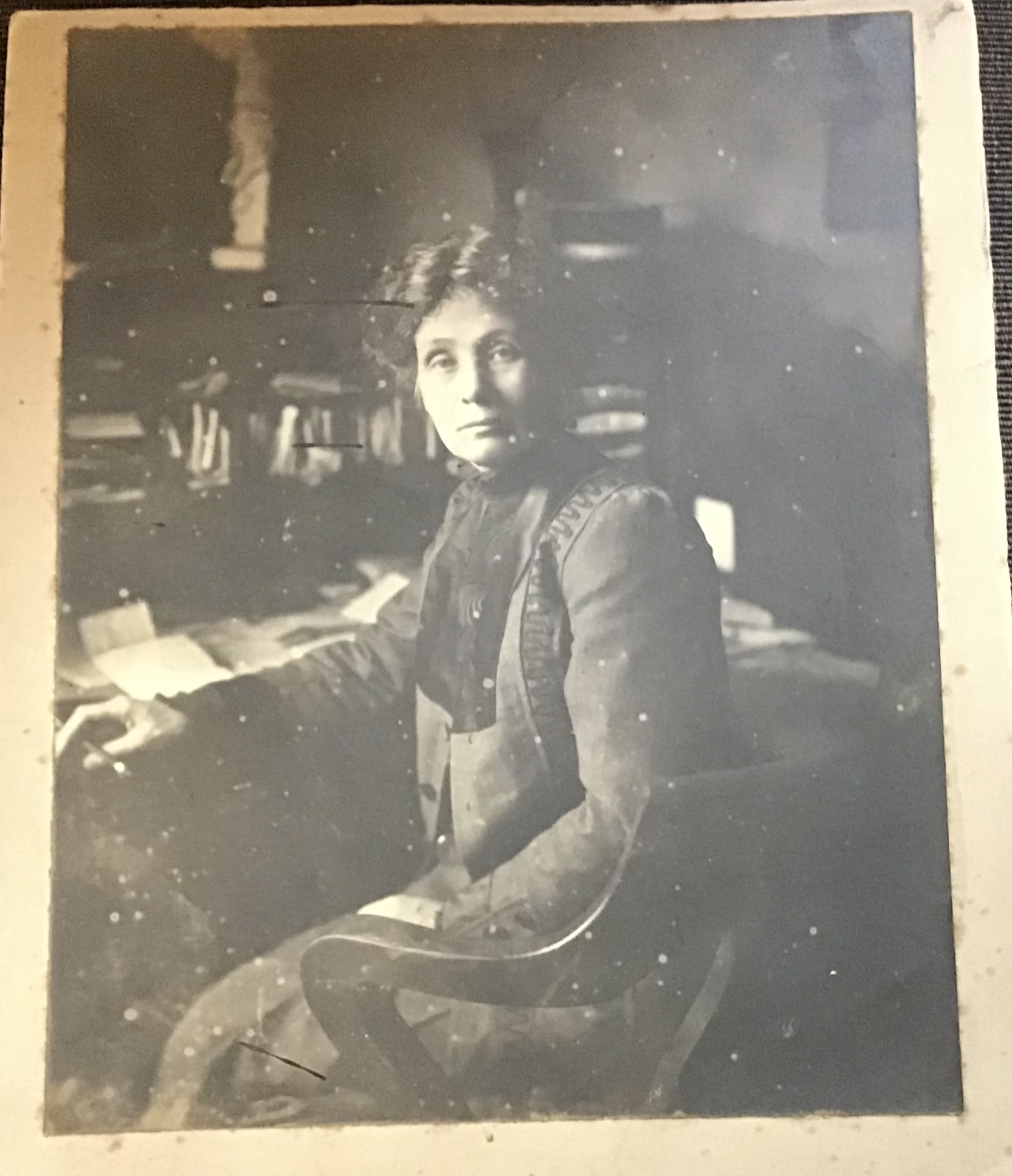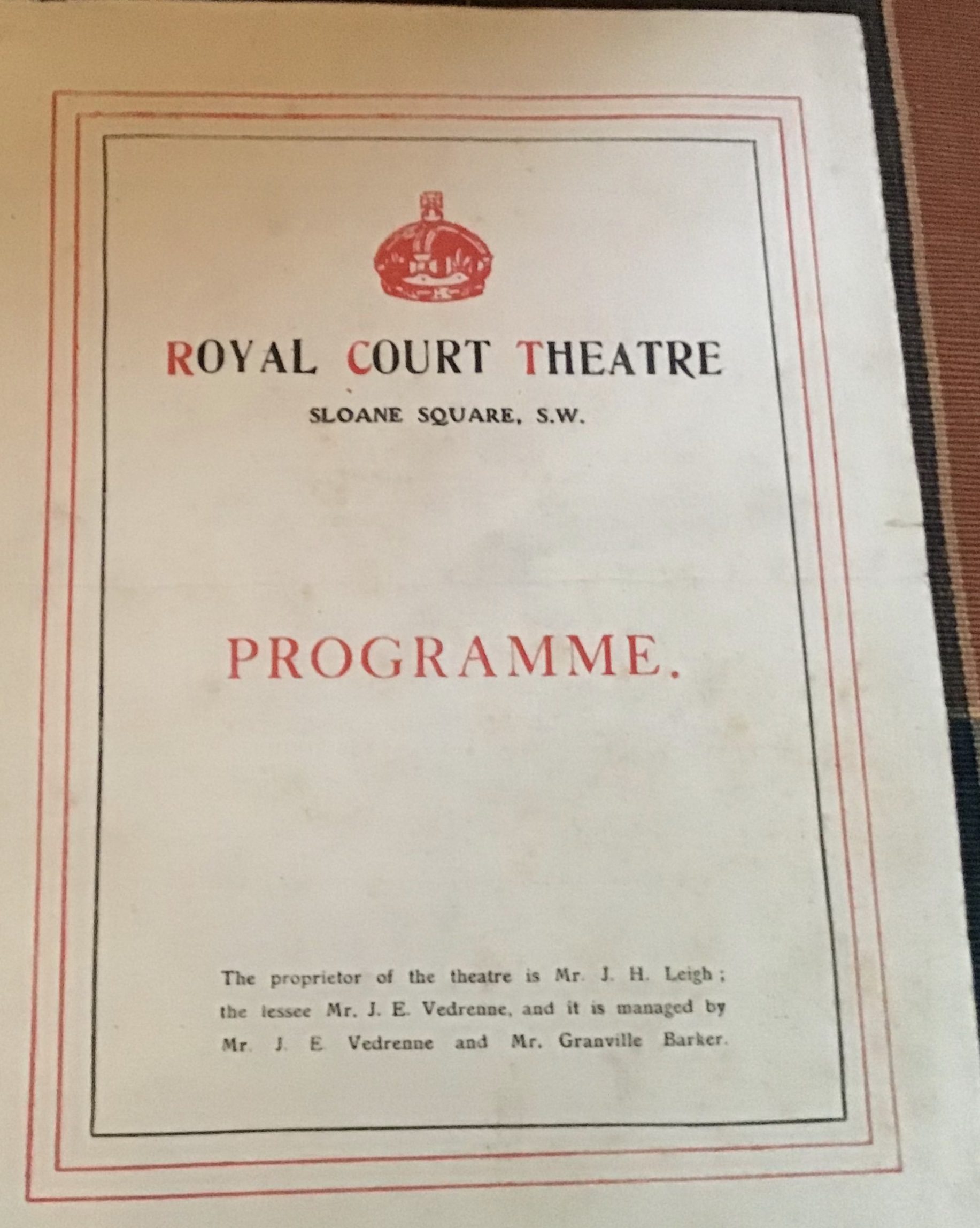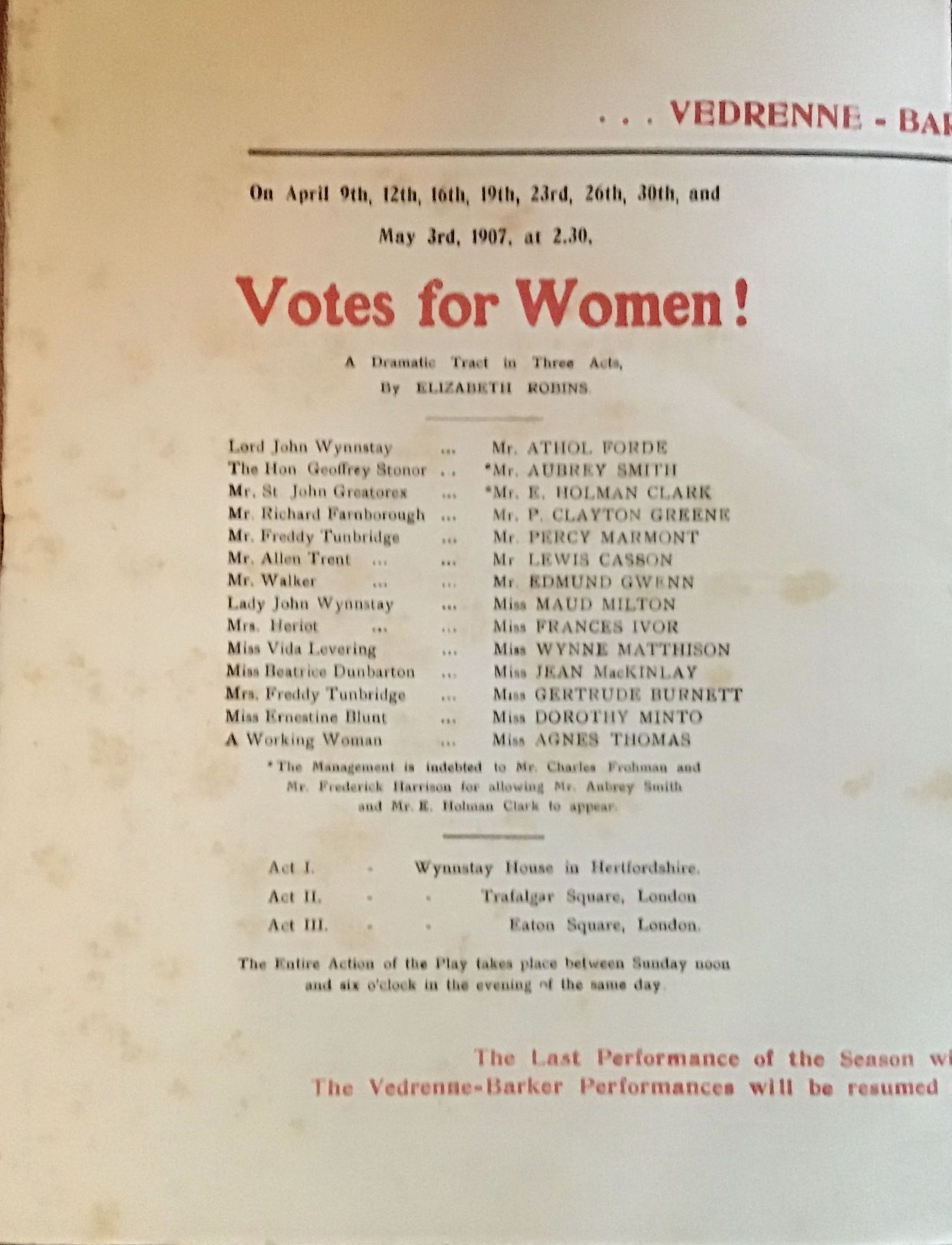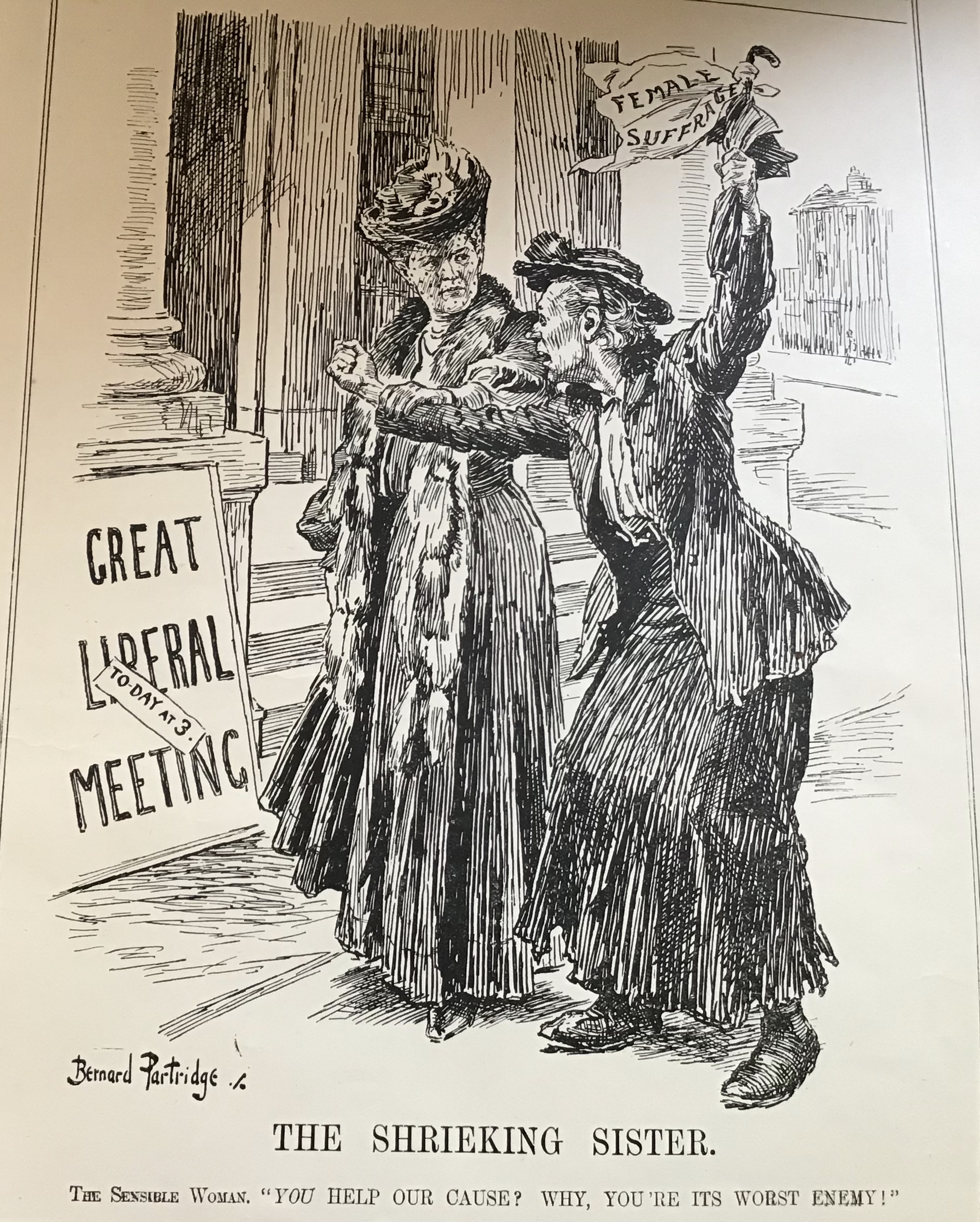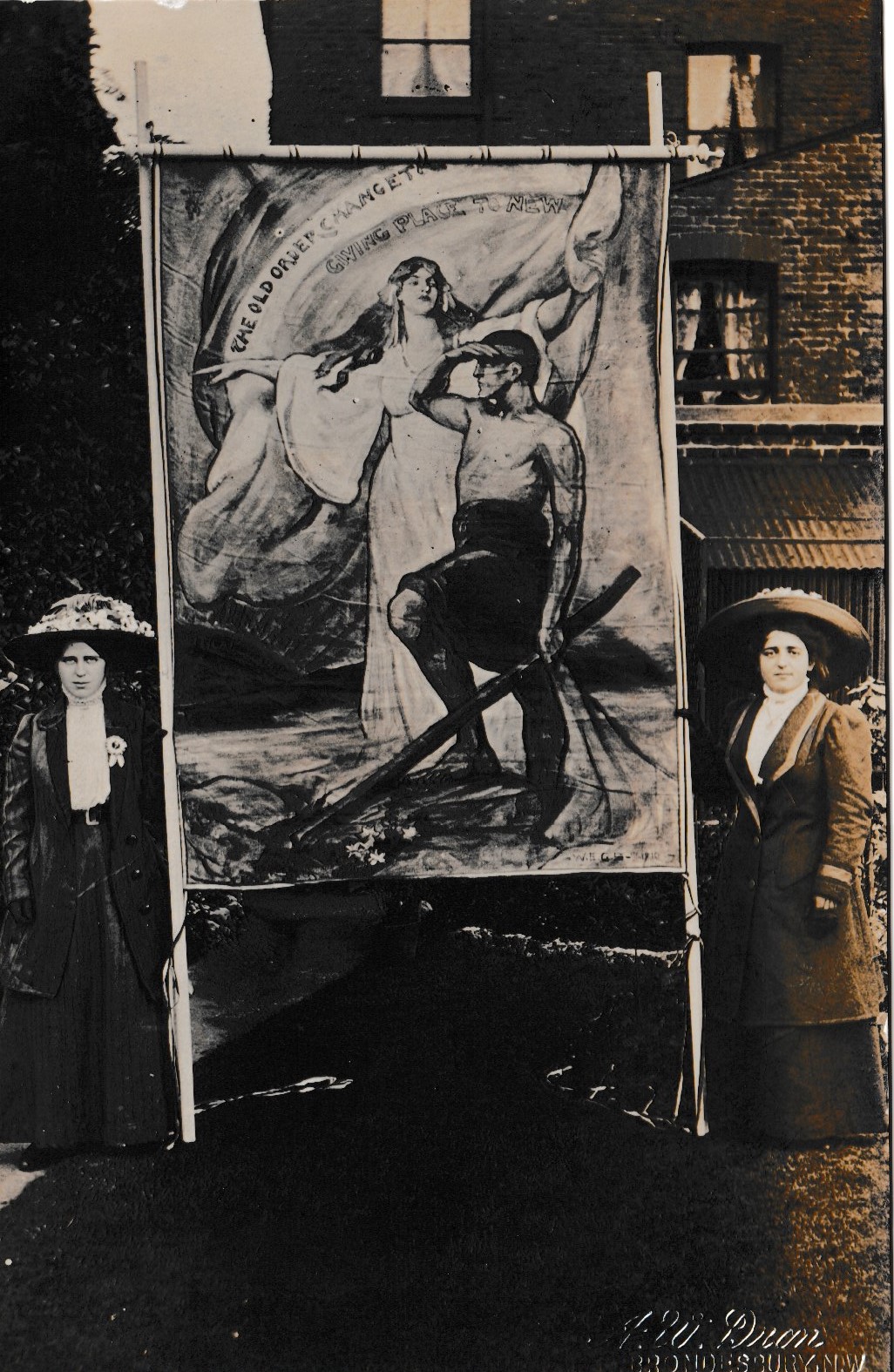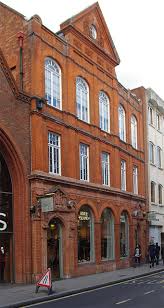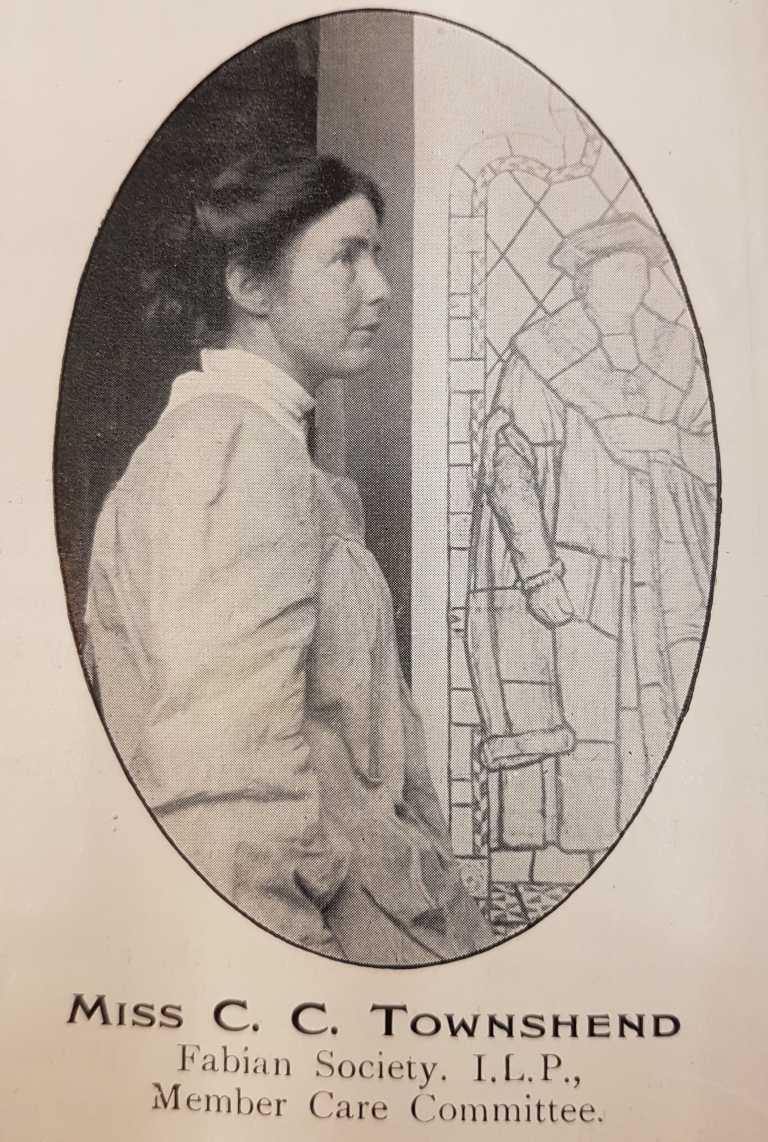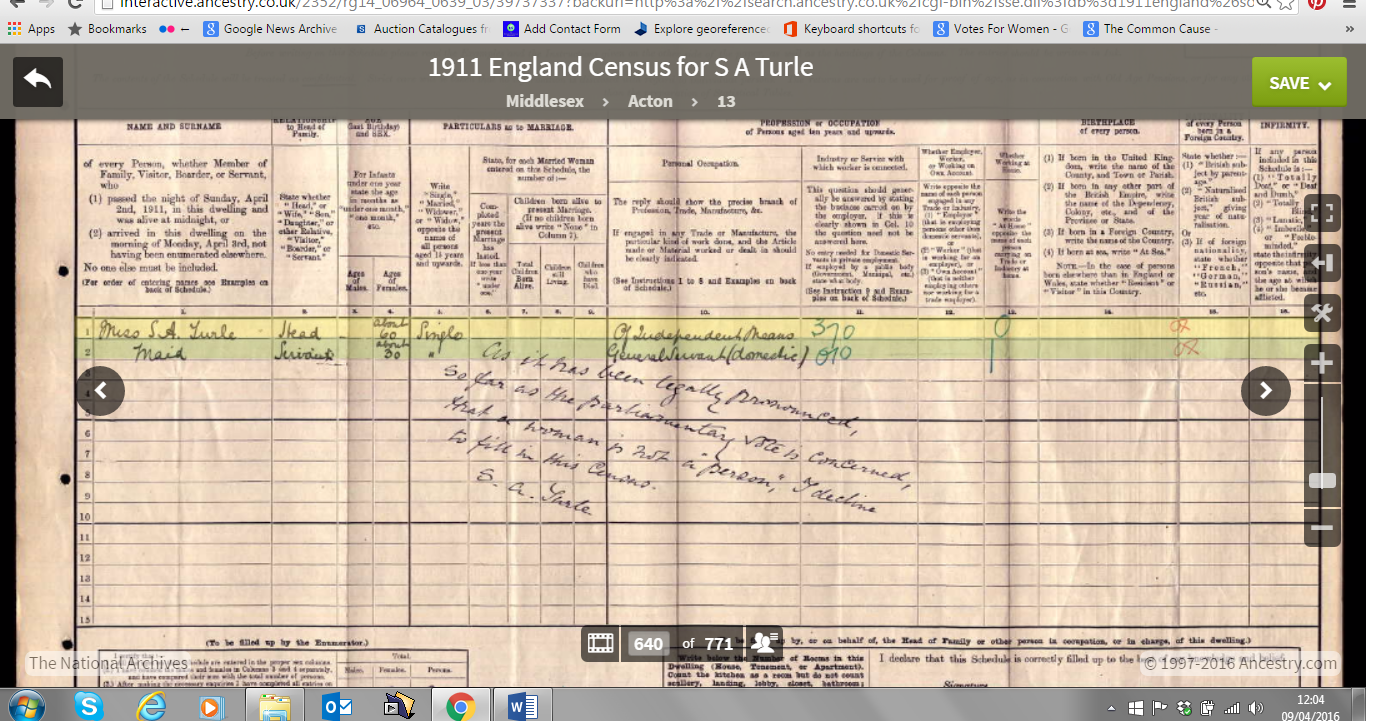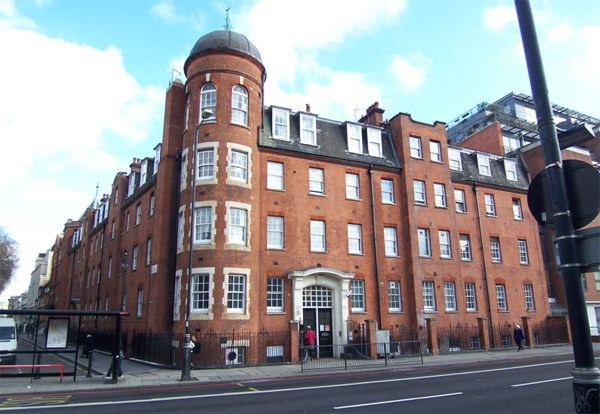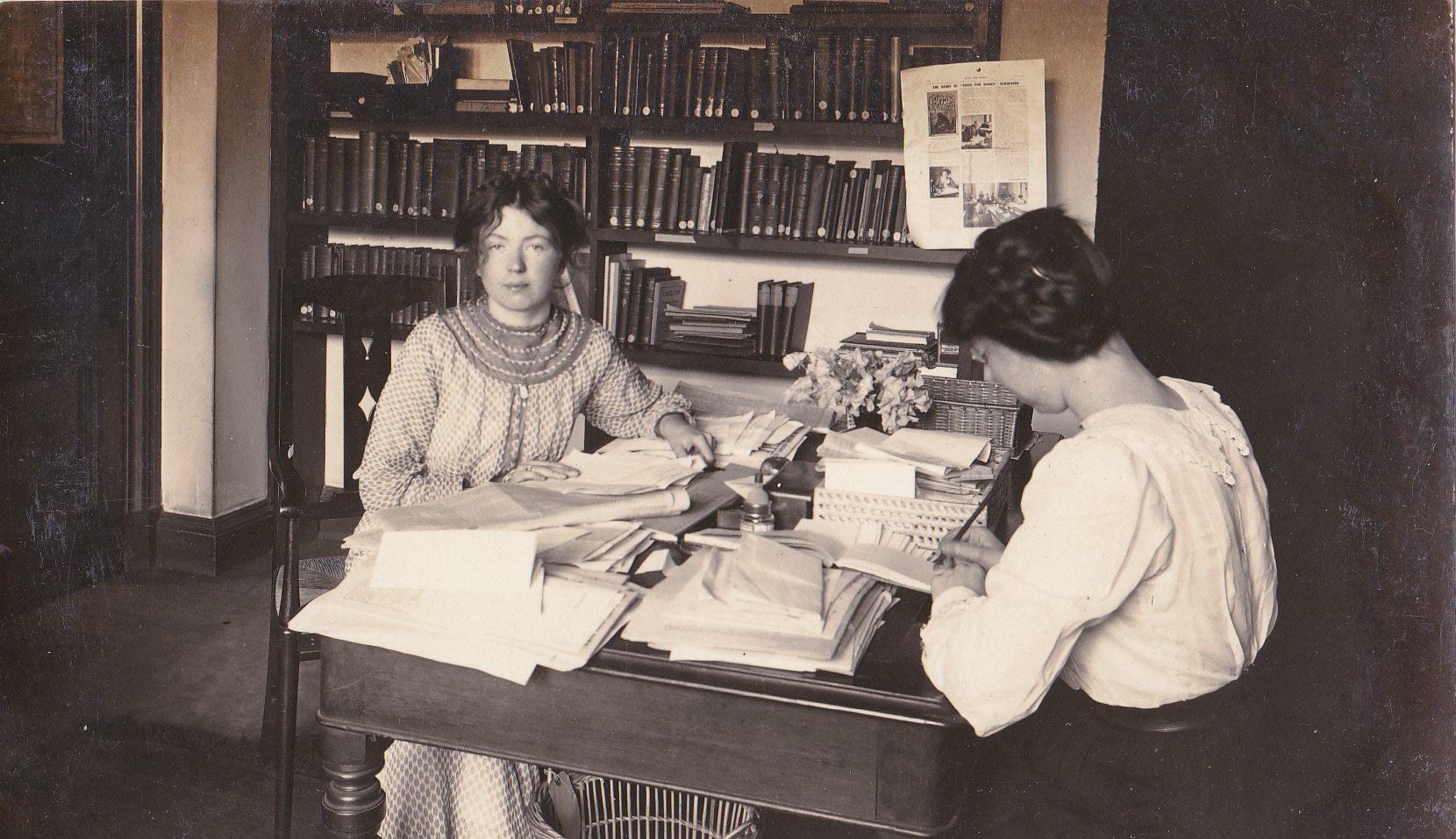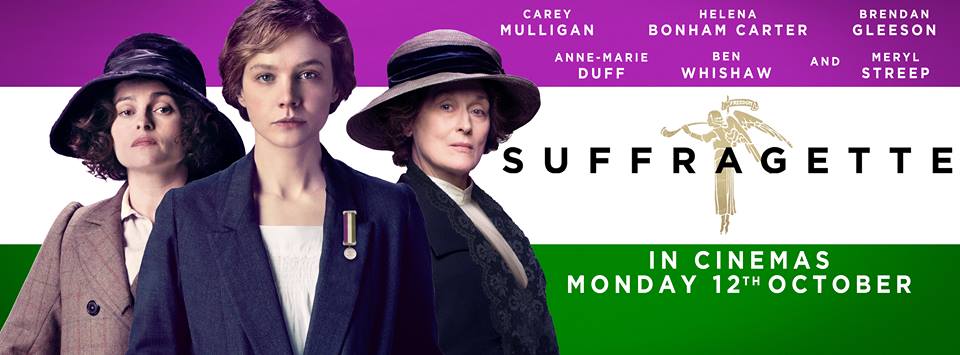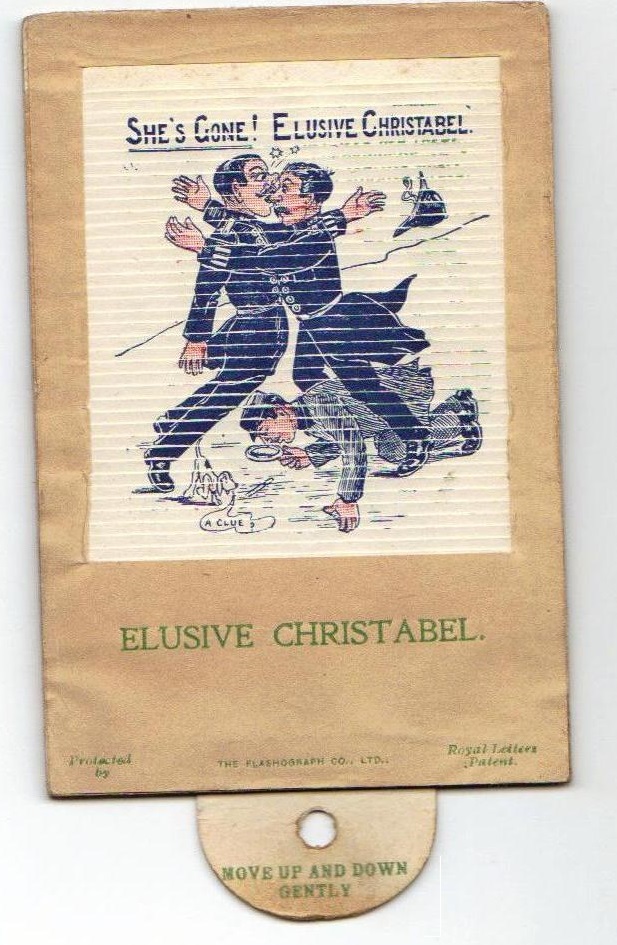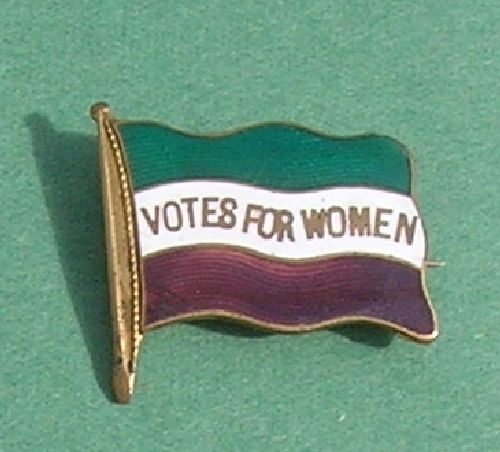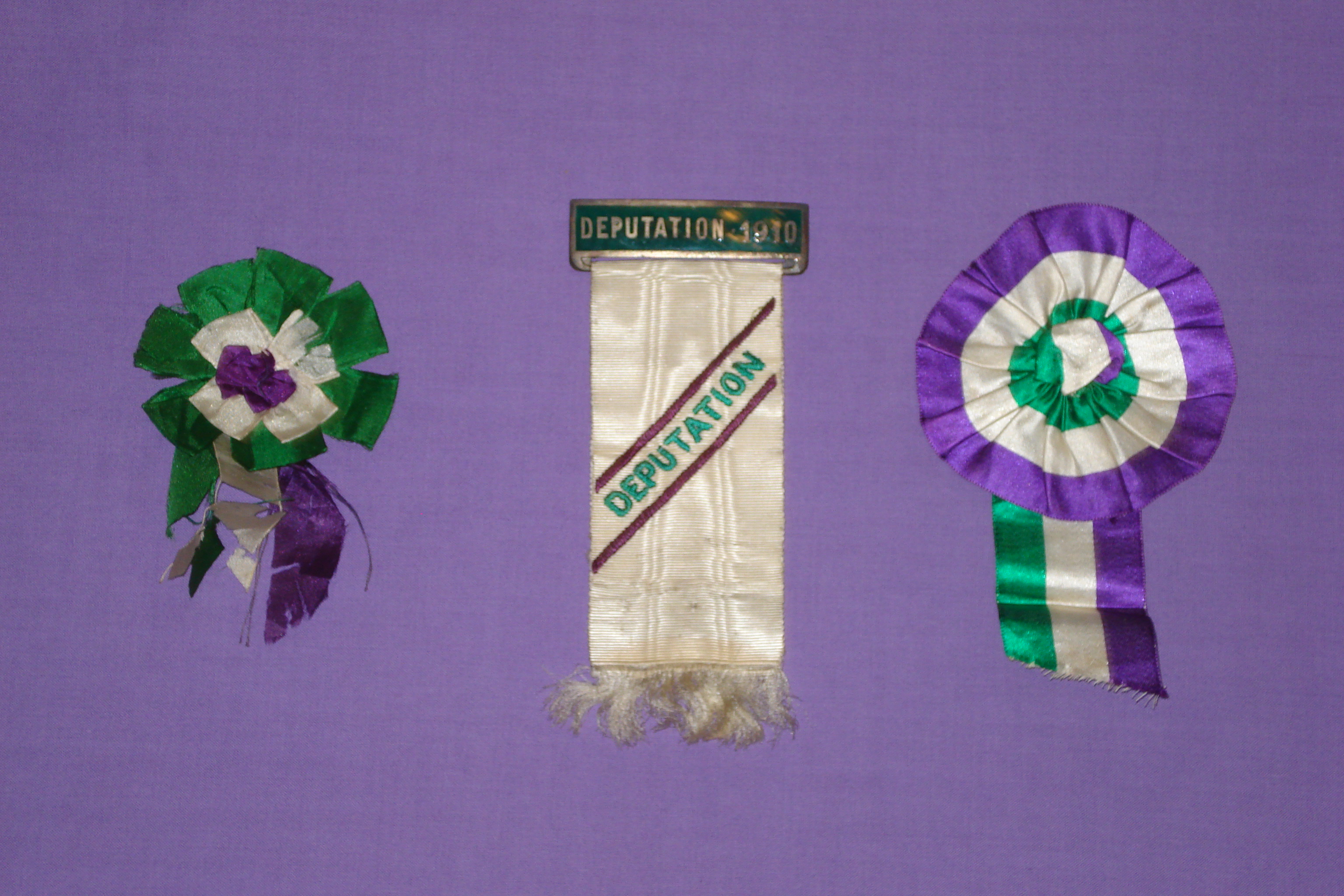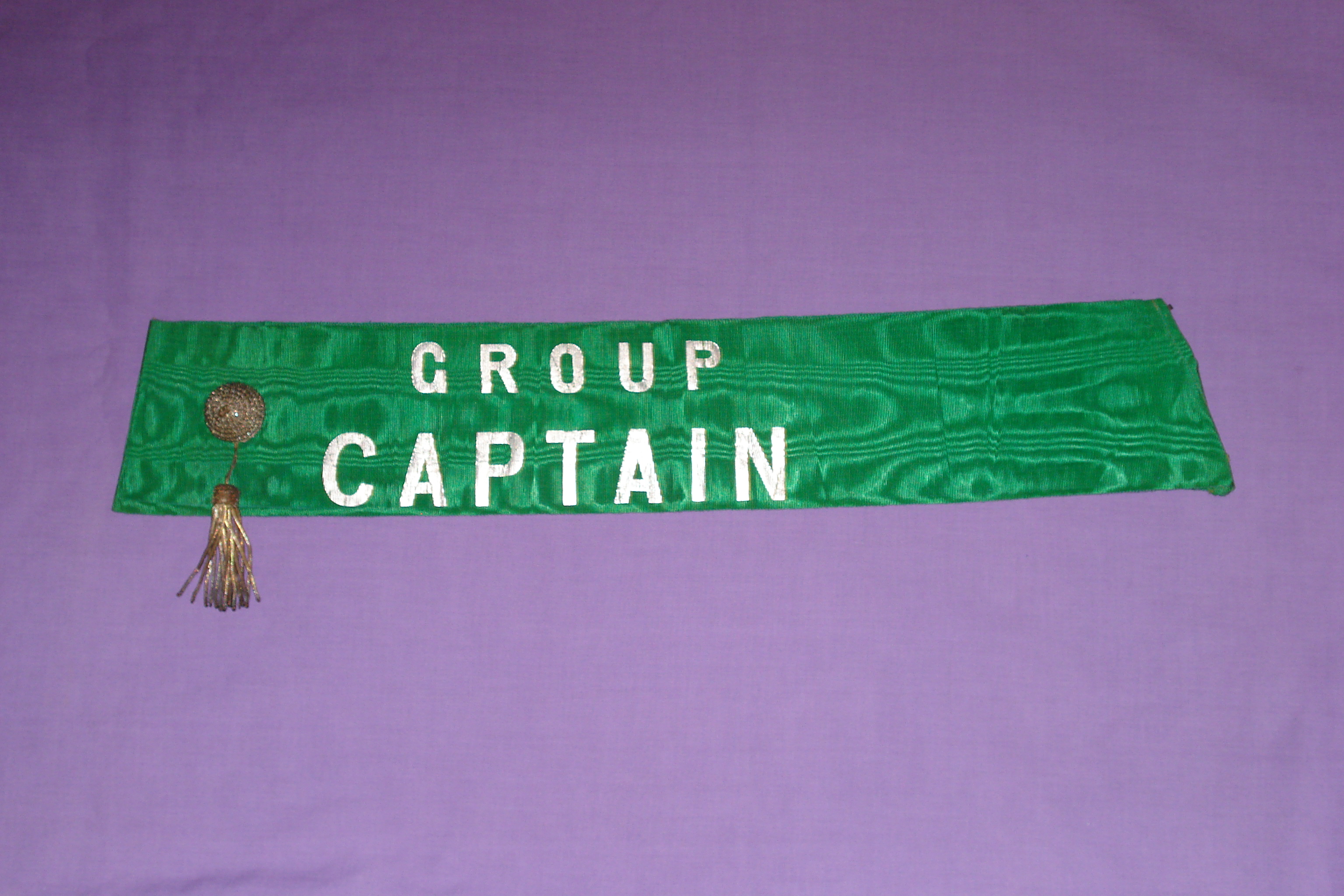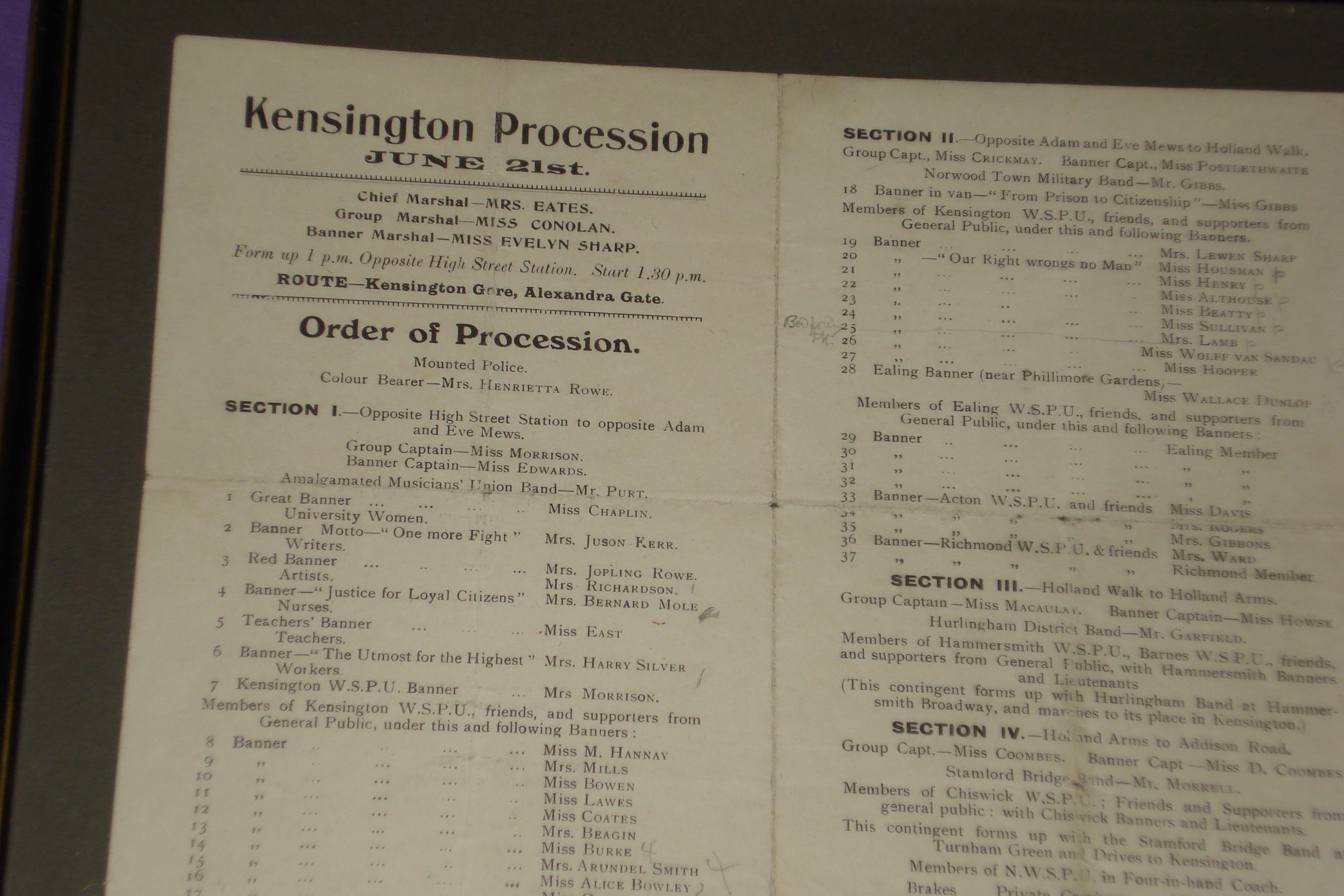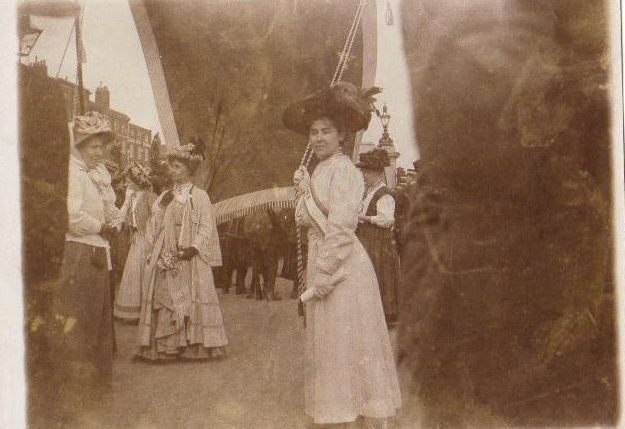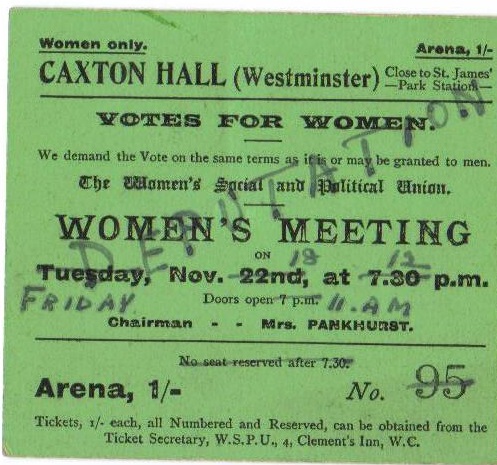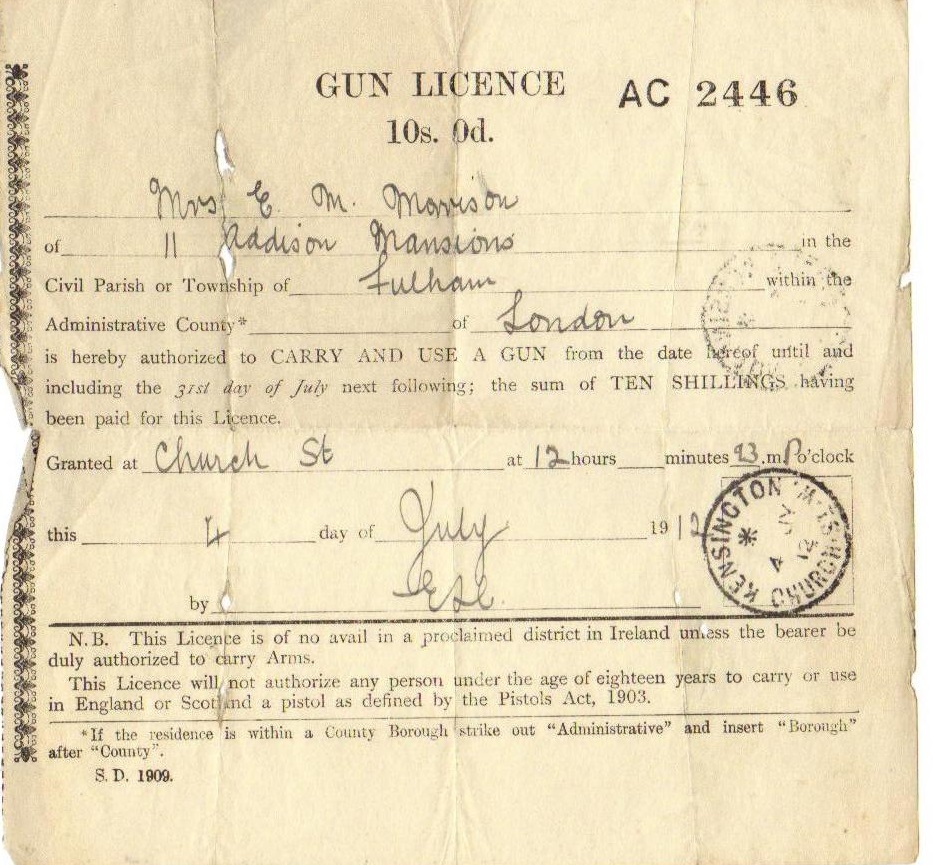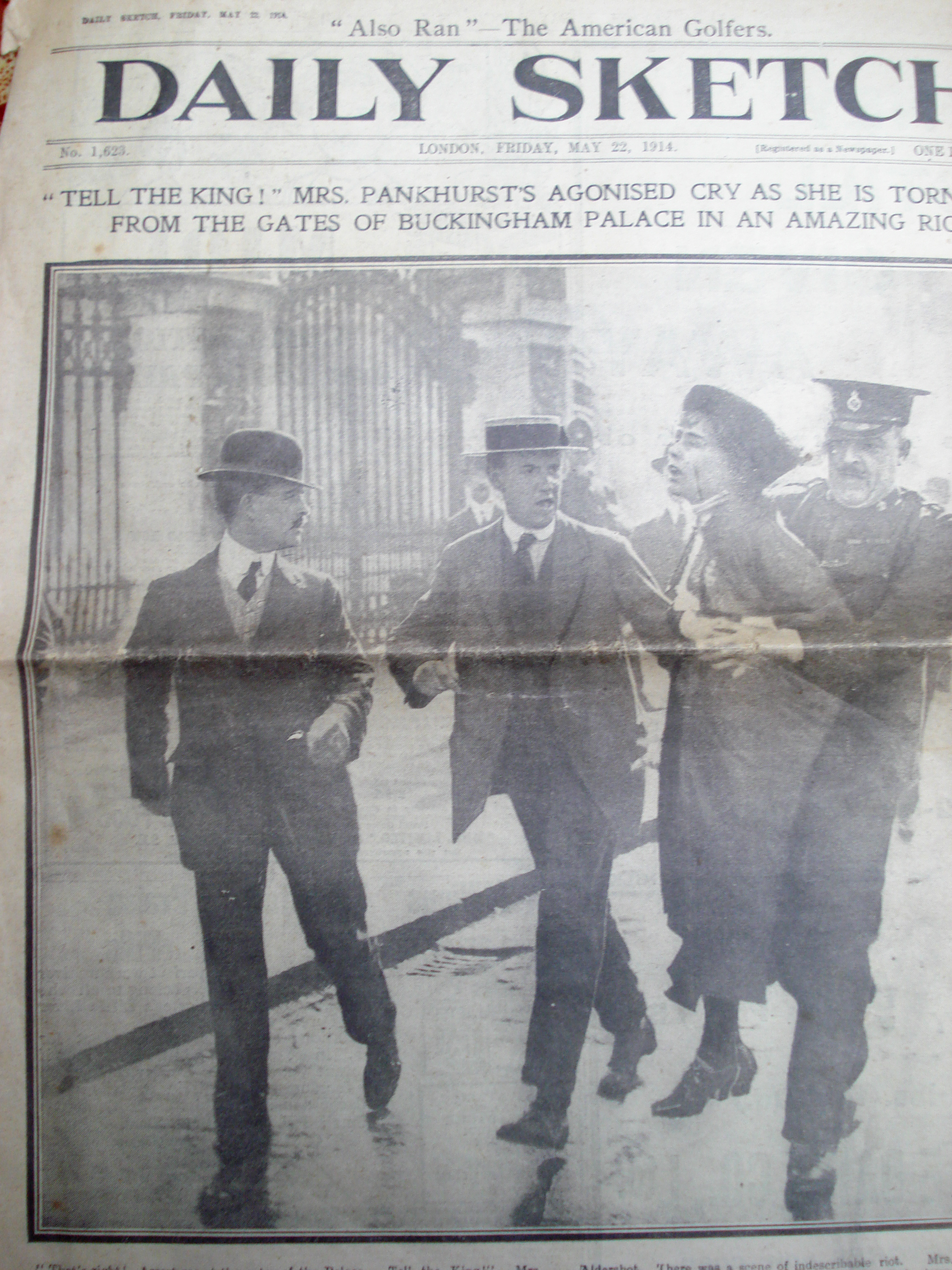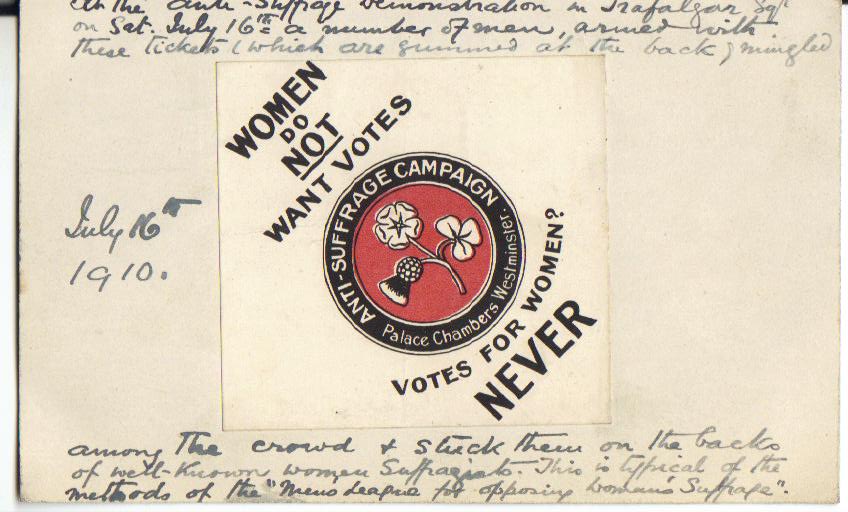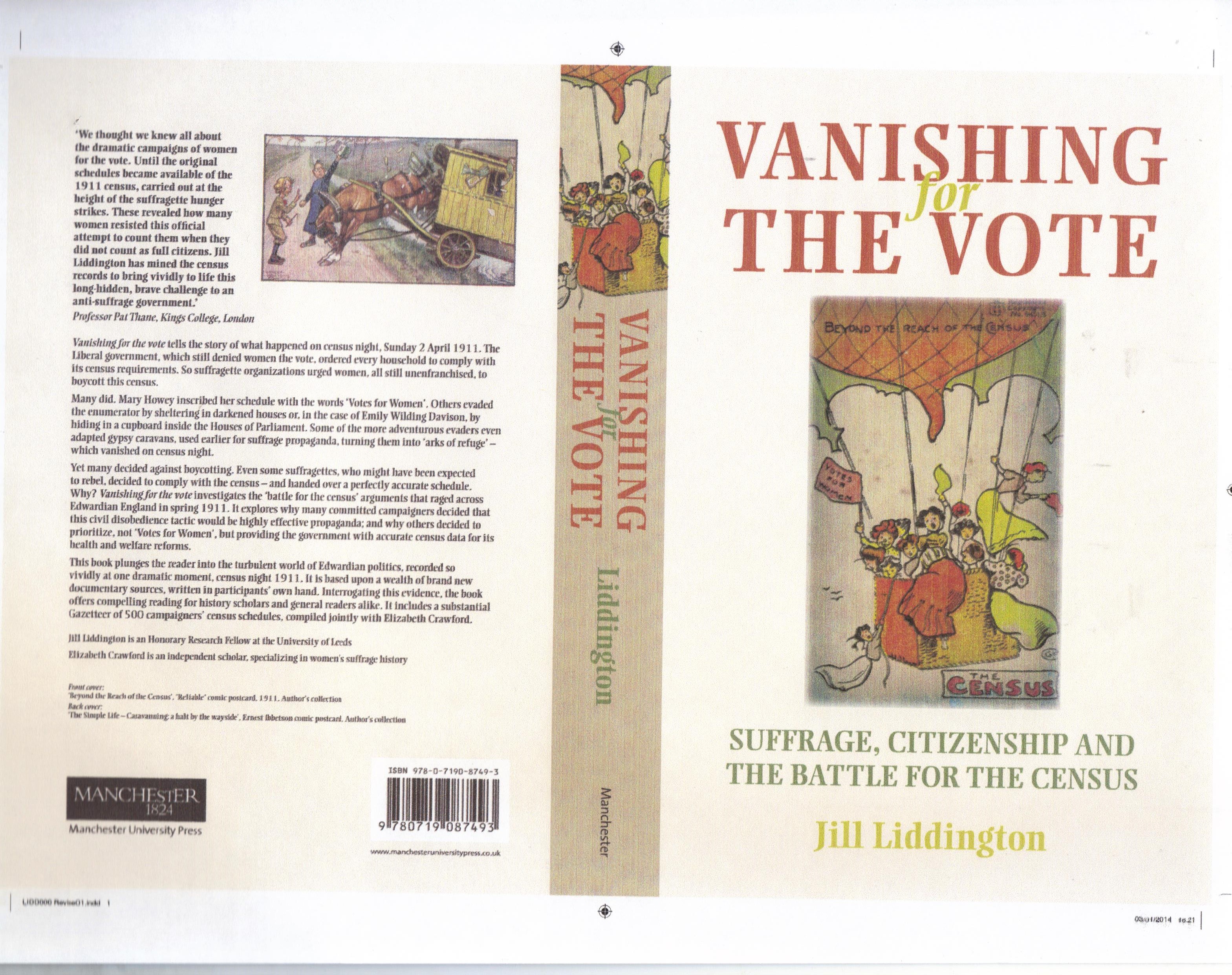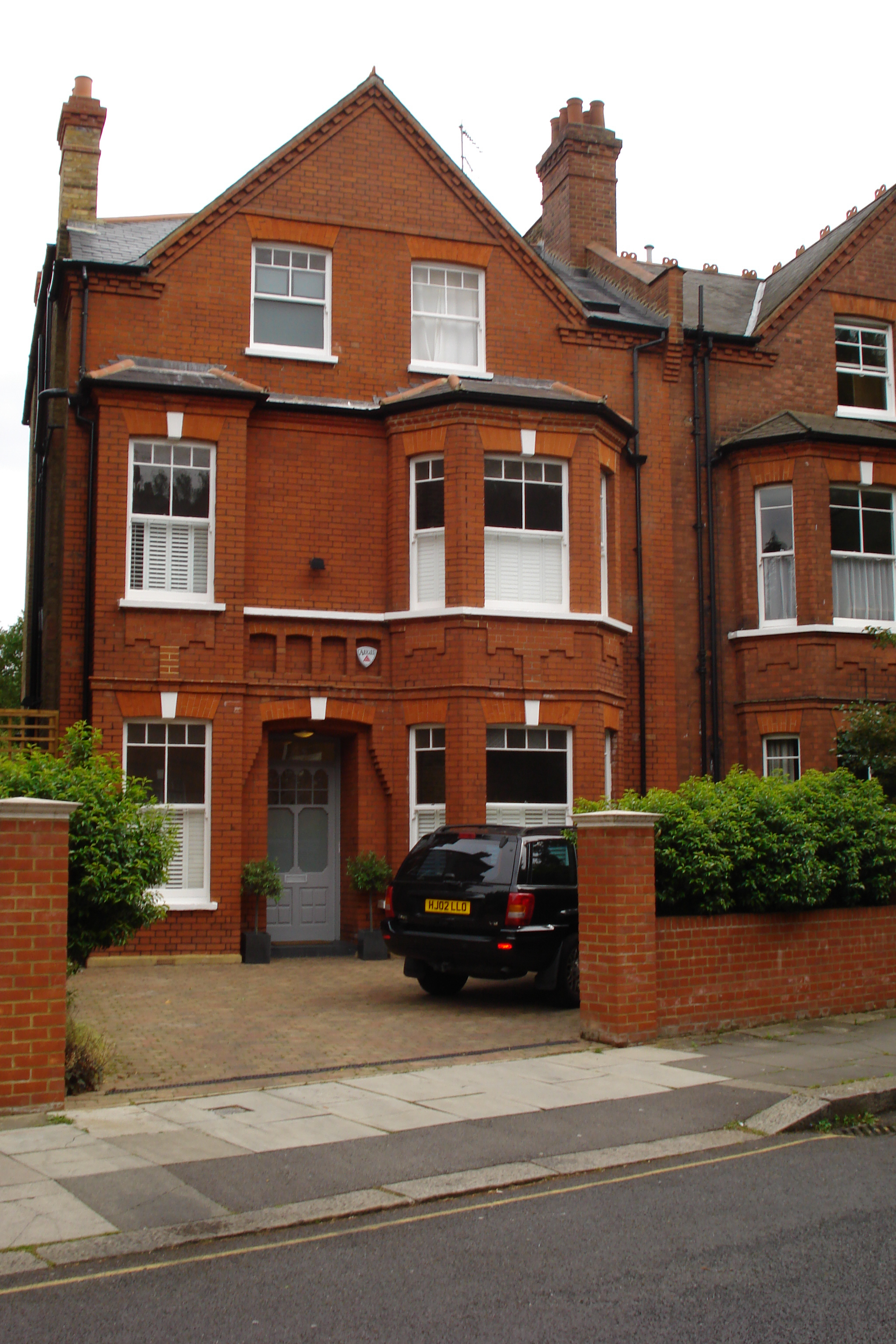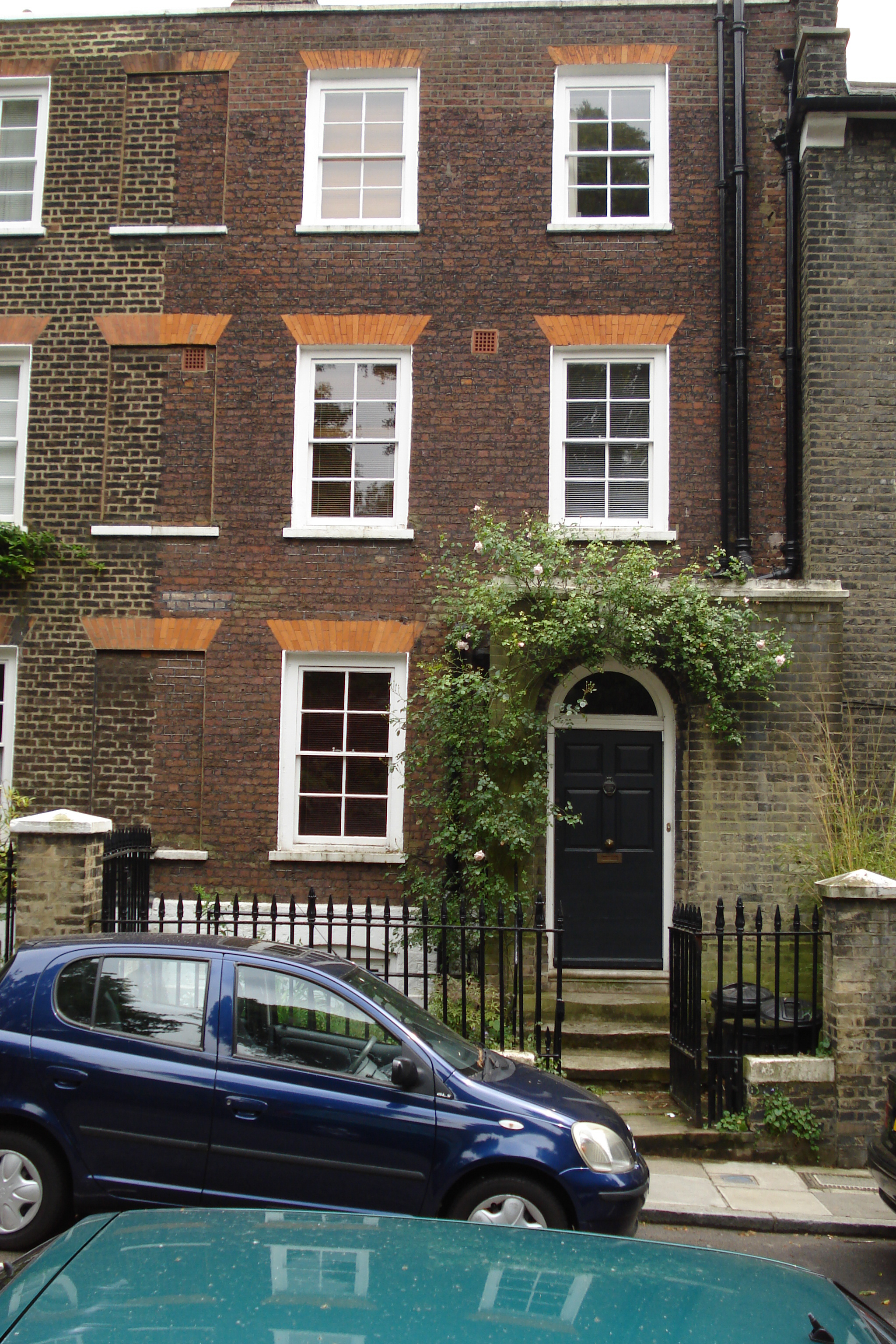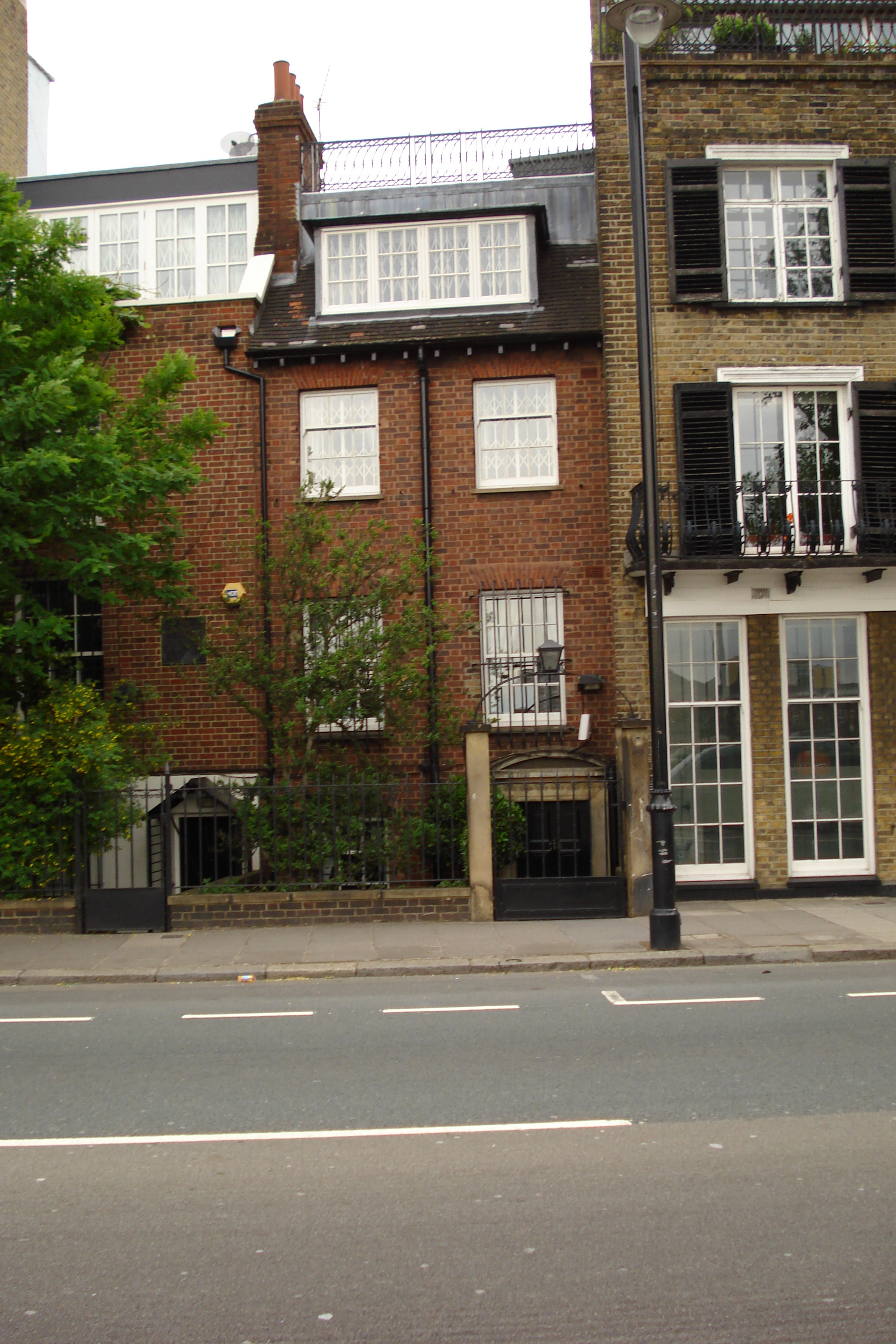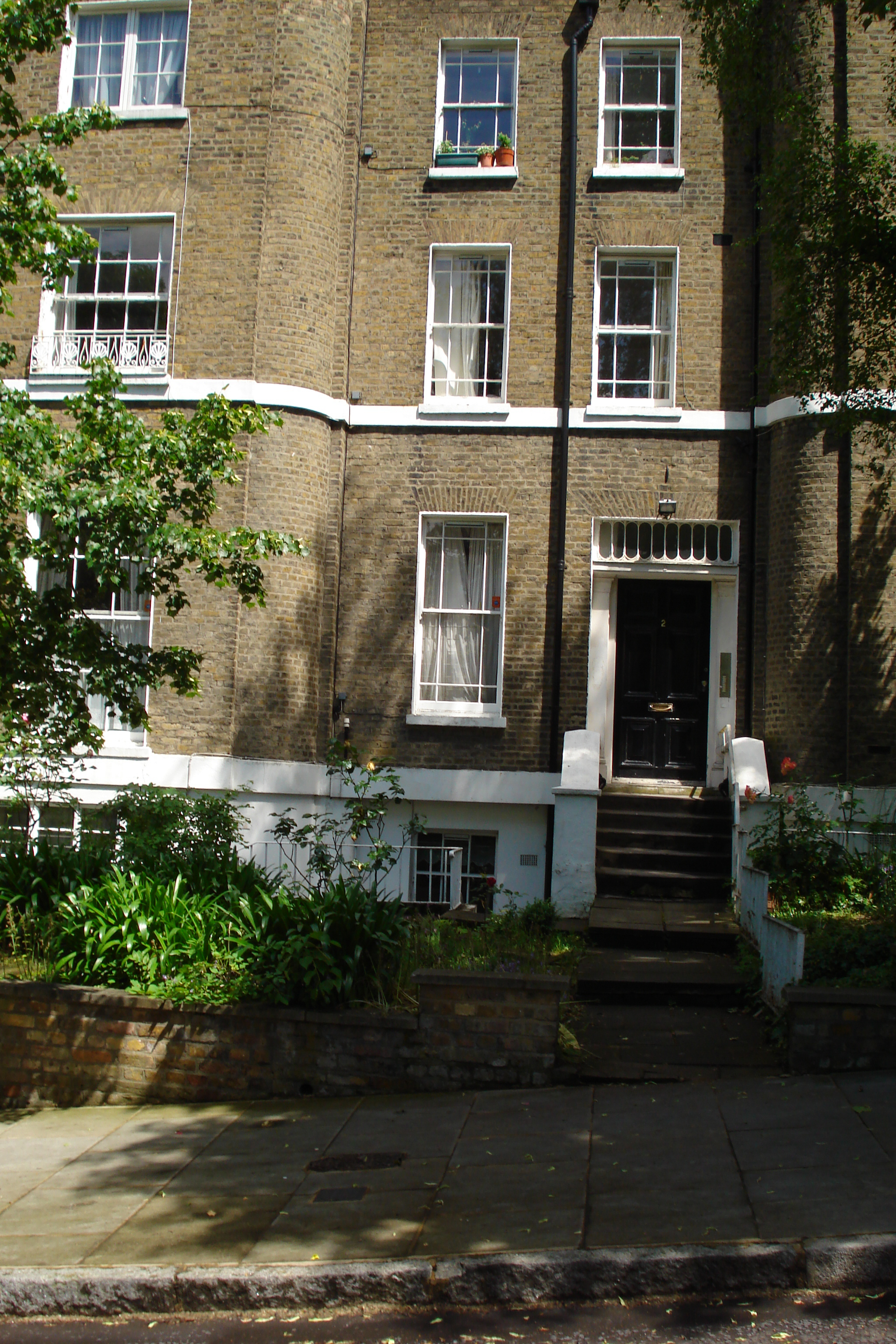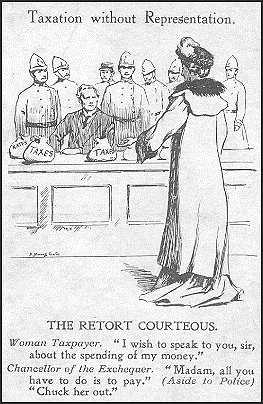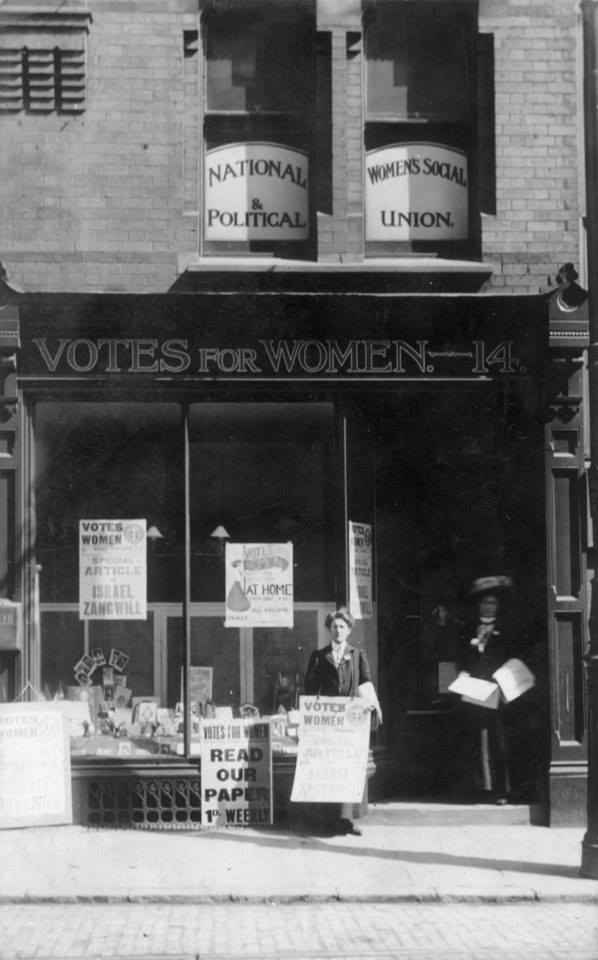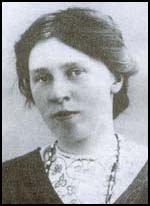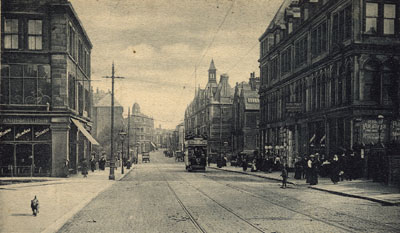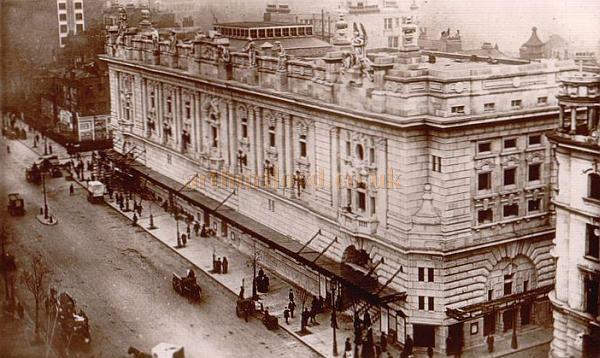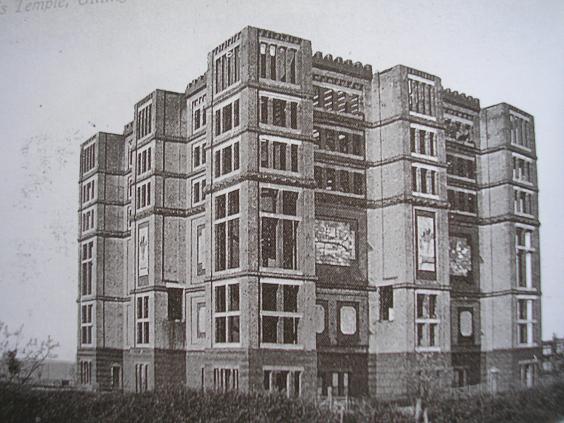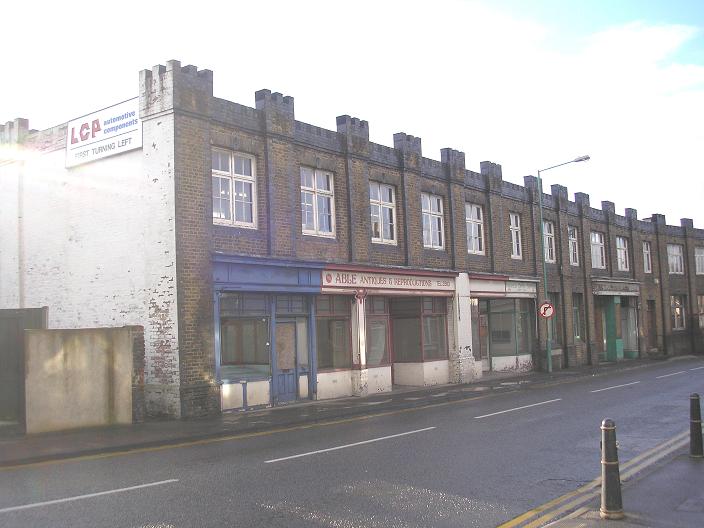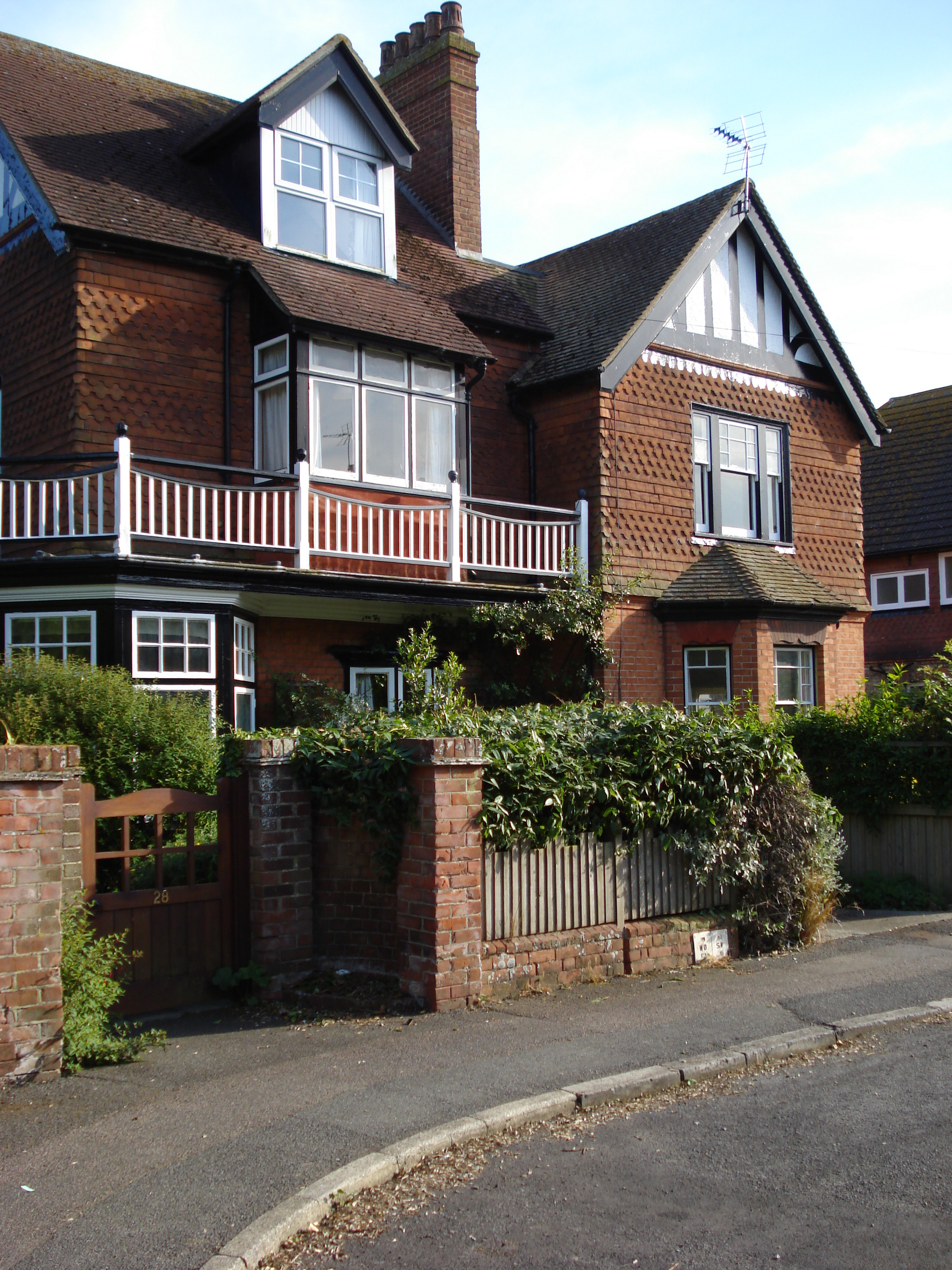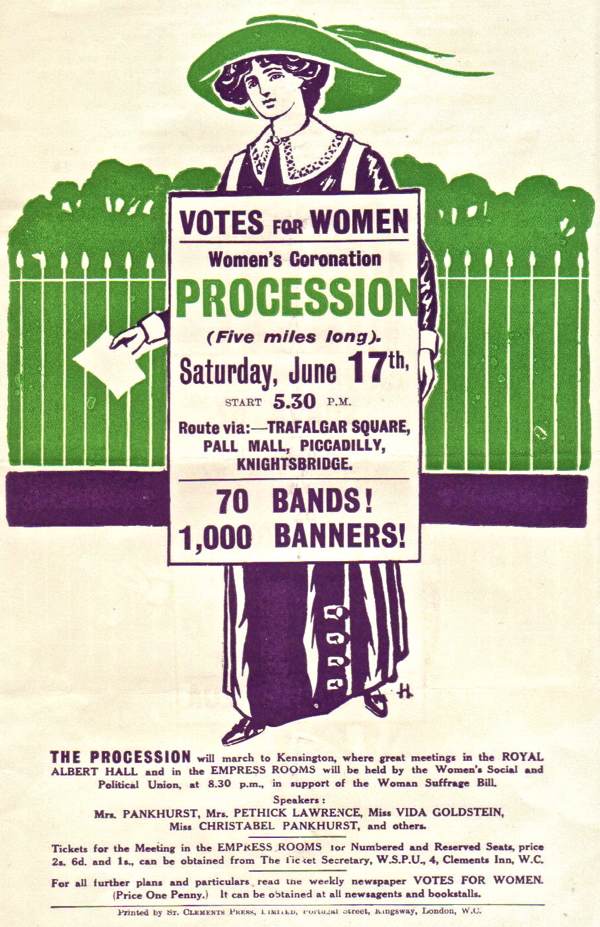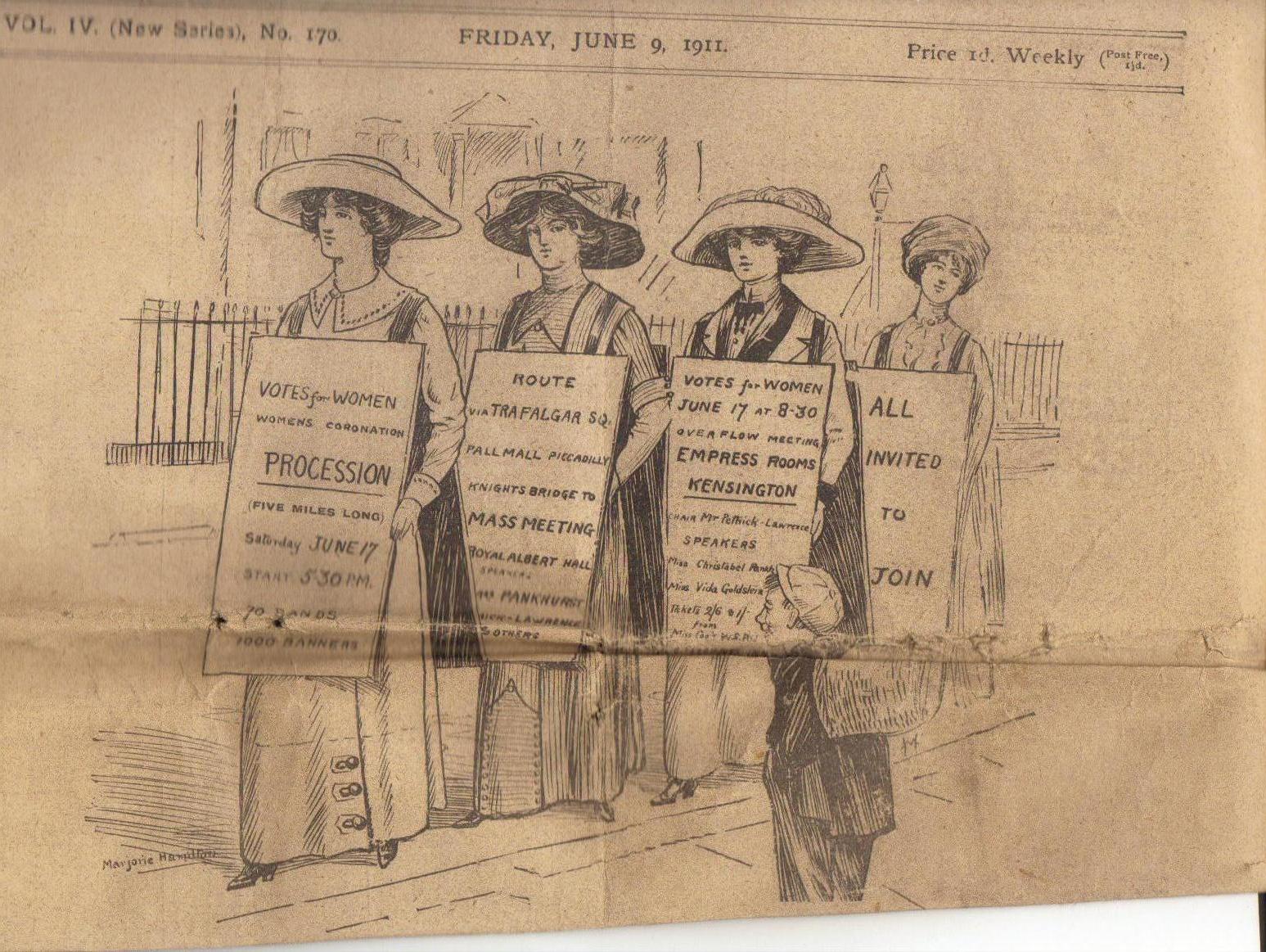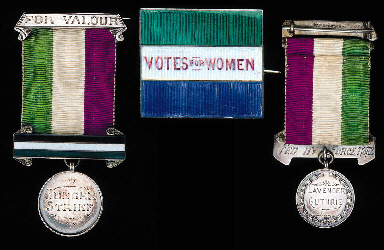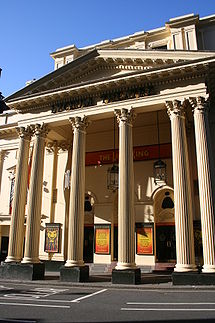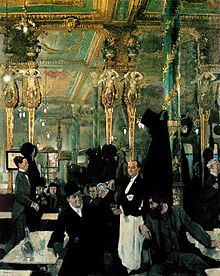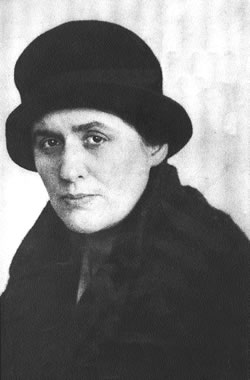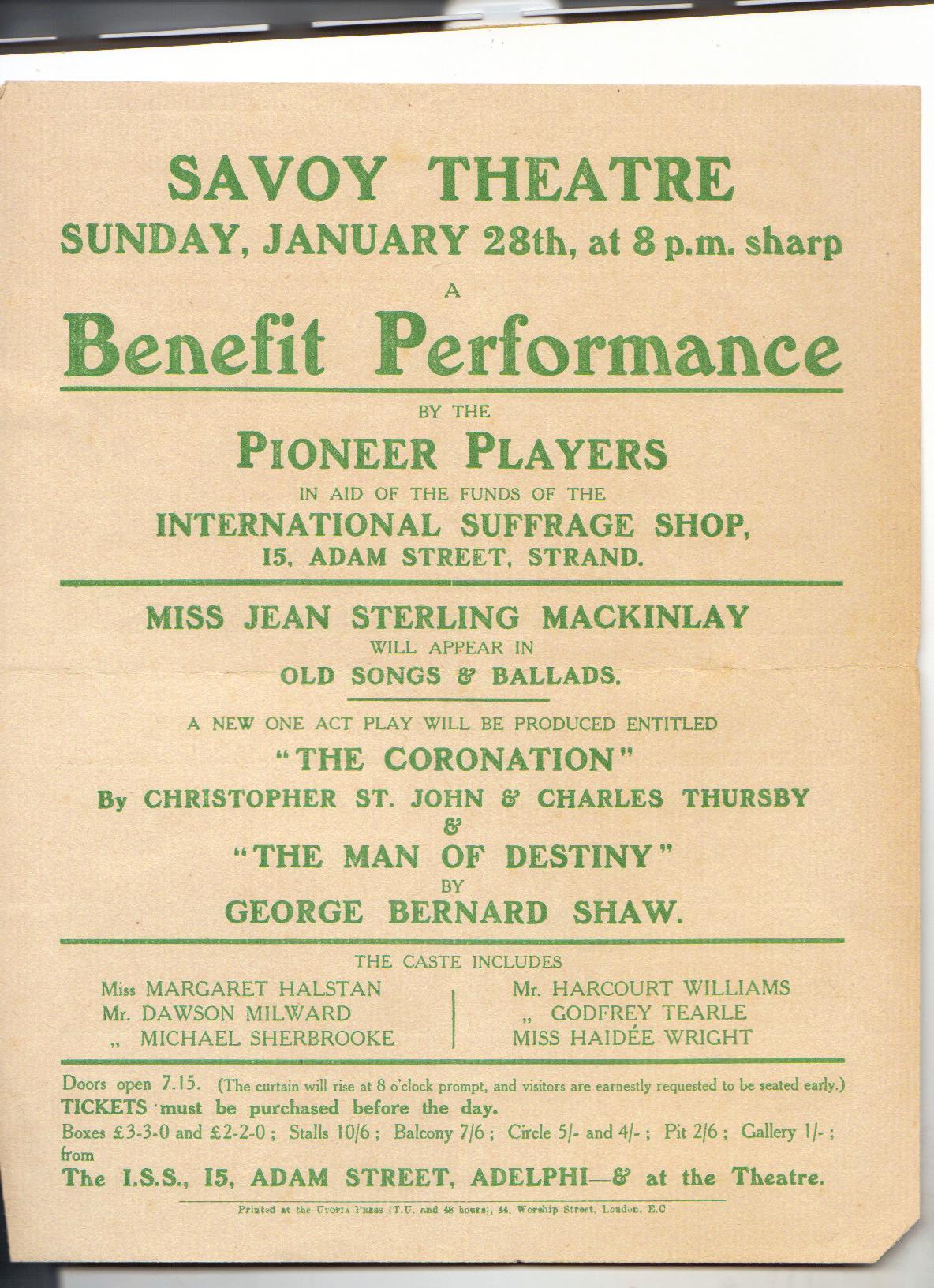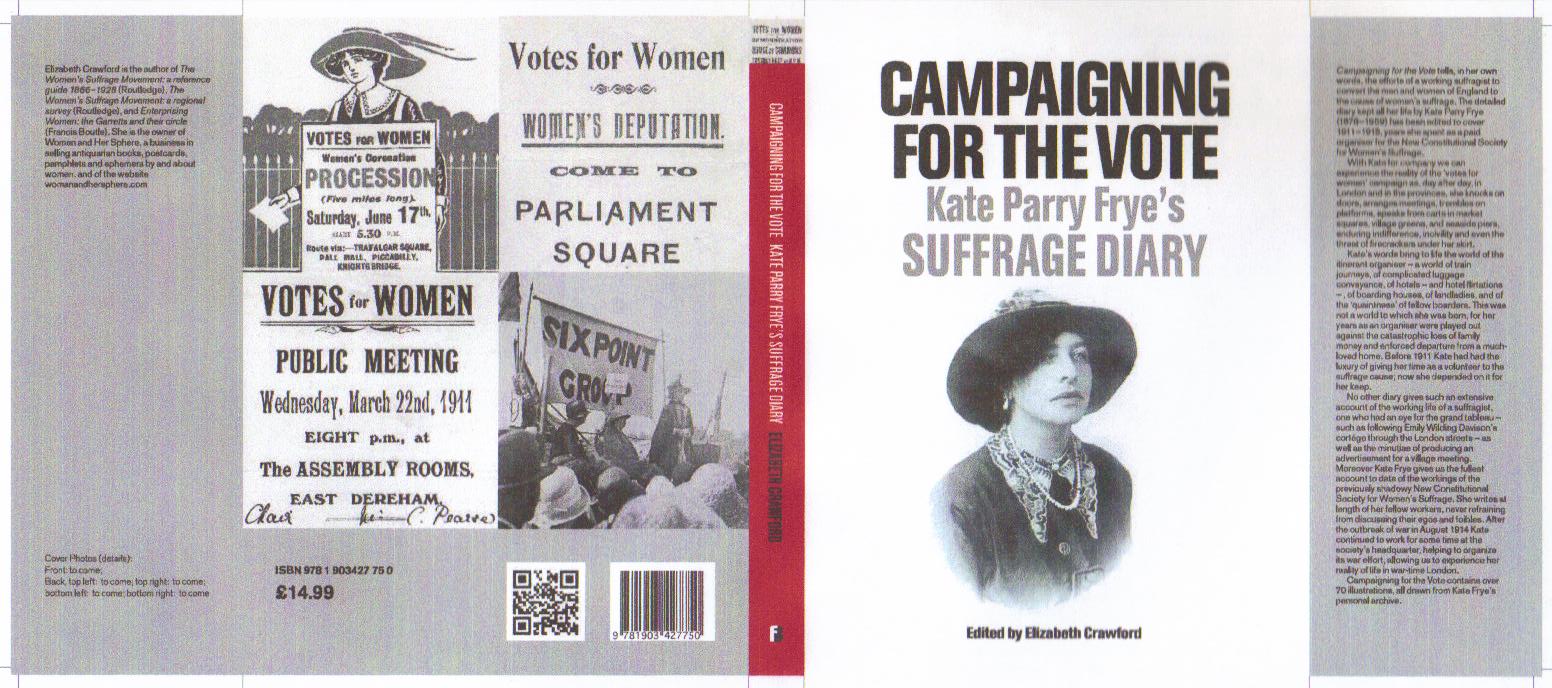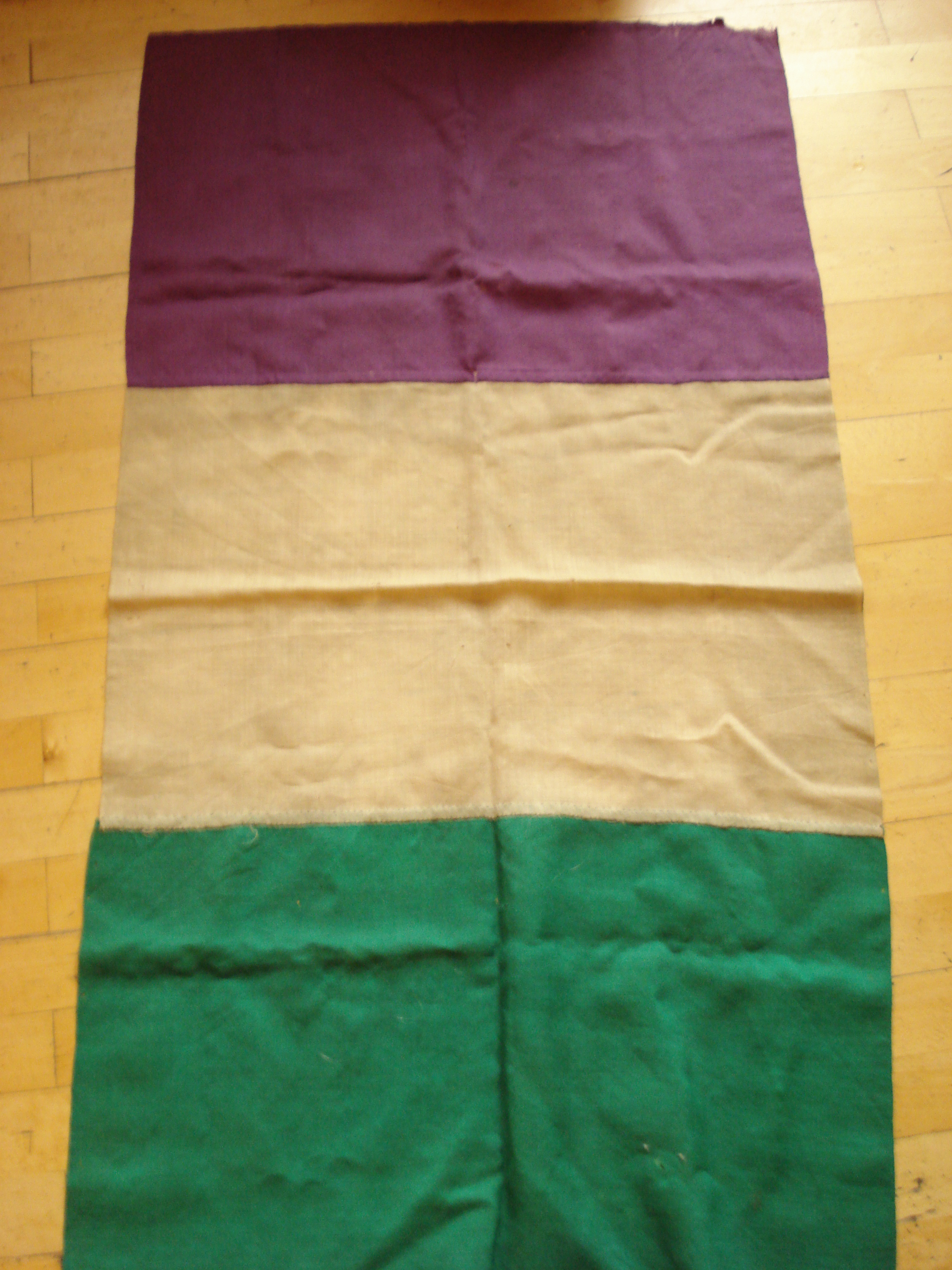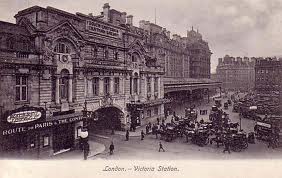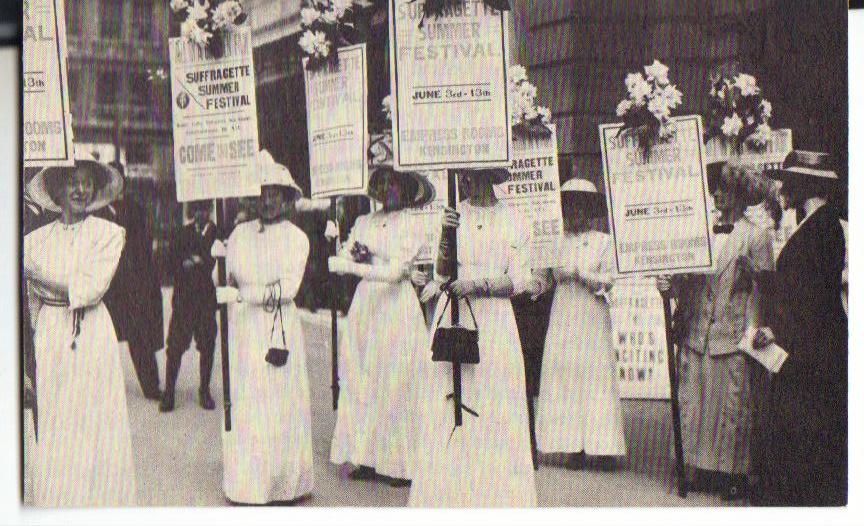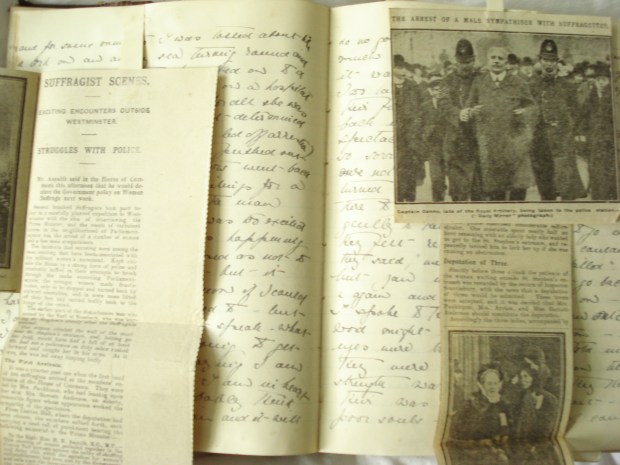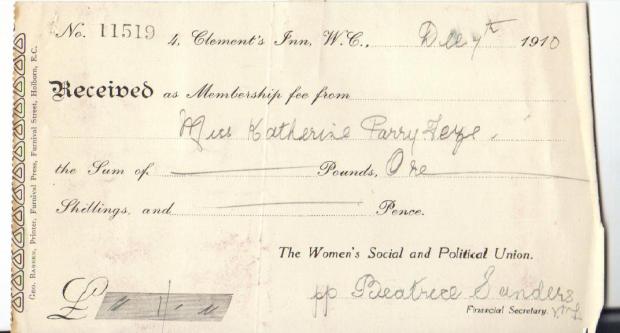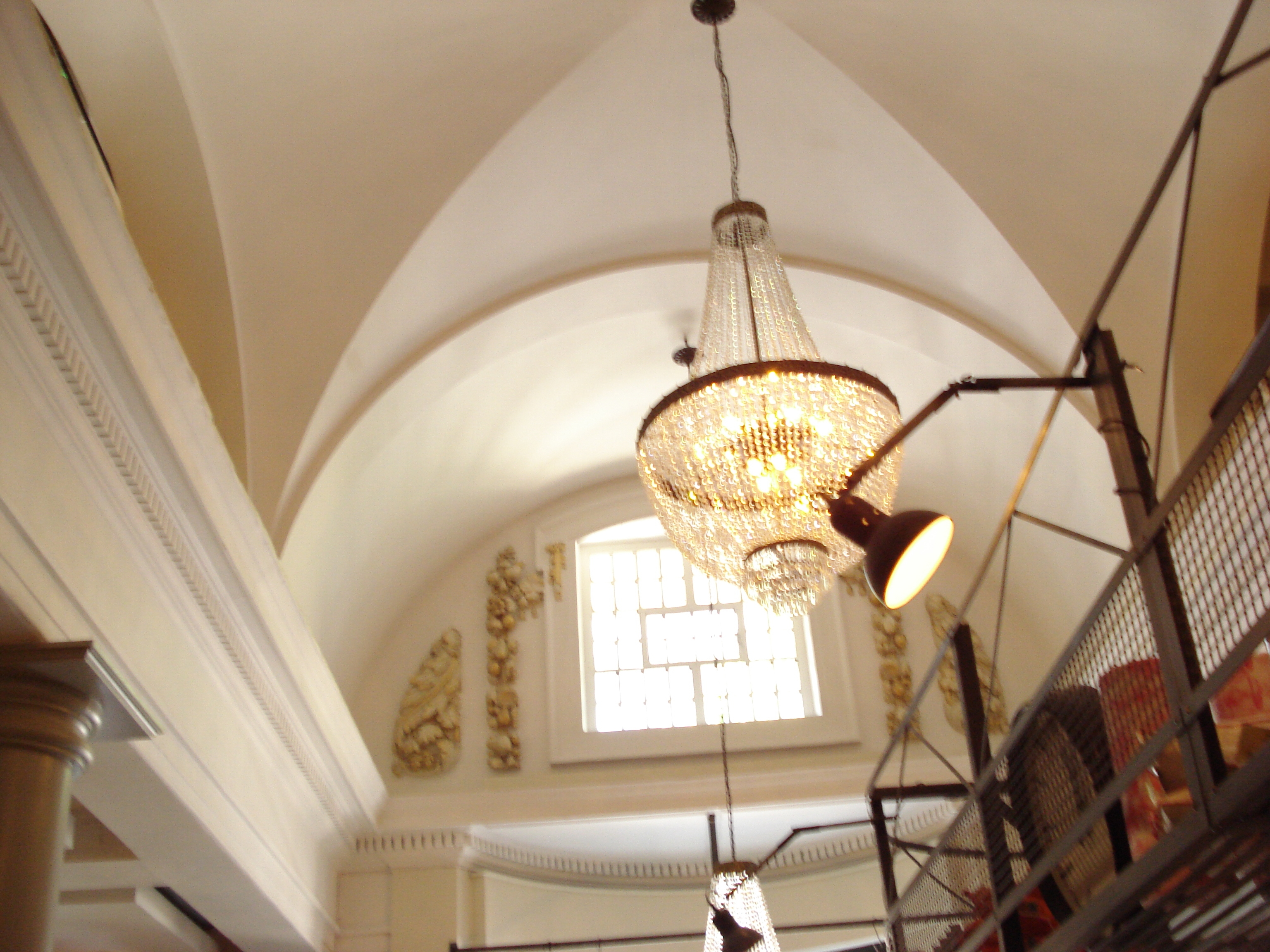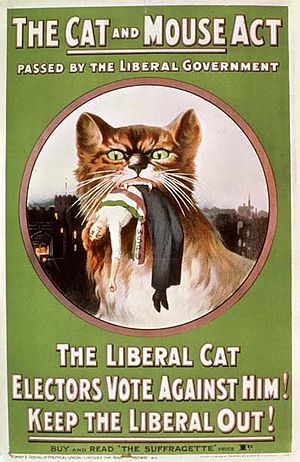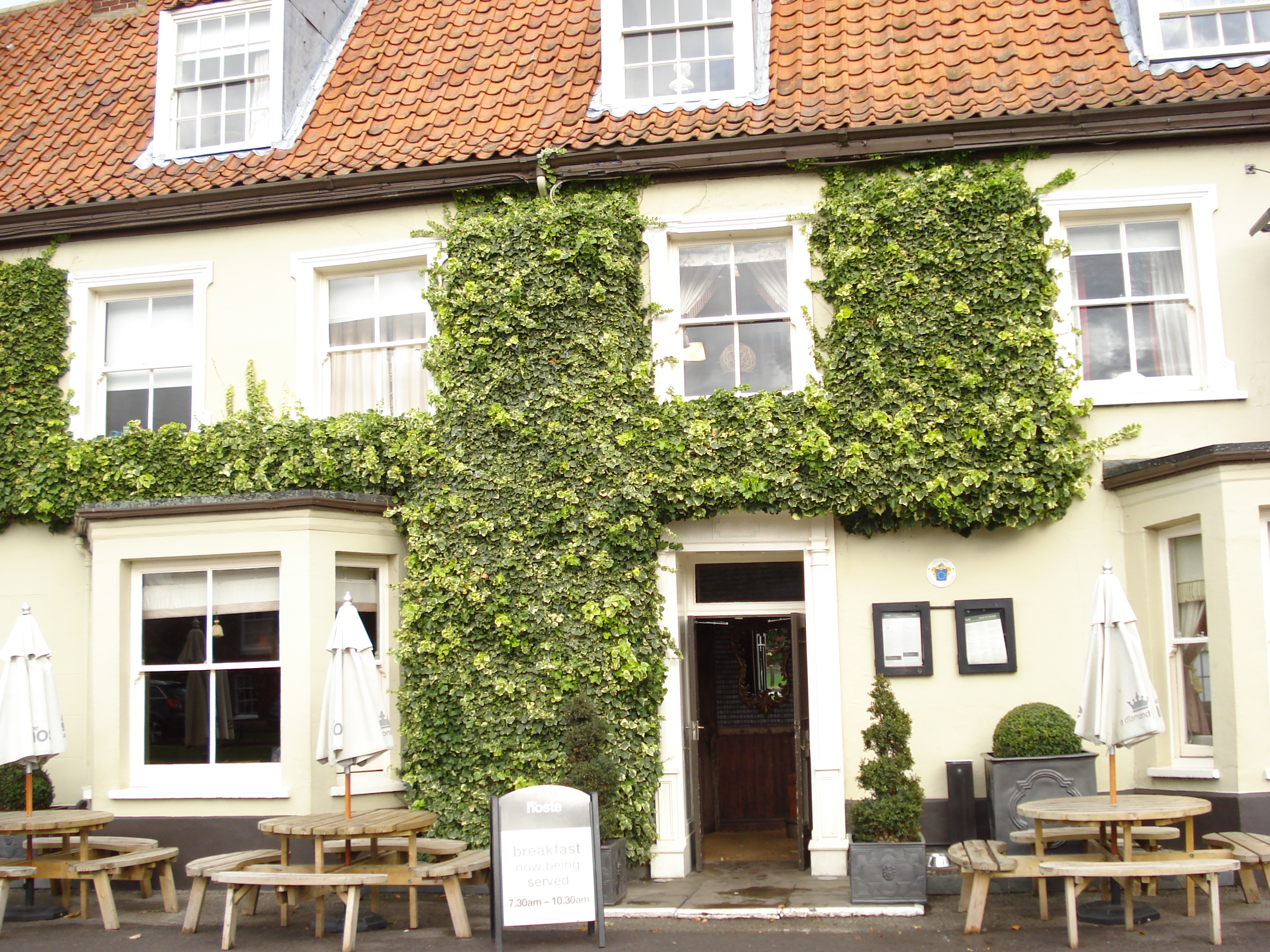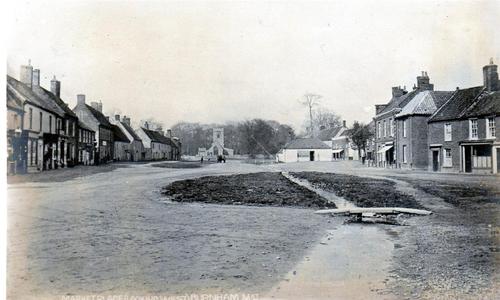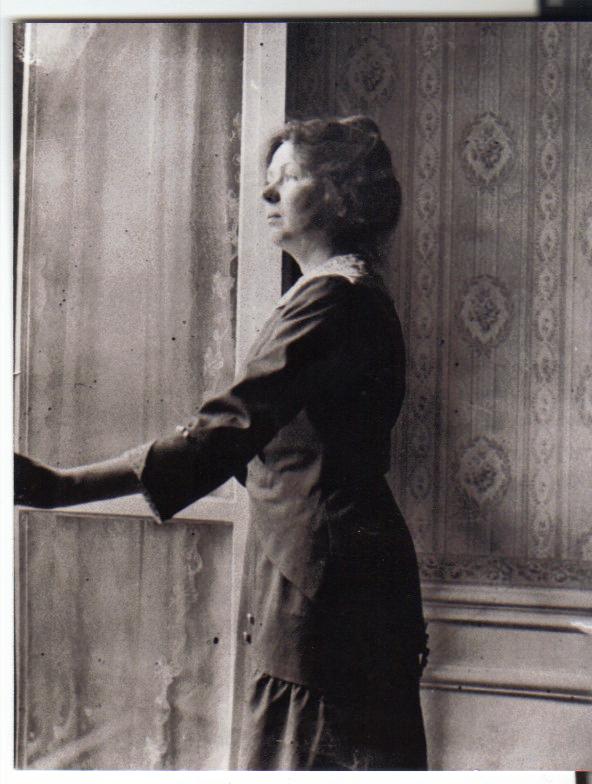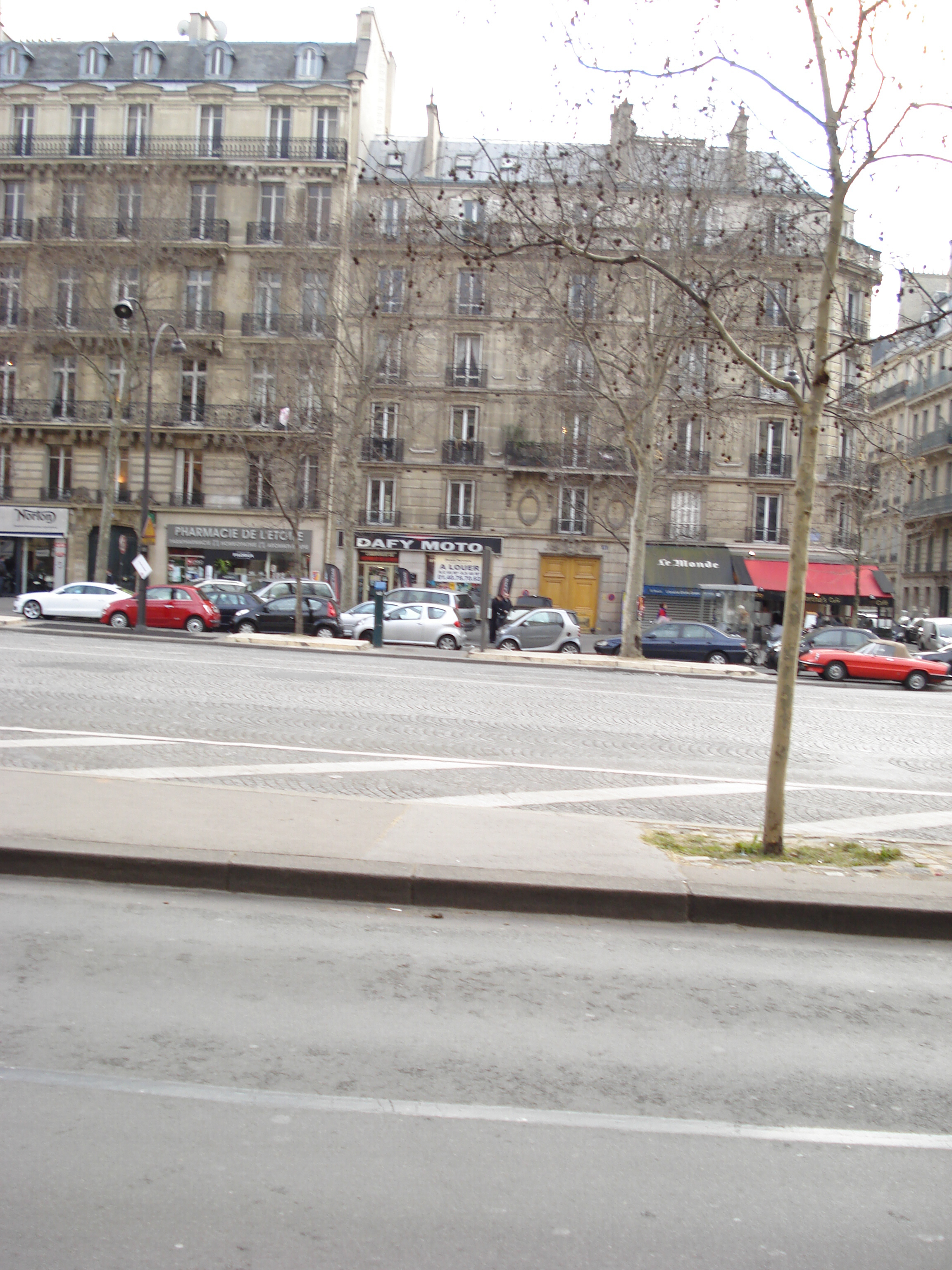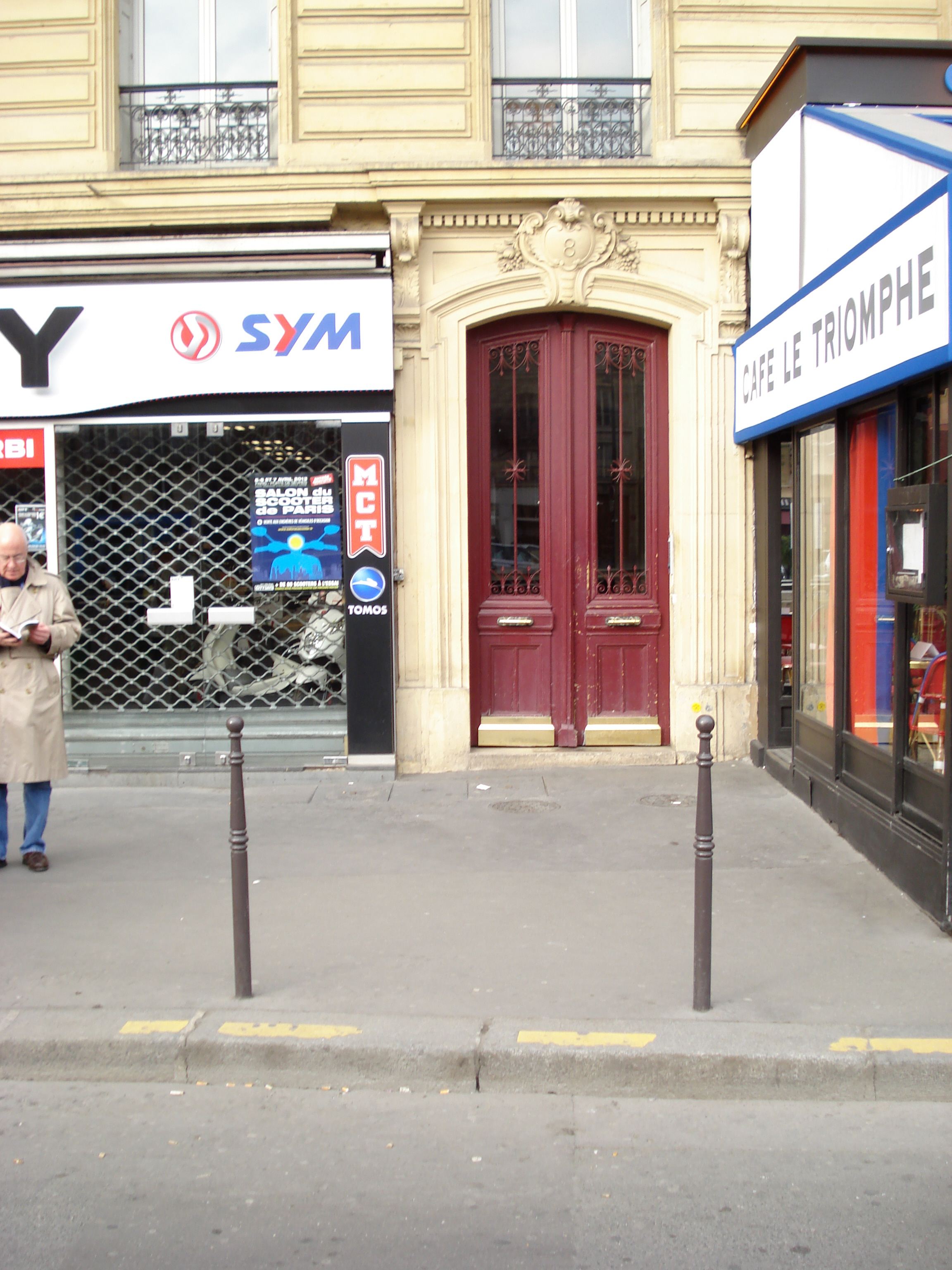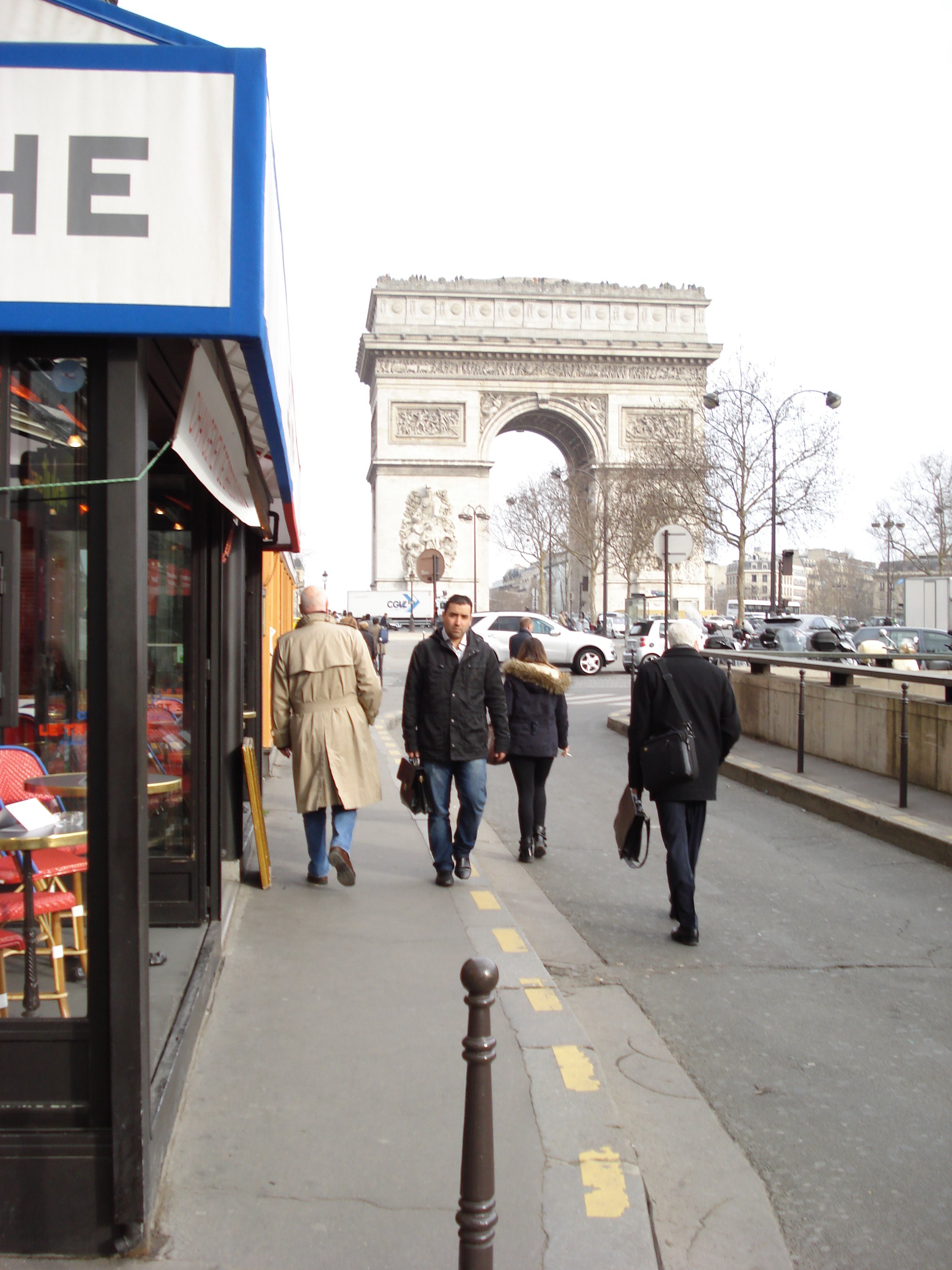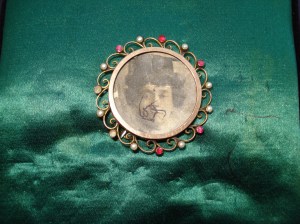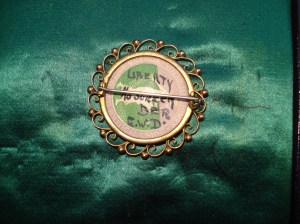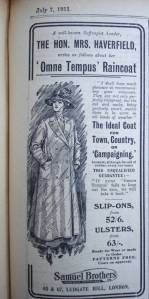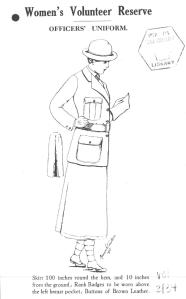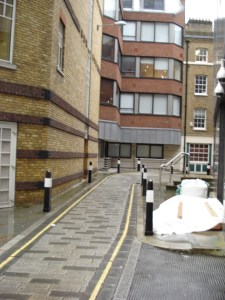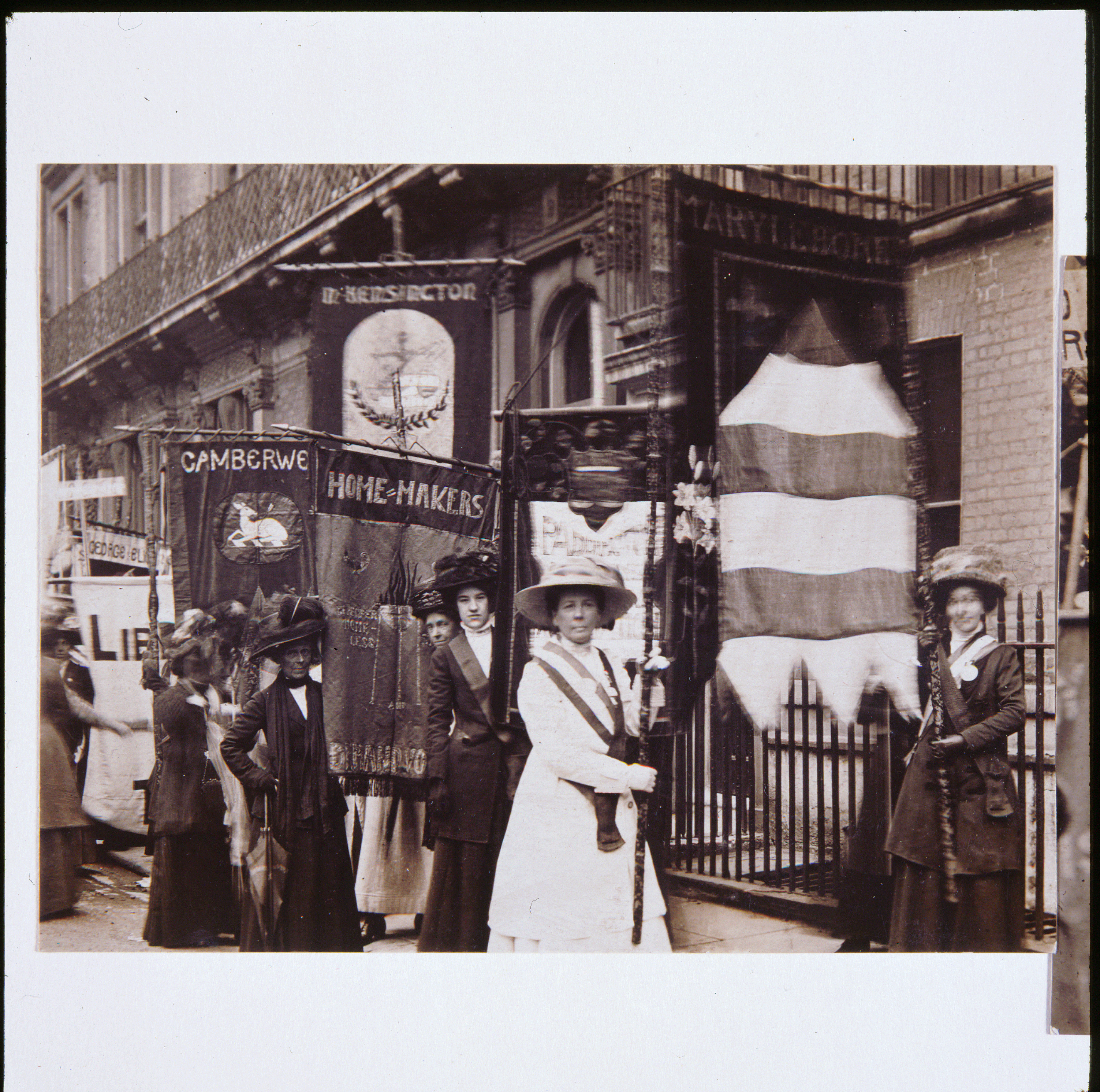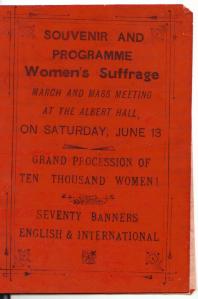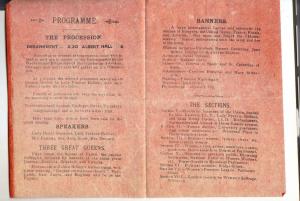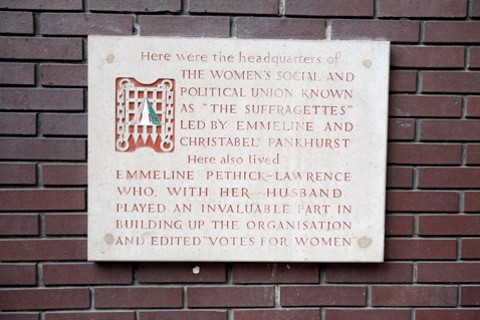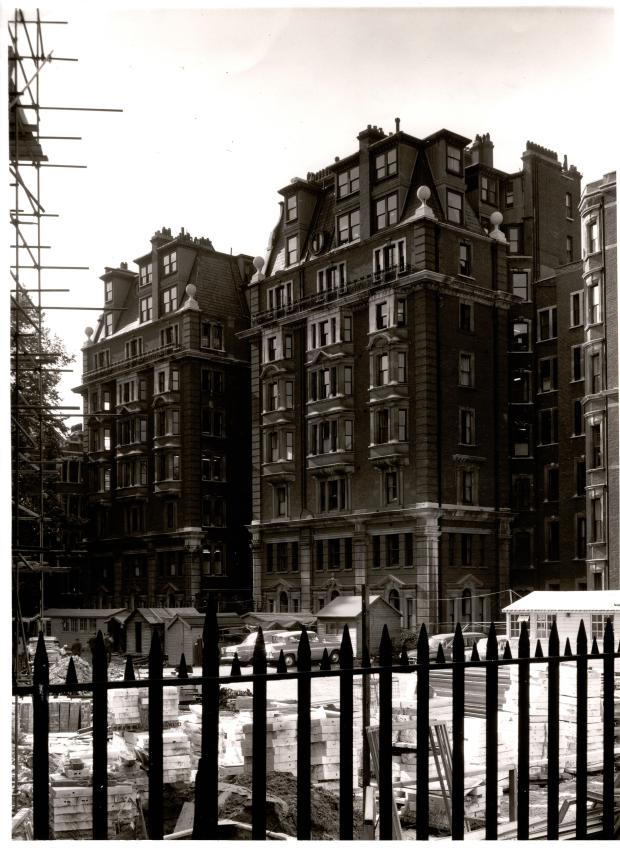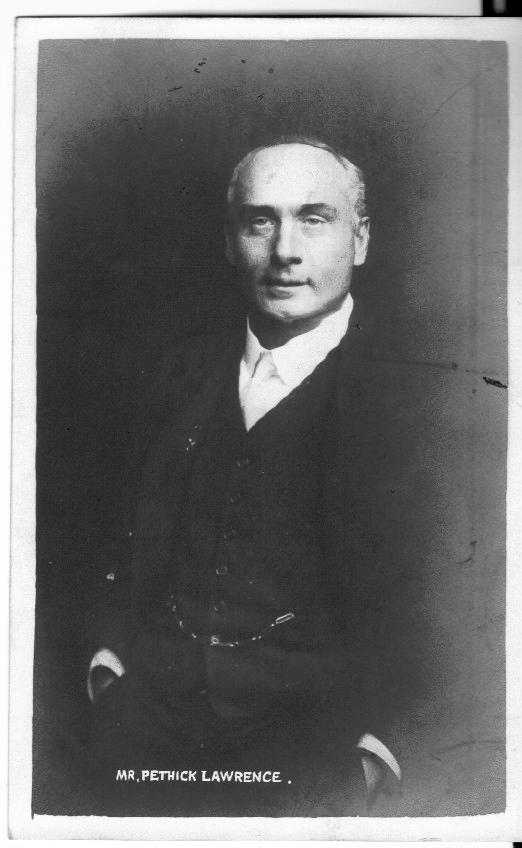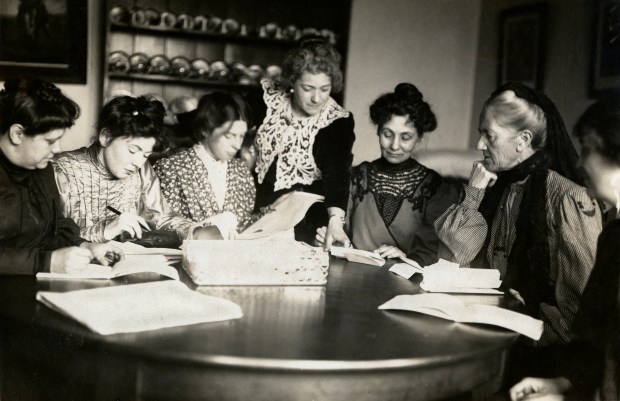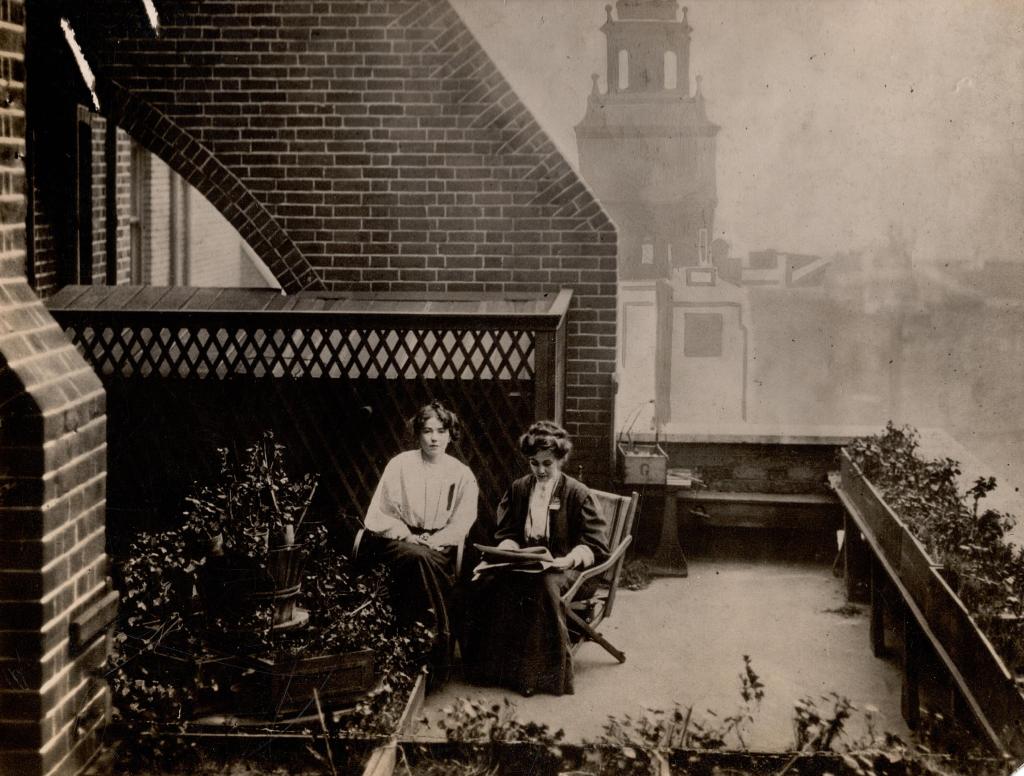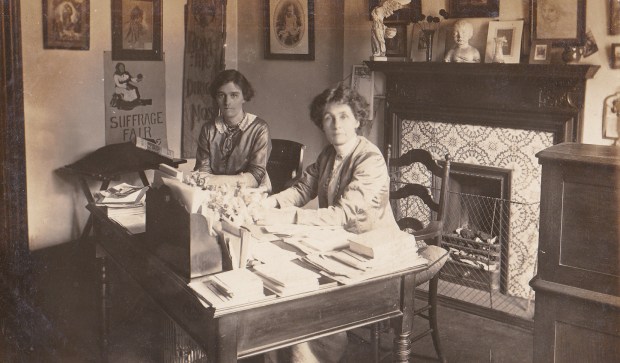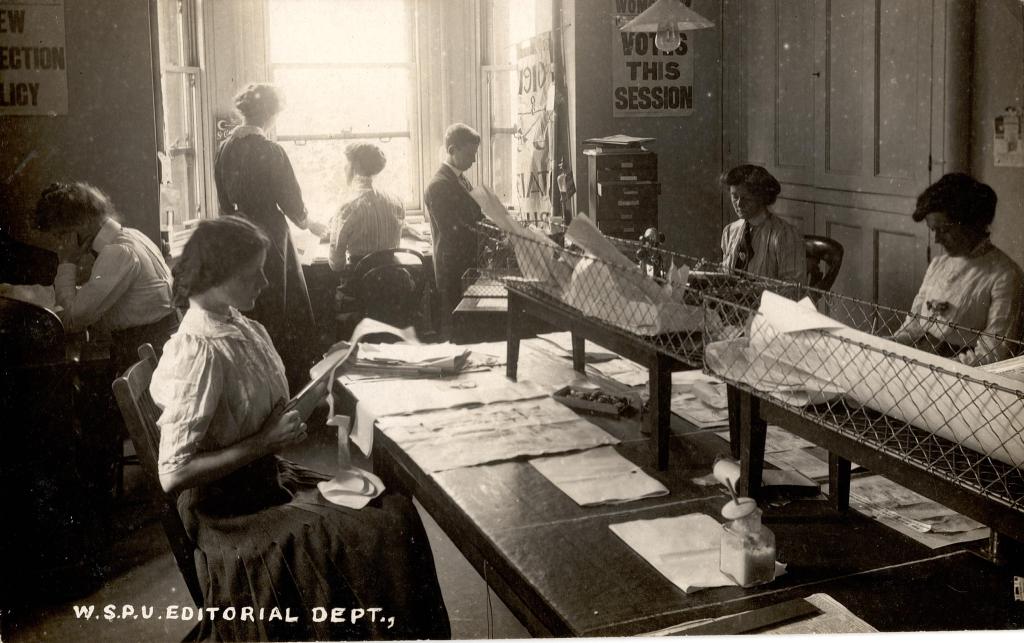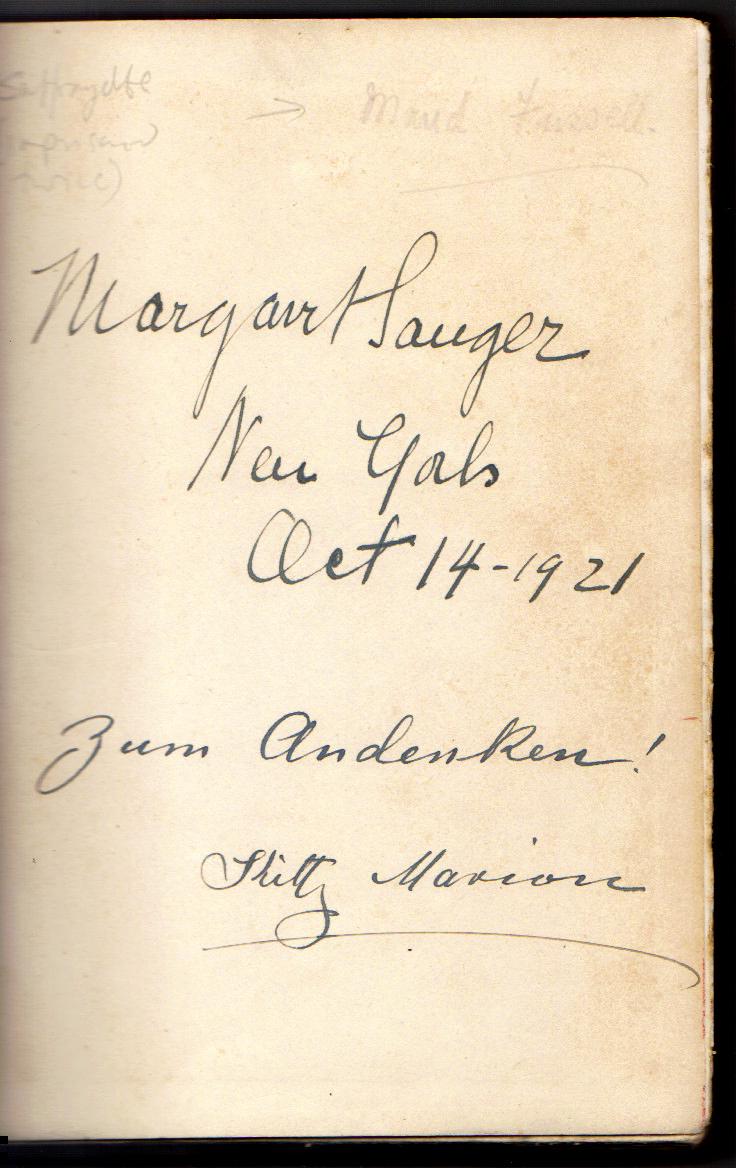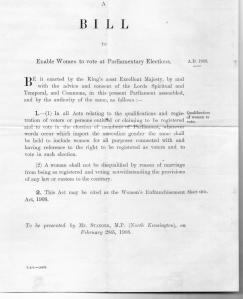Posts Tagged WSPU
Books and Ephemera By and About Women: Catalogue 211
Posted by womanandhersphere in Books And Ephemera For Sale, Collecting Suffrage, First World War on January 29, 2024
Woman and her Sphere
Catalogue 211
Elizabeth Crawford
elizabeth.crawford2017@outlook.com

See #86
With a lengthy Suffrage section at the beginning of the catalogue, Women in the First World War at the end, and all manner of women in time and space in between.
Index to Catalogue
Suffrage Non-fiction: Items 1-13
Suffrage Biography: Items 14-20
Suffrage Fiction: Items 21-22
Suffrage Ephemera: Items 23-100
Suffrage Postcards: Real Photographic: Items 101-140
Suffrage Artists’ Card: Item 141
Suffrage Postcards: Commercial Comic: Item 142
General Non-fiction: Items 143-284
General Biography: Items 285-363
General Ephemera: Items 364-401
General Postcards: Items 402-409
General (Cross=Dressing) Vaudeville Sheet Music: Items 410-417
General Fiction: 418-439
Women and the First World War: Non-fiction: Items 440-449
Women and the First World War: Biography & Autobiography 450-463
Women and the First World War: Fiction 464-468
Women and the First World War: Ephemera 469-471
Suffrage Non-fiction
1. ATKINSON, Diane Funny Girls: cartooning for equality Penguin 1997
With a foreword by Betty Boothroyd. Packed with illustrations, covering the 130 years before publication. Soft covers – very good
[15444] £6
2. BRISTOL BROADSIDES (CO-OP) Bristol’s Other History Bristol Broadsides 1984 (r/p)
Includes ‘Bristol Women in Action (1839-1919)’ by Ellen Malos and ‘People’s Housing in Bristol (1870-1939)’ by Madge Dresser. Soft covers – good/fair (one 4-pp section is present, but loose)
[15447] £4
3. CRAWFORD, Elizabeth Art and Suffrage: a biographical dictionary of suffrage artists Francis Boutle 2018
Discusses the lives and work of over 100 artists, each of whom made a positive contribution to the women’s suffrage campaign. Most, but not all, the artists were women, many belonging to the two suffrage artists’ societies – the Artists’ Suffrage League and the Suffrage Atelier. Working in a variety of media – producing cartoons, posters, banners, postcards, china, and jewellery – the artists promoted the suffrage message in such a way as to make the campaign the most visual of all those conducted by contemporary pressure groups. Mint – NEW
[15466] £20
4. KENT, Susan Sex and Suffrage in Britain, 1860-1914 Princeton University Press 1987
Fine in d/w (which has one slight nick)
[1361] £20
5. MACKENZIE, Midge Shoulder to Shoulder Alfred A. Knopf 1975
The book of the acclaimed TV series. Large format, many illustrations. Good
[15426] £10
6. NOTTINGHAM WOMEN’S HISTORY GROUP No Surrender! Women’s Suffrage in Nottingham Smallprint 2016
A local history of the women’s suffrage campaign, edited by Rowena Edlin-White. Card covers – 80pp – very good
[15465] £10
7. PHILLIPS, Dr Marion (ed) Women and the Labour Party by Various Women Writers Headley Bros, no date (1918)
Published immediately after women (some women) had won the right to the parliamentary vote. In the foreword Arthur Henderson writes ‘What practical use women will make of the political and industrial freedom they have gained this book is in part an attempt to show.’ Contributors include Mrs Sidney Webb, Margaret Llewellyn Davies, Mrs Bruce Glasier, Margaret Bondfield, Mary Macarthur, Margaret McMillan, Susan Lawrence and Rebecca West. With an introduction by Marion Phillips, Soft covers – good- with a few marginal pencil lines denoting a special interest in the paragraph
[15482] £75
8. RAMELSON, Marian The Petticoat Rebellion: a century of struggle for women’s rights Lawrence & Wishart 1972
An interesting history of the women’s movement, written from a left-wing angle. Paper covers – ex-university library
[1592] £3
9. REID, Marion A Plea for Woman Polygon 1988
First published in 1843. Paper covers – fine
[4001] £8
10. ROVER, Constance Love, Morals and the Feminists Routledge 1970
Good in d/w – though ex-library
[4552] £5
11. STRACHEY, Ray Women’s Suffrage and Women’s Service: the history of the London & National Society for Women’s Suffrage London & National Society for Women’s Suffrage 1927
A very useful history of the society that was at the core of the constitutional suffrage movement.With 10 interesting photographs – I particularly like the one of the Library at Women’s Service House. 38pp. Original pictorial cover -38pp – in fine condition
[15527] SOLD
12. SWANWICK, H.M. The Future of the Women’s Movement G. Bell 1913
Helena Swanwick (1864-1939) was educated at Girton and became a lecturer in psychology at Westfield College, University of London. After her marriage and move to Manchester she wrote for the ‘Manchester Guardian’ and eventually became editor of the newly-Lauched NUWSS paper, ‘The Common Cause’. With a foreword by Millicent Fawcett. Good – cover rubbed.. Scarce
[15505] £95
13. WATKINS, Cliff Votes for Women: the struggle for women’s suffrage nationally and in and around Beckenham 1867-1929 Beckenham Suffragette Centenary Group 2003
Soft covers – 28pp – many illustrations – fine – scarce
[15446] £10
Suffrage Biography
14. (BECKER) Audrey Kelly Lydia Becker and The Cause Centre for North-West Regional Studies, University of Lancaster 1992
A brief study of Lydia Becker, leading 19th-c Manchester suffragist. Soft covers – mint – scarce
[15443] £12
15. (BENETT) Iain Gordon Rebel With a Cause: The life and times of Sarah Benett (1850-1924), social reformer and suffragette Pen and Sword 2018
A biography drawing on Benett’s private papers and prison memoir to recount the life of a social reformer who, middle-aged, was a militant activist member of the WSPU. Mint in d/w
[15424] £12
16. (COOPER) Jill Liddington The Life and Times of a Respectable Rebel: Selina Cooper, 1864-1936 Virago 1984
Paper covers – very good
[1153] £10
17. (DUNIWAY) Ruth Barnes Moynihan Rebel for Rights: Abigail Scott Duniway Yale University Press 1983
Abigal Scott Duniway (1834-1915), American suffragist, journalist, and national leader. Fine in d/w
[1205] £5
18. (MILL) John Stuart Mill Autobiography Longmans, Green 1873
First edition in original green cloth. Internally very good – a little wear at top and bottom of spine
[14974] £75
19. (PANKHURST) David Mitchell Queen Christabel: biography of Christabel Pankhurst MacDonald and Jane’s 1977
Good in d/w – ex-library, free front end paper removed
[11623] £6
20. (WEBB) Richard Harrison Richard Davis Webb: Dublin Quaker Printer (805-72) Red Barn Publishing 1993
Webb was a committed anti-slavery campaigner, whose family were very involved in the Irish women’s suffrage campaign. A brief biography. Soft covers – very good condition
[15066] £8
Suffrage Fiction
21. GRAY, LESLEY The King’s Jockey Solis Press 2013
A novel centring on the life of the jockey who was riding the King’s Horse at the 1913 Derby, colliding with Emily Wilding Davison. Soft covers – fine condition
[15065] £5
22. LUCAS, E.V. Mr Ingleside Methuen, 15th ed, no date 1910/1912?)
A novel with suffrage scenes. Only a reading copy – cloth worn – backstrip loose
[14132] £4
Suffrage Ephemera
23. [1909 29 JUNE] WSPU A DEPUTATION OF WOMEN WILL GO TO THE HOUSE OF COMMONS ON TUESDAY, JUNE 29TH AT 8 O’CLOCK TO SEE THE PRIME MINISTER WSPU 1909
and lay before him their demand for the Vote. The right to do this is secured to them by the Bill of Rights….’ In the event many women were arrested, although most of them had their cases adjourned ‘sine die’. Some, charged with stone throwing, were imprisoned and were some of the first women to go on hunger strike in Holloway. The case of Mrs Pankhurst and Mrs Evelina Haverfield, judged to be the leaders of the protest and who pleaded their protest was within the terms of the Bill of Rights, was adjourned until the end of the year. Flyer, printed by St Clement’s Press, Portugal Street, in black on white paper. In fine condition – extremely scarce
[15494] £350
24. ARE WOMEN CITIZENS? NUWSS no date [1909/1910]
Double-sided leaflet published by the National Union of Women’s Suffrage Societies. The answer to the question ‘The law says Yes! when they are required to pay the taxes. The law says No! when they ask to vote.’ etc. Included in the leaflet was in invitation to join the NUWSS. As the society declared ‘Its weapon is public opinion.’ Good – a little browning around the edges -slight nick at edge where it was once folded – Scarce
[15540] £65
25. BAKER, Hatty Women in the Ministry C.W. Daniel 1911
She was hon sec of the Free Church League for Women’s Suffrage and here ‘examines the prejudice which excludes women from the ministry of the Nonconformist or Free Churches, and claims this sphere of labour as a legitimate extension of the already enlarged field of woman’s activity’. The Free Church League for Women’s Suffrage was founded in 1909 with the aim of securing both the female vote and the admittance of women into the clergy.Paper covers – 60pp of text plus 16 pp of publisher’s advertisements. In generally good condition – back cover fragile at spine – but still attached. Very scarce
[15532] £85
26. BALFOUR, THE RT HON A.J., M.P. Speech in the House of Commons on Women’s Suffrage 1892 London Society for Women’s Suffrage
The speech closed the debate of the Second Reading of Sir Albert Rollit’s private member’s franchise bill, which narrowly failed to pass. The speech was originally printed by the Central Society for Women’s Suffrage, so this is a later printing with the society now renamed the LSWS. As the address for the LSWS is given as 58 Victoria Street, this would indicate that it was issued in 1910 or after. Interesting that the speech still had resonance nearly 20 years after it was given. In fact, the pamphlet bears the stamp of the Women’s Freedom League – and, faintly in pencil, is marked ‘To be kept’. Paper covers – 8pp – – the leaves are separate, as the holding staple has failed.
[15526] £55
27. BRAILSFORD, H.N. The Conciliation Bill: and explanation and defence The Woman’s Press probably 1910
Brailsford, journalist and active suffrage supporter, explains the Conciliation Bill – and which women it would enfranchise. Paper covers are fragile, internally good – 15pp – scarce
[15535] £65
28. CAZALET, Thelma Mrs Pankhurst
An article about Mrs Pankhurst by Thelma Cazalet (MP for Islington East) in ‘The Listener’ (6 Nov 1935) in a series ironically titled ‘I Knew A Man’. See also item ??. A 4-pp article – including photographs. The late-lamented ‘The Listener’ was a substantial journal in those days – this issue is 55 pages – in goodish condition – the front page is present but detached.
[14454] £20
29. CAZALET-KEIR, Thelma I Knew Mrs Pankhurst Suffragette Fellowship c 1935
Pamphlet published by the Suffragette Fellowship, reproduced from an article the author had written for the ‘Listener’ (6 Nov 1935). 8-pp pamphlet – very good condition
[15496] £95
30. CLAYTON, Joseph Militant Methods in History The Woman’s Press no date [1911]
With an introduction by H.W. Nevinson. The British Library catalogue dates this WSPU pamphlet to 1913, but my research shows it was first published in March 1911, having first appeared as a series of articles in ‘Votes for Women’. Paper covers – 36pp -in very good condition internally, the front cover marked (a splash of tea?). The free front endpaper bears the handwritten message ‘To Mrs Rose with kind regards from Joseph Clayton’
[15486] £90
31. DESPARD, Charlotte Woman’s Franchise and Industry Women’s Freedom League no date [1910]
‘The Political Emancipation of WOmen as it will affect Industry – is of the most far-reaching importance.’ Paper covers, with photograph of Mrs Despard – 12pp – very good – scarce
[15542] £85
32. FAIRFIELD, Zoe The Woman’s Movement Student Christian Movement 1913
Zoe Fairfield (1878-1936), a cousin of Rebecca West, was for 20 years from 1909 assistant general secretary of the Student Christian Movement. She was a suffrage supporter and this item reprints four articles on the subject of the women’s movement, discussing women’s work (and wages), public morality, women and Christianity, and female missionary work that first appeared in ‘The Student Movement’ magazine in early 1913. Soft covers -36pp – good – scarce
[15546] £75
33. FEMINIST ART NEWS vol 2 number 1 Women in the Arts in Britain 1900-1910 FAN Business Collective 1988?
FAN was led by Jane Beckett and Deborah Cherry, who contribute an article on Art, Class and Gender 1900-1910 to this issue. Other articles are by Lisa Tickner on ‘images of femininity in the Edwardian women’s suffrage campaign’, Ziggi Alexander on ‘Black Entertainers 1900-1910’. Cheryl Buckly on ‘Women in the Edwardian Pottery Industry’, Sarah Harvey on Caroline Townshend and Magdalen Evans on Mariaanne Stokes. Soft covers – very good – withdrawn from London Guildhall University Library – scarce
[15463] £12
34. FLAPPERS: Casual Letters vol IV James Dunning & Co Ltd May 1928
Published in an idiosyncratic series of ‘Casual Letters’, these are the thoughts of a City gentleman, perhaps James Dunning himself. A ‘sometimes flippant’ look at the forthcoming change in the Franchise. It’s always worth investigating popular attitudes to ‘Women’. Good – paper covers – 26pp – decidedly uncommon
[15521] £10
35. HARDIE, J. Keir The Citizenship of Women: a plea for woman’s suffrage. With an appendix by Miss Clara Collet Women’s Freedom League [1908?]
Hardie’s essay was first published in 1905; this is a reissue by the Women’s Freedom League, the suffrage society most supportive of the Independent Labour Party. It is a little difficult to decide exactly when it was issued by the WFL but it bears the 1, Robert Street address suggesting it was no earlier than 1908. Paper covers marked- 12pp – good internally
[15537] £65
36. HARRISON, Ethel B. The Freedom of Women: an argument against the proposed extension of the suffrage to women Watts & Co 1908
Ethel Harrison (1851-1916) was the wife of Frederic Harrison, lawyer, political Radical, and supporter of trade unionism. She was a member of the Women’s National Anti-Suffrage League and this polemic is interesting, putting forward in an unhysterical way the arguments of those women who did not wish to be enfranchised. Paper covers – 60pp – good – scarce
[15533] £85
37. INTERNATIONAL WOMAN SUFFRAGE CONGRESS
Budapest June 15-20 1913. This is a small advertising paper label/stamp (it has a sticky back) for the Congress – showing two graceful women stretching their arms, to hold hands across the globe. The type-face is very 1913. A pretty and interesting memento of the last pre-war international women’s gathering. Fine -amazingly ephemeral – and unusual. With the background printed in blue
[14505] £85
38. JOHNSTON, Thomas The Case for Woman’s Suffrage and Objections Answered Forward Printing and Publishing Co (Glasgow) no date [1907]
Johnston founded ‘The Forward’, a socialist newspaper, in 1906 – and on the back page of his pamphlet claimed ‘Forward’ is the only paper in Scotland wholeheartedly supporting the Women’s Movement’. Johnston was a Fabian and a member of the Independent Labour Party. Paper covers – 16pp – marked in ink on the cover ‘For Review’. Very good – scarce
[15543] £85
39. L’UNION FRANCAISE POUR LE SUFFRAGE DES FEMMES La Charte de la Femme 1910
par Jean Finot suivie d’une Enquete sur le Vote Politique des Femmes en France. 60 pp – fair – paper covers present but detached
[13192] £8
40. LYTTON, Lady Constance ‘No Votes for Women’: A Reply to Some Recent Anti-Suffrage Publications A.C. Fifield March 1909 (reprint)
She uses wry humour to demolish the various tropes about women that were being propounded by the Anti-Suffrage League, founded in mid-1908. The pamphlet was first issued on 12 February 1909 and proved so popular that it was reprinted on 10 March 1909. Paper covers carry listings of other suffrage works available and note the societies and bookshops at which the pamphlet was sold. Front cover has pencilled references and other marks- and damage to lower edge -36pp – internally very good. Scarce
[15538] SOLD
41. MCLAREN, Lady ‘Better and Happier’: An Answer from the Ladies’ Gallery to the Speeches in Opposition to the Women’s Suffrage Bill, February 28th, 1908 T. Fisher Unwin 1908
I have always been rather an admirer of Laura McLaren and her straight-forward prose. 46-pp – paper covers a little marked – but good and tight. Scarce
[15492] £120
42. MAXSE, THE HON MRS IVOR ‘Votes for Women’ The ‘National Review’ Office 1908
[Suffrage activists] ‘have shown by their agitation that they do not understand the reason for which the vote has been given to men, or the true nature of that vote, or, lastly, the effect of this great extension of the franchise on the country and the Empire generally; She was Mary Maxse (1870-1944), niece of Lord Rosebery, wife of a general – and, as you can tell, an Anti. Paper covers – 16 pp – very good – scarce. This copy bears the stamp of the International Suffrage Shop, 15 Adam Street, Strand, W.C.’
[15530] £65
43. MEN’S LEAGUE FOR OPPOSING WOMAN SUFFRAGE Speeches by Lord James of Hereford and Lord Curzon of Kedleston at a Dinner of the Council on Tuesday, the 18th of May, 1909 MLOWS 1909
Interestingly, this copy bears the rubber stamp of ‘The International Suffrage Shop, 15 Adam Street, Strand, W.C.’ -showing that the shop did not only stock pro-suffrage material. James was a lawyer and politician who, incidentally, had in 1886 represented Dilke in the Crawford divorce case, giving, according to Roy Jenkins, ‘some of the worst professional advice that a man can ever have received’. Curzon, former viceroy of India, in 1912 became president of the National League for Opposing Women’s Suffrage (which had been formed in 1910 as a result of the amalgamation of MLOWS with the Women’s National Anti-Suffrage League). 12pp – good condition – scarce
[15528] £75
44. MINUTE BOOK OF THE PORTISHEAD SOCIETY OF THE NATIONAL UNION OF WOMEN’S SUFFRAGE SOCIETIES
This Somerset society was founded at a meeting held at Clarence House, home of Mrs Hall, the society’s president, on 16 December 1913. It was a member of the West of England Federation of the NUWSS. The society is particularly interesting as it continued in existence throughout the First World War, the Minute Book revealing not only local activities, but also the society’s reaction to the actions of Headquarters. For instance, we can follow the discussions that led to the society declining to support NUWSS representation at the Women’s Peace Conference held at The Hague and those that surrounded the machinations around the proposal to extend the franchise. Besides reports of meetings, the Minute Book lists the names of Portishead members, with their addresses. It also lists details of the parliamentary candidates, the halls that can be hired, printers that can be used (with their prices) – plus the political affiliations of numerous local residents, together with the names and addresses of other ‘People to Call On’. In May 1918 the members of the society appear to have created a Women’s Citizen Association, and then, in Jan 1919, after some debate, decided to stay in existence as an NUWSS society. The exact course of events at this rather febrile time might take some unravelling..
Presumably it was the secretary, Miss Butterworth, who selected a school exercise book to use as a Minute Book, strengthening one cover with board. Very few such Minute Books, so ephemeral in appearance, survive. And yet this Minute Book is an excellent primary source, containing a wealth of information, throwing light on the activities and opinions of a section of the female population in the years 1913-1919. As such it is of national as well as local importance. In good condition, with a number of cyclostyled letters and resolutions laid in. Unique
[15524] SOLD
45. MISS ALICE SCHOFIELD (Organiser) Women’s Freedom League WFL
An early WFL card – the address printed on the card is 18 Buckingham Street, Strand (ie before the move to 1 Robert St in 1908). Alice Schofield, influenced by Teresa Billington, had been a very early member of the WSPU, but with Teresa left the WSPU in 1907 and by 1908 was a paid WFL organizer. A postcard from the Postcard Album compiled by Women’s Freedom League members Edith, Florence and Grace Hodgson.. A scarce card – in fine unposted condition
[14554] £120
46. MISS EMILY FAITHFULL
studio photograph by W & D Downey, 57 & 61 Ebury Street, London, together with a printed brief biography.
[14029] £40
47. MISS MORGAN, OF BRECON The Duties of Citizenship Women’s Local Government Society c 1912
Extracts reprinted from a paper read at the Annual Conference of the National Union of Women Workers, Manchester, October 27th 1896. By the time this leafet was issued Miss Morgan had been Mayor of Brecon, 1911-12. 4-pp – good – withdrawn from the Women’s Library
[13833] £5
48. MRS DESPARD
portrait photograph by Lena Connell, 50 Grove End Road, NW – mounted on stiff brown card – published by The Suffrage Shop, the card embossed with the shop’s monogram. This once belonged to Joan Wickham. Fine
[15159] £120

Item # 49
49. MRS PANKHURST’S STATUE -CARTOON BY ‘CUMMINGS’ 1955
Artwork for an original ink cartoon by the cartoonist ‘Cummings’, showing Mrs Pankhurst’s statue, her face notably outraged, being manhandled by Nigel Birch, who in 1955 was the Minister of Works in the Conservative Government.
The cartoon alludes to the plan by the Ministry of Works to move Mrs Pankhurst’s statue in Victoria Tower Gardens (adjacent to Parliament) from its original site, where with great ceremony it had been unveiled on 6 March 1930. During a debate in the House of Commons on 28 June 1955 Nigel Birch, as Minister of Works, revealed that he had met with members of the Suffragette Fellowship, who objected fiercely to the proposed new site, demanding that if the statue were to be moved it should only be to a position even closer to Parliament. The Suffragette Fellowship kept up their campaign, lobbying and writing letters to the press (eg The Times,30 Aug 1955), until their wish was granted – and Mrs Pankhurst’s statue was moved to its current site and re-dedicated at a ceremony held on 14 July 1956. The Minister of Works was present on that occasion, but by then was no longer Nigel Birch, who in December 1955 had moved to the Ministry of Air, as Secretary of State. My belief is that the cartoon dates from the period June-December 1955 when Birch was still at the Ministry of Works.
‘Cummings’, the celebrated cartoonist, was Michael Cummings (1919-1997), who in the 1955 was working for the ‘Daily Express’ newspaper and for the ‘Essence of Parliament’ column in ‘Punch’. From the style of the ‘Statue’ cartoon I would think it might have been offered to ‘Punch’, rather than to the ‘Daily Express’. ‘Punch”s ‘Essence of Parliament’ column did indeed, in the autumn of 1955, refer to the controversy over the proposed moving of the statue in the autumn, but the short article was not illustrated with a cartoon. The explanation for the fact that the cartoon is available – ie not included in a newspaper/journal archive (such as that of ‘Punch’) – as it probably would be if it had been published- may be that it was not used by the journal to which it was offered. It is recorded that Cummings would later offer the ‘Sunday Express’ as many as five or six ideas for a -cartoon when only one was required.
The cartoon is a delightful comment on an event that those with an appreciation of suffrage history will relish – commemorating as it does the dedication of surviving friends and supporters of Mrs Pankhurst who, as Mrs Jean Mann, MP for Coatbridge stated in a further House of Commons debate. 15 Nov 1955, ‘do not like the idea of this noble lady being pushed around…’This cartoon is the only visual comment I have ever seen of the 1955 contretemps.
There was, of course, another attempt to remove Mrs Pankhurst’s statue in 2018. Parliament commissioned a very detailed report – https://www.parliament.uk/globalassets/documents/commons-committees/works-of-art/Reports-and-associated-documents/Donald-Insall-Planning-Report-on-Memorial-to-Emmeline-and-Christabel-Pankhurst-2018.pdf – and not only was permission to remove it refused, but it acquired enhanced protection – with a Grade 2* listing.
[15472] £500
50. NATIONAL UNION OF WOMEN’S SUFFRAGE SOCIETIES Why We Are In A Hurry NUWSS no date [probably c 1912]
Sets out reasons why ‘votes for women’ is required asap. ‘Many of the workers in the suffrage movement are eager to work for other objects such as Temperance, Better Housing, The Reform of the Poor Law, The Abolition of Sweating, and the White Slave Trade etc etc, but they believe that until they get the vote they have not the necessary weapon with which to strike at the root of social evils.’ After describing more improvements that would follow the granting of the vote to women, the leaflet reminds the reader that ‘The Reputation of Great Britain is at Stake.’The leaflet was printed by The Templar Printing Works, Birmingham. A single sheet -in good condition. Scarce
[15495] £120
51. NATIONAL UNION OF WOMEN’S SUFFRAGE SOCIETIES CROYDON BRANCH
Small collection of leaflets issued by the Croydon NUWSS. 1) ‘Voters Sign the Petition’ – dramatic red, white and green leaflet asking (male) voters to ‘Come at once and Sign at 100, George Street’. The petition reads ‘That we the undersigned urgently beg that your Honourable House will without delay pass into law a measure for the enfranchisement of Women by granting to them the Parliamentary Vote on the same terms as it is or may be granted to men’. This dates from early 1910, in the aftermath of the general election, as a way of holding an unoffical referendum on women’s suffrage. Advertising leaflet mounted on card. 2) ‘An Appeal to Voters’. this leaflet, which gives the names of the Election Sub-Committee of the Croydon Branch, explains and amplifies the reasoning behind the Jan 1910 petition. Leaflet mounted on card 3) Prelimanary notice of NUWSS ‘Great Demonstration in support of the Conciliation Committee’s women’s Suffrage Bill, Trafalgar Square, July 9th [1910] – with a ‘Message from Mrs Fawcett’. Together with a special Croydon Branch leaflet advertising the 9 July demonstration ‘Come Yourself and Bring Two Friends’, noting charabancs will leave Pembroke Hall at 12.30pm. ‘If eeryone will do their best, this Demonstration will be a triumphant success’. Two leaflets mounted together on one board.
All 4 items are in very good condition – together
[15550] £250
52. NATIONAL UNION OF WOMEN’S SUFFRAGE SOCIETIES CROYDON BRANCH Annual Report 1910
A report on the year’s work of the Croydon branch, 1909-10. Includes the names of the committee members and a financial balance sheet (including 6 shillings raised by the sale of cakes at an ‘At Home’,) Very good – very scarce
[15475] £200
53. NATIONAL WOMEN’S SOCIAL AND POLITICAL UNION Australia’s Advice: The Debate in the Australian Senate on the Votes for Women Resolution, November 17th 1910, abridged from the official report The Woman’s Press no date [c1911]
At a time when the Conciliation Bill was before the Imperial Parliament Australia advised that ‘the extension of the suffrage to the women of Australia for States and Commonwealth Parliaments, on the same terms as to men, has had the most beneficial results’. Advice not heeded. Very good-tho’ the staples are missing – 24pp – in original paper wrappers with a little foxing- the inside front cover giving details of the WSPU and its personnel and the inside back cover a list of the Woman’s Press titles available. Scarce
[15487] £150
54. NEVINSON, Margaret Wynne Ancient Suffragettes Women’s Freedom League c 1909
Mrs Nevinson had been giving talks on this subject as early as 1908 and it must have been particularly galling to see that the WFL’s own paper, ‘The Vote’ (18 Nov 1909), credited this pamphlet, ‘containing delightful little sketches of Hebrew and Grecian rebels’ to her husband, ‘Mr H.W. Nevinson’. Just a typo, I suppose. Paper covers – 12pp – in good-ish condition – rubbed, frayed and marked. On the cover is written ‘To be kept. Only copy – and it is indeed very scarce. I don’t think I have ever had it for sale before.
[15541]£85

Inside page of #55
55. NEW VAGABOND CLUB 19 February 1910 Guest of the evening: Miss Christabel Pankhurst, LL.B
A guest list/seating plan for a dinner held by the New Vagabond Club at the Hotel Cecil on 19 February 1910. The New Vagabond was a dining club, run by men but to which women were admitted as guests. It was noteworthy that Christabel Pankhurst, as a woman, was invited as a guest speaker – and on the occasion did, of course, speak of the suffrage campaign. There were many known suffrage sympathisers in attendance that evening – including Carl Hentschel, the Club’s deputy chairman, and his wife and Cecil Chapman and his wife. In fact, Mrs Hentschel and Mrs Chapman had been founding members the previous month of the New Constitutional Society for Women’s suffrage. Among he many others present I note Yoshio Markino, the artist, who depicted life inside the WSPU office and two Mr Mappins (Sidney Mappin of the jewellery firm was an active supporter of the WSPU). The 4 folds of the accordion-type leaflet folds out to disclose the full seating plan for the dinner so that one can see who was sitting near to whom, while, on the reverse, two of the folds present an index of those in attendance. I love items such as this – ones that allow you to visualise the room, its setting, and likely conversations. In fine condition – very scarce
[15503] £600
56. PANKO
A suffragette card game, first mentioned in ‘Votes for Women’ in December 1909. The advertisement claimed ‘Not only is each picture in itself an interesting memento, but the game produces intense excitement without the slightest taint of bitterness’.The illustrations on the cards are by E.T. Reed, a ‘Punch’ cartoonist and the manufacturer was Messrs Peter Gurney Ltd. The cards in this set have clearly given hours of fun, being slightly worn – two are missing corners (a testament, perhaps, to the promised ‘intense excitement’). As is common with sets of Panko, the box is well worn although, unusually, the sheet of printed rules is present (it is often missing), although lavishly taped. So, here is a well-played card game that has survived c 114 years – an excellent example of the merchandise generated by the suffragette movement
[15412] SOLD
57. PETHICK-LAWRENCE, F.W. The Bye-Election Policy of the Women’s Social and Political Union The Woman’s Press 2nd ed [no date, 1909]
A crucial element in WSPU stragegy. ‘At every bye-election where a Liberal candidate is in the field members of the Women’s Social and Politial Union are present to urge the electors to vote against him. They take this course, not because they are opposed to Liberalism, but because the present Government are hostile to Woman Suffrage.’ Pethick-Lawrence elaborates on the policy and sets out details of the bye-elections at which it had been utilised, including many newspaper quotes. The last one considered was that at Chelmsford, where polling day was 1 Dec 1908. Paper covers – 20pp – very scarce
[15497] £200
58. PETHICK-LAWRENCE MEMORIAL COMMITTEE Memories of Fred and Emmeline Pethick-Lawrence Pethick-Lawrence Memorial Committee 1963
Reminiscences by those who knew them. – with a list of contributors to the Memorial Fund. 16-pp in card covers (which is decorated with a purple, white and green stripe). Fine
[15459] £35
59. PHOTOGRAPH OF ENID GOULDEN BACH AND HER BROTHER, EDWARD
taken at the 1931 London County Council election. The photograph (20cm x 16cm), mounted on a sheet of sugar paper, is very spotted. I know that it was once part of a collection of material that belonged to Stella Newsome of the Suffragette Fellowship and was likely to have been displayed at the original Suffragette Fellowship Museum in Kensington. I recognise Enid and assume, from another source, that the man is her brother Edward. They were the children of Mrs Pankhurst’s sister, Ada Goulden Bach; Enid was the last chairman of the Suffragette Fellowship. Fair
[15467]
£12

This is what a Suffragist looks like
#60
60. PORTRAIT SKETCH BY KATHLEEN TEMPLE BIRD OF MISS MARGARET BIDWELL
Mrs Kathleen Temple Bird (1879-1962) has an entry in my Art and Suffrage: a biographical dictionary of suffrage artists. Trained at the Slade and then in Florence, she was an active member of the Chelsea branch of the WSPU, speaking at meetings and putting her artistic skill to the service of the Cause by executing quick portrait sketches at the December 1911 WSPU Christmas Fair and at the 1913 WSPU Summer Fair. My belief is that this portrait sketch was made on one of these occasions – probably, from the style of Miss Bidwell’s hat, in 1913.
Margaret Evelyn Bidwell (1881-1985) was born in east Twickenham, the daughter of Edward Bidwell and Catherine (née Cotman). Her mother was the grand daughter of the artist John Sell Cotman. Margaret Bidwell trained as a teacher at Bedford College and was an assistant mistress at Edgehill School, Sydenham (1904-5), Highbury High School (1906-10), and Enfield County School from 1910 until at least 1939.
She was a member of the Kensington branch of the WSPU by February 1908 when ‘Votes for Women’ noted that she was intending to take part in ‘Self-Denial Week’ by organising a money collection, as a High School teacher, at a railway station, and took an active part in organising that branch’s contribution to the 21 June WSPU procession. Having moved to north London, she became a member of the Hornsey WSPU, making her first speech as the chairman of a meeting in March 1909 and in April travelled to East Edinburgh to assist at a bye-election. She was a banner captain for a group of women graduates in the 23 July 1910 procession and a regular speaker for the WSPU. Throughout the campaign she was a generous donor to WSPU funds.
Provenance: The portrait, signed by the artist, was acquired at a sale of the Cotman family’s picture collection, the sitter’s name identified on a slip attached to the reverse.
Framed and glazed. Charcoal and chalk. 27.5cm x 21cm. A very scarce survivor of ‘sketching for the Cause’
[15409] £1,200
#61
61. PROGRAMME FOR THE UNVEILING OF MRS PANKHURST’S STATUE, 1930
Programmes produced for the unveiling of Mrs Pankhurst’s statue in Victoria Tower Gardens on 6 March 1930. I do not remember seeing a copy of this programme before – and am intrigued by the choice of music. Not only did Ethel Smyth’s wonderfully dramatic overture to ‘The Wreckers’ accompany the moment of unveiling – but also included in the musical programme were the gently romantic ‘Indian Love Lyrics’. I wonder if these had been a favourite of Mrs Pankhurst’ The 4-pp programme is in good condition – surely owned by someone who was present on the day and who then kept it carefully.
[15473] £350
62. PUNCH CARTOON
21 January 1912 – full page – ‘The Suffrage Split’. Sir George Askwith (the charismatic industrial conciliator), as ‘Fairy Peacemaker’, has tamed the dragon of the Cotton Strike – and Asquith, wrestling to keep a seat on the Cabinet horse turns to him ‘Now that you’ve charmed yon dragon I shall need ye to stop the strike inside this fractious gee-gee.’
[14323] £12
63. PUNCH CARTOON
30 Nov 1910, scene is a suffragette demonstration, ‘Votes for Women’ flags flying. Two young street urchins observe and comment. Caption is ‘Man of the World (lighting up), “Well ‘ave to give it ’em, I expect, Chorlie”‘. Half-page illustration
[14324] £12
64. PUNCH CARTOON
18 April 1906. ‘A Temporary Entaglement’ – a scene from ‘Vanity Fair’. Sir Henry Campbell Bannerman as Josh Sedley holds the wool as The Suffragette (aka Becky Sharp) winds it into a ball. The allusion is to the news that ‘The Prime Minister has promised to receive a deputation on the subject of Female Suffrage after Easter’. Full-page cartoon by Bernard Partridge
[14333] £12
65. PUNCH CARTOON
5 October 1927. As a young woman takes her gun from the ghillie an elderly gentleman (the Conservative Party) looks concerned and remarks ‘I hope she’s got enough ‘intuition’ not to let it off in my direction’. The remark is explained: ‘The question of extended suffrage for women [ie for those between 21 and 30] [in whose ‘intuition’ Mr Baldwin reposes so much confidence will be raised in the approaching Conference of the Conservative Party]. Full page
[14334] £12
66. PUNCH CARTOON
23 May 1928. A gentleman identified as Lord Banbury kneels in a ring (it’s an allusion to the Royal Tournament which was doubtless on at the time) and opens his umbrella to defend himself against the horde of cloche-hatted women who are rushing towards him carrying their flag for the ‘Equal Franchise Bill’. In the debate on the Representation of the People Act on 21 May 1928 Lord Banbury had attempted to move its rejection. Full-page cartoon – good – one corner creased
[14335] £12
67. PUNCH CARTOON
26 March 1913. ‘Burglary Up-To-Date’. Burglar has taken his swag from a safe and now writes ‘Votes for Women’ across the jemmied door. Half-page cartoon – good condition
[14343] £10
68. PUNCH CARTOON
19 March 1913. At a railway wayside halt the stationmaster asks the signalman to keep an eye on ‘the ole gal on the platform’ while he has his dinner. The signalman doesn’t think she’ll come to any harm but the stationmaster explains ‘I’m not thinkin’ of ‘er ‘ealth. I’m thinkin’ about my station. She might want to burn it down.’ Half-page cartoon – very good
[14344] £10
69. PUNCH CARTOON
5 March 1913. ‘The child is daughter to the woman’ is the caption. Suffragette mother returns after a strenuous day and is expecting some important correspondence. Her daughter, however, reveals she has torn up the letters to provide a paperchase for her dolls. Mother expostulates: ‘..Haven’t I often told you that letters are sacred things?’ A comment on suffragette attacks on post-boxes. A half-page cartoon – very good
[14345] £10
70. PUNCH CARTOON
5 February 1913. ‘How Militant Suffragettes Are Made’. A cheeky caddie explains to a visiting golfer that the old green they are passsing gets flooded and ‘so they’ve give it up to the lydies.’ A half-page cartoon – very good
[14347] £10
71. PUNCH CARTOON
29 January 1913. ‘Rag-Time in the House’ is the caption. Members of the government are enjoying the ‘Suffrage Free & Easy Go As You Please’ dance. Asquith, with an ‘Anti’ label, is keeping an eye on Lloyd George (wearing a ‘Pro’ armband) jitterbugs with Sir Edward. The sub-text is ‘Sir Edward Grey’s Woman Suffrage Amendment produces some curious partnerships’. Full-page cartoon – very good
[14349] £12
72. PUNCH CARTOON
23 June 1912. ‘Votes for Men and Women’ is the caption. John Bull is sitting comfortably and turns round as Nurse Asquith enters carrying a baby labelled ‘Franchise Bill’. In answer to JB’s query ‘she’ replies: ‘Well, Sir, it’s certainly not a girl, and I very much doubt if it’s a boy’. The government’s Franchise and Registration bill was given its first Reading on 18 June 1912. Full-page cartoon – very good
[14350] £12
73. PUNCH CARTOON
27 March 1912. A young suffragette is standing on a table addressing a crowd: ‘I defy anyone to name a field of endeavour in which men do not receive more consideration than women!’ A Voice from the Crowd retorts: ‘What about the bally ballet!’ A half-page cartoon – very good
[14351] £10
74. PUNCH CARTOON
7 December 1910. ‘Voter’s Vertigo’ is the caption. It is the second general election of 1910 and the voter is all in a tizz..muddling up all the campaign slogans..(e’g. ‘don’t tax the poor man’s dreadnought’ and ‘home rule for suffragettes’). A quarter of a page cartoon – very good
[14352] £8
75. PUNCH CARTOON
24 December 1908. Two male Anti-suffragists, perhaps lounging at the Club, are talking about the suffrage campaign. One says ‘The idea of their wantin’ to be like us!’ while the other agrees ‘Yes, makin’ themselves utterly ridiculous’. Half-page cartoon – very good
[14354] £10
76. QUESTIONS TO LLOYD GEORGE ASKED BY THE WOMEN’S SOCIAL AND POLITICAL UNION
11 questions concerning his behaviour re introducing a Government measure for Manhood Suffrage in 1913…Among the many other pertinent questions ‘Why do you expect us to accept your personal and unofficial advocacy of Woman Suffrage as a substitute for united and offiicial action on the part of the Government as a whole? In good condition – some creasing. 2-sided leaflet, printed in purple
[15006] £100
77. RE-BARTLETT, Lucy The Woman of To-Morrow in Religion Aberdeen University Press 1918
Lucy Re-Bartlett (1876-1922) was a member of the WSPU before moving to Italy in 1910. She had been born in Edinburgh, was university-educated, and described by her obituarist in ‘The Common Cause’ as ‘a writer of notable intellectual power, a phlosopher whose restrained outlook on social questions gave value to all her judgments’. This is the published version of one of 4 speeches she gave in the summer of 1918, addressing ‘The Woman of To-Morrow’. They were sponsored by ‘The New Thought Alliance’. Paper covers -24pp – with an ink inscription on the cover ‘With Mrs Re-Bartlett’s compliments…’ Very scarce
[15529] £65
78. REPORT OF A MEETING OF THE BIRMINGHAM WOMEN’S SUFFRAGE SOCIETY 26 JAN 1883 Also copies of letters received from members of Parliament and other friends T.A. Larkin Printer Birmingham for the BWSS 1883
The meeting was held in Birmingham Town Hall. The lengthy verbatim report includes the speeches of, among others, Mrs Eliza Ashford (poor law guardian). Mr Mundella, Dr Crosskey, Charles McLaren, Mrs Osler, C. E. Matthews, Miss E.M. Sturge (the BWSS secretary), and Helena Downing-Shearer, who was an organiser/speaker for the National Society. The report also prints letters from luminaries, such as Millicent Fawcett, William Woodall, and Joseph Chamberlain, who had been invited to the meeting.
Disbound, with the stamps of both Bristol University Library and the National Liberal Club Library. In good condition – 25 pp – very scarce
[15477] £150
79. REPRODUCTION OF A PHOTOGRAPH OF A SCENE FROM THE ‘PRISON TO CITIZENSHIP’ PROCESSION, 18 JUNE 1910
The image shows Laurence Housman’s ‘Prison to Citizenship’ banner carried aloft by women in white, each holding a stave headed by a prisoner’s arrow. The single sheet is captioned ‘The Women’s Procession’ and may have been laid in as a supplement to a contemporary publication – ie it has not been disbound from a book. The image appears in ‘Votes for Women’, 24 June 1910, the photographer credited as ‘World’s Graphic Press’ and with thanks to the ‘Daily Telegraph’ for the loan of the block. So, the source is a bit of a mystery – but it is a good, large, clear image. It is accompanied by another sheet, captioned ‘The Women’s Franchise Demonstration’, which gives some details about the procession and was evidently written no earlier than 1911. 2 sheets – very good – with one nick to the blank surround to the photograph, not affecting the image.
[15336] £10
80. ROBINS, Elizabeth Why? Women Writers’ Suffrage League 1910
An actress, from 1908 Elizabeth Robins was also president of the Women Writers’ Suffrage League. In this little book she answers such questions as ‘Why are women of all classes in England banding themselves together to work for political Enfranchisement? Why have women subscribed in a little oer a year, to one society alone (the Women’s Social and Political Union) £50,000 to the cause?’ etc etc. The essay was later reprinted in ‘Way Stations’. Soft covers – 80pp – small format – printed by the Women’s Printing Society – reading copy – rubbed and worn and taped at spine. But very scarce
[15547] £75
81. SIMON, MRS E.M. Women’s Suffrage: Some Sociological Reasons for Opposing the Movement Cornish Bros Ltd (Birmingham) 1907
Emily Maud Simon (1861-1947) – later Lady Simons – was the wife of a Birmingham doctor and a dedicated anti-suffragist. – and a supporter of animal welfare This pamphlet contains not only the essay of the title but also another she wrote on ‘Women’s Suffrage’, reprinted from the ‘Monthly Review’. Paper covers – very good
[15525] £85
82. SOUVENIR WOMEN’S THEATRE INAUGURAL WEEK
The week ran from 8-13 December 1913 at the Coronet Theatre, Notting Hill Gate. See Naomi Paxton’s blog – http://www.naomipaxton.co.uk/blog/a-theatre-of-their-own-bbc-radio-3 to read/listen to more about this idea for a ‘Women’s Theatre’. The 32-pp Souvenir Brochure includes details of the General Committee for the Woman’s Theatre – and its aims, together with articles by Bernard Shaw, Cicely Hamilton, William Archer, and Flora Steele. Numerous, lovely advertisements for the various suffrage societies – and the businesses of their supporters – including The Children’s Theatre, directors Mrs Percy Dearmer and Miss Netta Syrett The Souvenir includes many photographs of actors and actresses and the back cover sports the device of the Actresses’ Franchise League. In very good condition – very scarce
[15531] £230
83. SPEECH OF MRS HELEN BRIGHT CLARK AT A WOMEN’S SUFFRAGE CONGRESS HELD IN BRISTOL, 23RD JANUARY 1879 1879
The meeting, held in the Victoria Rooms, was convened by the Bristol and West of England Branch of the National Society for Women’s Suffrage. Helen Clark was the main female speaker, supported by Lydia Becker (Manchster), Isabella Tod (Belfast), Lilias Ashworth Hallett (Bath) and Miss Sturge (Birmingham). The platform was packed with male supporters, MPs, clergymen etc. I am not sure whether this 4-pp speech was issued with covers; it is not obviously disbound but carries no imprint of printer or publisher so may well be. In good condition – scarce
[15545] £85
84. STOPES, Mrs Charlotte Carmichael The Sphere of ‘Man’ in relation to ‘Woman’ in the Constitution T. Fisher Unwin 1907
‘There lacks a word to distinguish between “man” in the general, and “man” with a sex-distinction. The lawyers of the 19th century have decided for us that the word “man” always includes “woman” when there is a penalty to be incurred, and never include “woman” when there is a privilege to be conferred. But it was not always thus.’ Covers the past status of women in social and trade gilds as well as in Scotland and in Ireland. That last section may have had a particular resonance for the original owner of the book, for written on the cover is ‘please return to H.S. Skeffington’ – that is Hanna Sheehy Skeffington, nationalist and suffragist. The year after the publication of this book Sheehy Skeffington was one of the group that founded the Irish Franchise League. Soft covers – 68pp – in good condition
[15488] £150
#85
85. SUFFRAGETTE CHINA – ‘ANGEL OF FREEDOM’ DESIGN
Saucer (12.25cm) made by Williamsons of Longton for the WSPU in 1909, initially for use in the refreshment room of the Prince’s Skating Rink Exhibition and then sold in aid of funds. The white china has strikingly clean, straight lines and is rimmed in dark green. Each piece carries the motif, designed by Sylvia Pankhurst, of the ‘angel of freedom’ blowing her trumpet and flying the banner of ‘Freedom. In the background are the intitials ‘WSPU’ set against dark prison bars, surrounded by the thistle, shamrock and rose, and dangling chains. For more information on the WSPU china see my website – http://tinyurl.com/o4whadq. This piece originally belonged to a well-known suffragette Mrs Rose Lamartine Yates. In fine condition, although without the maker’s mark
[15058] £450
86. TAX RESISTANCE LEAGUE SILVER BASKET ENGRAVED ‘SOLD FOR KING’S TAXES 1912 WOMAN SUFFRAGE L.E. RURQUAND 1913’
This silver basket was in its day the focus of much suffrage attention. It belonged to Miss Lizzie Emma Turquand (1857-1943), daughter of a nonconformist clergyman. In 1910 she was the founder of the Free Church League for Women’s Suffrage and was, first, the League’s press secretary and then editor of its newspaper, ‘The Coming Day’. For 6 years from 1907 she was a Croydon Poor Law Guardian, had served as secretary of her local Liberal Association, and was at one time the headmistress of a Croydon primary school. She was an early member of the WSPU and then of the WFL.
She was also a member of the Tax Resistance League and in May 1912 refused to pay House Duty Tax. As a result, the silver cake basket was seized (in a friendly fashion, we are assured) by a bailiff, in lieu of the 10s owed. It was reported that ‘the silver basket [was] a household treasure, with tender memories to Mis Turquand it being her mother’s.’ The TRL made much of the subsequent Sydenham auction, organising a poster and banner parade – with a pitch in Kirkdale at which lengthy speeches were delivered. All were reported, together with a photograph of Miss Turquand, in the Norwood News, 18 May 1912, p 5. The parade then continued to the Auction Rooms where Miss Turquand ‘amidst renewed cheering’ addressed the auctioneer and assembled company. The silver cake basket was sold to Mrs Beaumont Thomas, a Clapham member of the TRL.
I think it must have been returned to Miss Turquand because it was sold again in lieu of tax the following year, this time at Richardson’s Auction Rooms, Upper Norwood, an occasion on which she again gave a consciousness-raising speech (see Norwood News, 3 May 1913, p. 5). The basket was doubtless again returned to her, because a handwritten note, probably written by a later family member and affixed to its base, describes it as ‘Turquand Family. Henry Wilkinson. Sheffield 1852 Sterling Silver.’
It is uncommon now to discover such a well-documented item representing the efforts made by a member of the Tax Resistance League to publicise the mantra ‘No Taxation Without Representation’. In very good condition. For photograph see first page of this catalogue.
[15518] £1,500
# 87
87. THE ACTRESSES FRANCHISE LEAGUE AND THE WOMEN WRITERS’ SUFFRAGE LEAGUE Entertainment and Pageant of Famous Men and Women – B.C. 7000 – A.D. 2914
Arranged by the Joint Committee of the AFL and the WWSL – held on 29 June 1914 at The Hotel Cecil, London W.C. A spectacular ‘Costume Dinner’ held at the glorious Hotel Cecil, one of the very last grand occasions before the outbreak of war. The dinner was preceded by a Pageant, arranged by Ethel Craig. I remember writing in my biographical entry on Mrs Margaret Nevinson in my ‘Reference Guide’ that she attended this event in the guise of ‘The Mother of the Futurists’, which I thought very clever – as her son, C.R.W. Nevinson, was indeed a Futurist, But I now see that the final element of the Pageant, which began with figures from Ancient Egypt, was named ‘Futurist’, presumably representing the denizens of A.D. 2914, as mentioned in the title. The Programme lists all those taking part in the Pageant – for instance, Mrs Pethick Lawrence and Flora Annie Steel were in the Asia Section (and Mrs Archibald Little, who wrote about China, was there as a Chinese empress), in the Italy section, H.W. Nevinson was Garibaldi (and a tiny pencilled note beside his name reads ‘red shirt’ – so presumably he had acquired the correct costume. The list is fascinating – I counted 77 participants – most of them well-known to those interested in the suffrage campaign. It must have been a wonderful sight – and rather poignant when one thinks of the cataclysm that was about to occur. I have never seen this programme before – so deem it very scarce. In very good condition – 4pp
[15500] £600
88. THE CONCILIATION BILL EXPLAINED
Leaflet headed ‘Votes for Women’, probably dating from 1910. settng out the contents of the Conciliation Bill, which had passed its Second Reading in July 1910, and explaining details,such as which groups of women would be enfranchised under tis terms. Printed by Baines and Scarsbrook, 75 Fairfax Road, South Hampstead and with the rubber stamp of the WFL [Women’s Freedom League] 1 Robert St, Adelphi. In pristine condition, having been found laid betwen the pages of a book.
[15036] £120
89. THE FIGHTING SEX
This issue of the part-work ‘History of the 20th Century’ includes a section on the suffrage campaign – written by Trevor Lloyd (author of ‘Suffragettes International’). Paper covers – large format
[14074] £5
90. ‘THE RIGHTS OF WOMEN’
supplement to ‘The Graphic’, 1885, heralding the supplements to be issued in Nov and Dec 1885 on ‘Parliamentary Elections and Electioneering in the Old Days’. As its advertisement for the series The Graphic has chosen to use George Cruickshank’s ”The Rights of Women; or a view of the hustings with female suffrage, 1853.’ We see on the hustings the two candidates – ‘The Ladies’ Candidate’- Mr Darling’ and ‘The Gentleman’s Candidate – Mr Screwdriver – the great political economist’. Elegant Mr Darling is surrounded by ladies in bonnets and crinolines – Mr Screwdriver by ill-tempered-looking boors. The audience contains many women accompanied, presumably, by their husbands who are holding aloft a ‘Husband and Wife Voters’ banner. Another banner proclaims the existence of ‘Sweetheart Voters’ and riding in their midst is a knight in armour holding a ‘Vote for the Ladies’ Champion’ pennant. There do not appear to be many supporters of the opposition.
Single sheet 28 cm x 20.5 cm – a little foxed around the edges of the paper but barely afffecting the good, clear image of Crucikshank’s cartoon.
[13690] £160
91. THE SOCIETY OF FRIENDS AND THE WOMEN’S MOVEMENT
A 4-page leaflet produced by the Friends’ Committee on Women Suffrage (Members of Essex and Suffolk Quarterly Meeting) setting out the Quakers’ stance on the suffrage movement. Scarce – but reading copy only – much underlining as a reader has taken its substance to heart.
[15534] £50
Inside # 92
92. THE VOTE Vol 1: the organ of The Women’s Freedom League Minerva Publishing 1909-1910
The first bound volume of the WFL’s weekly paper, 26 issues covering 30 October 1909 to 23 April 1910. In the WFL’s gold and green binding, very good internally – binding fraying at top and bottom of spine, with horizontal split to spine cloth, bumped and worn at corners. I think the volume may have had a Welsh provenance because laid in is a sheet of music (a Welsh song -not suffrage!), the reverse of which has been used to jot notes – ‘Mrs Murphy and Mrs Thomas to attend police courts to ask for 1 hours extension. Mrs Ross instructied to Management Committee.’ Also laid in is a lengthy newspaper cutting (26 Dec 1936) reporting the death of Mrs Emma Sproson, who had been a very active member of the WFL in the West Midlands.
Bound volumes of The Vote are very scarce
[15517] £950
93. THE WOMEN’S SOCIAL AND POLITICAL UNION – VOTES FOR WOMEN – ALL WOMEN ARE INVITED TO BE PRESENT AT THE PARLIAMENT OF WOMEN
to be held in the Caxton Hall, Westminster, on February 11, 12 and 13. Session each afternoon, 3-6. Evening meeting, 8-10. Chairman: Mrs Pankhurst.’ The year is 1908. The single-sheet leaflet, issued by the WSPU and printed by Geo. Barber, The Furnival Press, then sets out arrangements for other meetings to be given in the forthcoming weeks. In goodish condition – a little loss to paper on one side, with no loss of text
[15325] £350

# 93A
93A. US POLITICAL EQUALITY ASSOCIATION ‘VOTES FOR WOMEN’ CHINA
Mrs Alva Belmont, Newport socialite and mother of Consuelo Vanderbilt, sometime duchess of Marlborough, commissioned white china dinnerware, decorated with the legend ‘Votes for Women’ printed in blue, from the English pottery firm, John Maddox and Sons of Burslem. The china was probably made for the Council of Great Women Conference that took place in 1913 in conjunction with the opening of a new Chinese Tea House on Belmont’s estate at Marble House. This is a 16cm plate from the service – in fine condition.
[15513] £550
94. VERBATIM REPORT OF DEBATE ON DEC 3RD 1907 Sex Equality (Teresa Billington-Greig) Versus Adult Suffrage (Margaret Bondfield) printed in Manchester, probably for the Adult Suffrage Society 1908
Margaret Bondfield was chair of the Adult Suffrage Society, which had backed a 1906 Bill proposing adult suffrage. Teresa Billington-Greig was a founder of the Women’s Freedom League which had, in 1907, broken away from Mrs Pankhurst’s Women’s Social and Political Union. The debate was chaired by Isabella Ford. Women’s suffrage societies thought that their cause could only be harmed by any call for all men and women to be granted the vote, without any property qualifications. Margaret Bondfield was to be the first woman Labour cabinet minister. Paper covers, carrying photos of both Billington-Greig and Bondfield. The inside cover carries details of the Adult Suffrage Society, then based at 122 Gower Street. The British Library catalogue only lists a version published by the WFL, but there is no indication on this item that the WFL was the publisher. 34pp – very good, with a little spotting on the top right corner of the cover – scarce
[15539] £95
95. VOTES FOR WOMEN – A DEPUTATION OF WOMEN WILL PROCEED TO THE HOUSE OF COMMONS
to interview Mr Asquith and Mr Lloyd George, on Tuesday, Nov 21st at 8 o’clock, to protest against a Bill to give votes to all men being introduced by a Government that excludes all women from the vote’. The year is 1911. Set out in the leaflet is a invitation by Emmeline Pethick Lawrence, who was to lead the deputation, to members of the public to come along to Parliament Square ‘to see fair play’ and to ‘protect women from being brutally vitimized by police in uniform and in plain clothes as they were on Black Friday (November 18th 1910)’. The leaflet was issued by the WSPU and printed in green, on white paper, by Geo Barber, The Furnival Press. In very good condition
[15329] SOLD
96. VOTES FOR WOMEN – THE WOMEN’S SOCIAL AND POLITICAL UNION – A WOMEN’S DEMONSTRATION IN THE ROYAL ALBERT HALL, ON SATURDAY, JUNE 15TH, 1912 AT 8PM
Mabel Tuke is in the chair (in the enforced absences of Mrs Pankhurst and Mrs Pethick-Lawrence) and the speakers were T.M. Healy, the barrister and MP who had defended Mrs Pethick-Lawrence at her trial for conspiracy in March, Elizabeth Robins, Annie Kenney and Mrs Mansell-Moullin. Newspaper reports show that there was a febrile atmosphere at this demonstration, with messages read out from prisoners who were being held, on hunger strike. This 4-pp card contains a long list of the ‘Suffragist Prisoners Still Under Sentence’, with the date of their arrest, the length of their sentence and the prison in which they were held. The back cover consists of a form on which a promise of a donation to the WSPU could be made. Very good – most unusual. I don’t remember having seeing an item such as this previously.
[15330] £600
97. WOMEN’S SOCIAL AND POLITICAL UNION – VOTES FOR WOMEN – A DEPUTATION OF WOMEN WILL GO TO THE HOUSE OF COMMONS ON TUESDAY, JUNE 29TH AT 8 O’CLOCK TO SEE THE PRIME MINISTER
and lay before him their demand for the Vote. The right to do this is secured to them by the Bill of Rights….’ In the event many women were arrested, although most of them had their cases adjourned ‘sine die’. Some, charged with stone throwing, were imprisoned and were some of the first women to go on hunger strike in Holloway. The case of Mrs Pankhurst and Mrs Evelina Haverfield, judged to be the leaders of the protest and who pleaded their protest was within the terms of the Bill of Rights, was adjourned until the end of the year. Flyer, issued by the WSPU and printed in black on white paper by the St Clements Press, Portugal Street. In good condition – the year ‘1909’ has been added in pencil after ‘June 29th’ – extremely scarce
[15321] £400
98. WOMEN’S SOCIAL AND POLITICAL UNION ‘VOTES FOR WOMEN’ LEAFLET NO. 61
This double-sided leaflet is devoted to publishing Laurence Housman’s ditty ‘Woman This, and Woman That’, an ‘Echo of a ‘Barrack-room Ballad, with acknowledgments to Mr Rudyard Kipling’. It begins ‘We went up to Saint Stephens, with petitions year by year;/’Get out!’ the politicians cried, ‘we want no women here!’/ and was avery popular party-piece at WSPU gatherings. Perhaps its most famous rendition was by actress Decima Moore on the night of the 1911 census, when her audience comprised c 500 suffragettes evading the enumerator in the Aldwych Skating Rink. This leaflet is headed with full details of the WSPU office and leading personnel and was printed by the St Clement’s Press, Portugal Street (now the site of the LSE Library). Like many such ephemeral pieces, it has been folded – presumably in use at a WSPU gathering – with a slight split along a fold – but no loss of text. Although fragile, it is actually in quite good condition, considering its age and purpose
[15317] £150
99. ZANGWILL, Israel One And One Are Two NWSPU no date [early 1908?]
‘being a verbatim report of the speech delivered at Exeter Hall, on Feb 9th 1907, at the Demonstration of Women’s Suffrage Societies’. This ‘Demonstration’ is better known to us now as the ‘Mud March’, the first of the suffrage processions organised by the NUWSS. It is, therefore, interesting that the WSPU chose to publish it. From the print material that they list for sale on the inside front cover, I deduce that the pamphlet was published between Nov 1907 and April 1908. 8-pp pamphlet – foxed. Very scarce
[15491] £80
100. ZANGWILL, Israel The Hithertos The Woman’s Press 1912
The text of a speech delivered by Israel Zangwill at the WSPU demonstration in the Royal Albert Hall on 28 March 1912 (the meeting for which the card listed as # ? was issued). 24-pp, with paper covers which carry various advertisements for the WSPU. His speech begins ‘I have never valued the honour of addressing your Union so much as now, when it stands criminally indicted, despised, and rejected of men.’ In good condition – the cover is slightly marked and bears, in faded ink, the legend ‘Only copy, to be kept’. But, by whom, I cannot tell.
[15405] £90
Suffrage Real Photographic Postcards
101. ANNIE KENNEY
– an early postcard, I think, No photographer or publisher is credited. She is wearing a blouse with elaborate lace yoke and deep lace cuffs – and is standing behind a chair. She looks very youthful. It was probably the original owner, Miss Chapman, who wrote on the reverse ‘Miss Annie Kenney’. Very good – on good, thick card – unposted
[15109] £120
102. CHRISTABEL PANKHURST
photographed by Lambert Weston and Son, 27 New Bond St. I think the card dates from c 1907/8. Fine – unposted
[13616] £45
103. CHRISTABEL PANKHURST
black and white photograph of the portrait of Christabel by Ethel Wright, with Christabel’s printed signature along the bottom of the card. The card will date from c 1909, when the portrait was first exhibited. Having been owned by the family of Una Dugdale since that time, the portrait was bequeathed to the National Portrait Gallery in 2011 and is on permanent display. This postcard is in fair condition (it has a diagonal crease across the centre) and is unposted. It represents one of the WSPU’s ingenious methods of fund-raising.
[15111] £20
104. CHRISTABEL PANKHURST
photographed probably post-First World War – I have seen an image on Google images that may be from the same sitting and is dated to 1926.. She is shown in profile, wearing a blouse with a wide collar. The image is set in an oval, on stiff brown card – rather like that used by Lena Connell, but no photographer is noted. The card was once owned by Joan Wickham, Mrs Pankhurst’s secretary. An unusual image. Fine – unposted
[15153] £120
105. CHRISTABEL PANKHURST
Head and shoulders photographic portrait – wearing a square-necked dress and with her hair up in her characteristic knot. Captioned ‘Miss Christabel Pankhurst. The National Women’s Social and Political Union. 4 Clement’s Inn, WC’. Published by Sandle Bros. Fine – unposted
[15175] £25
106. DR THEKLA HULTIN
Portrait photograph, published by the Women’s Freedom League, 1 Robert St, Adelphi, and headed ‘Votes for Women’. The portrait is captioned ‘Dr Thekla Hultin, Member of the Finnish Diet’. Thekla Hultin was the first elected woman member of Parliament to speak at a suffrage meeting in Britain. Fine – unposted
[15123] £120
107. EMMELINE PETHICK LAWRENCE
Captioned ‘Mrs Pethick Lawrence. The National Women’s Social and Political Union, 4 Clements Inn, WC’ – she is wearing a coat with a heavy fur collar and lapels and is standing with her hands in her pockets. Published by Sandle Bros. A postcard from the Postcard Album compiled by Women’s Freedom League members Edith, Florence and Grace Hodgson. In fine condition – unposted
[14571] £25
108. EMMELINE PETHICK LAWRENCE
The photo is captioned ‘Mrs Pethick Lawrence Joint Editor of ‘Votes for Women’, Honorary Treasurer, National Women’s Social and Political Union. 4 Clement’s Inn.’ The photographer, F. Kehrhahn, has an entry in my ‘Art and Suffrage: a biographical dictionary of suffrage artists’. Fine – unposted
[14574] £25
109. LADY CONSTANCE LYTTON
real photographic postcard- issued by the ‘Women’s Social and Political Union’. She is sitting at her desk looking at a book. Glossy photograph by Lafayette. A postcard from the Postcard Album compiled by Women’s Freedom League members Edith, Florence and Grace Hodgson. Fine – unposted
[14603] SOLD
110. MISS CHRISTABEL PANKHURST, LLB
Captioned ‘National Union of Women’s Social and Political Union, 4 Clement’s Inn, WC’. She is wearing a brooch that may have been designed by C.R. Ashbee. A postcard from the Postcard Album compiled by Women’s Freedom League members Edith, Florence and Grace Hodgson. Fine – unposted
[14599] £25
111. MISS CICELY HAMILTON
‘Member of the Executive Committee of the Women’s Freedom League, 1 Robert St, Adelphi, London WC’. The photograph is by Elliot and Fry – published by the London Council of the Women’s Freedom League. A postcard from the Postcard Album compiled by Women’s Freedom League members Edith, Florence and Grace Hodgson. Fine – unposted
[14600] £65
112. MISS CICELY HAMILTON
member of the National Executive Committee, WFL. office 18 Buckingham Street, Strand, London. 30 Gordon Street, Glasgow.’ An early card – published by the Women’s Freedom League not long after their break with the WSPU and before they moved into their Robert Street office. Cicely Hamilton faces straight on to the camera. A postcard from the Postcard Album compiled by Women’s Freedom League members Edith, Florence and Grace Hodgson.. Fine – unposted – scarce
[14633] £45
113. MISS GLADICE KEEVIL
Portrait photograph of Gladys Keevil ‘National Women’s Social and Political Union, 4 Clement’s Inn, WC’. The photographer was Lena Connell, who, in an interview in the Women’s Freedom League paper, ‘The Vote’, dated her involvement with the suffrage movement to this commission – photographing Gladice Keevil soon after her release from prison in 1908. Gladice was considered one of the prettiest of the WSPU organisers. You can read about her in my ‘Reference Guide’. In fine conition – unposted. Unusual
[14918] £120
114. MISS MARGUERITE SIDLEY
Photograph by Foulsham and Banfield, headed ‘Votes for Women’ and captioned ‘Women’s Freedom League’ 1 Robert St, Adelphi, London W.C.,’ She wears, I think, the WFL ‘Holloway’ badge at ther throat and, certainly, a WFL flag brooch on her bosom. She had joined the WSPU in London in 1907, working for some time in the London office and then as a peripatetic organizer before leaving the WSPU to do the same kind of work for the Women’s Freedom League. A postcard from the Postcard Album compiled by Women’s Freedom League members Edith, Florence and Grace Hodgson. Fine – scarce – unposted
[14643] £65
115. MISS SARAH BENETT
photographed by Lena Connell. In this studio photograph Sarah Benett is wearing her WFL Holloway brooch; she was for a time the WFL treasurer. She was also a member of the WSPU and of the Tax Resistance League. The card was published by the WFL and is from the Postcard Album compiled by Women’s Freedom League members Edith, Florence and Grace Hodgson.
[14631] £65
116. MRS AMY SANDERSON
Women’s Freedom League, 1 Robert Street, Adelphi, London WC. She had been a member of the WSPU, and, as such had endured one term of :imprisonment, before helping to found the WFL in 1907. She is, I think, wearing her WFL Holloway brooch in the photograph. Card, published by WFL, is from the Postcard Album compiled by Women’s Freedom League members Edith, Florence and Grace Hodgson..Fine – unusual – unposted
[14636] £65
117. MRS BORRMANN WELLS WFL
Headed ‘Votes for Women’ and captioned ‘Women’s Freedom League. Offices: 1 Robert Street, Adelphi, London WC’. Bettina Borrmann Wells was born in Bavaria c 1875 and in 1900 married an Englishman, Clement Wells. She joined the WSPU in 1906- but by 1908 had left to join the WFL. She was imprisoned for 3 weeks in Oct 1908 after demonstrating at Westminster. The Hodgson Collection contains a (different) postcard from Bettina Borrmann Wells to ‘Miss Hodgson’ asking for help with ‘special work’, which may be the picketing She later spent much of her life in the US. A striking photo- she’s rather magnificently dressed. A postcard from the Postcard Album compiled by Women’s Freedom League members Edith, Florence and Grace Hodgson. In fine condition -unusual – unposted
[15004] £120
118. MRS BORRMANN WELLS WFL
Headed ‘Votes for Women’ and captioned ‘Women’s Freedom League. Offices: 1 Robert Street, Adelphi, London WC’. Bettina Borrmann Wells was born in Bavaria c 1875 and in 1900 married an Englishman, Clement Wells. She joined the WSPU in 1906- but by 1908 had left to join the WFL. She was imprisoned for 3 weeks in Oct 1908 after demonstrating at Westminster. The Hodgson Collection contains a (different) postcard from Bettina Borrmann Wells to ‘Miss Hodgson’ asking for help with ‘special work’, which may be the picketing She later spent much of her life in the US. A striking photo- she’s rather magnificently dressed. A postcard from the Postcard Album compiled by Women’s Freedom League members Edith, Florence and Grace Hodgson. In fine condition -unusual – unposted
[15005] £120
119. MRS CHARLOTTE DESPARD
photographed in profile -seated. A postcard from the Postcard Album compiled by WFL members Edith, Florence and Grace Hodgson. Fine – unposted
[14580] £25
120. MRS CHARLOTTE DESPARD
studio photograph. She is seated and facing the camera, looking wry. No photographer, publisher or suffrage affiliation given. A postcard from the Postcard Album compiled by Women’s Freedom League members Edith, Florence and Grace Hodgson. Fine – unposted
[14591] £25
121. MRS COBDEN SANDERSON WFL
Mrs Cobden Sanderson is shown, head and shoulders, in profile on this most unusual card. The photo is by Max Parker and the caption is: ‘Mrs Cobden Sanderson. Women’s Freedom League’. I would imagine that this is quite an early card -c 1908. Fine – unposted
[14942] £120
122. MRS COBDEN SANDERSON WFL
Mrs Cobden Sanderson is shown, head and shoulders, in profile on this most unusual card. The photo is by Max Parker and the caption is: ‘Mrs Cobden Sanderson. Women’s Freedom League’. I would imagine that this is quite an early card -c 1908. Fine – unposted
[14965] £120
123. MRS DESPARD
Photograph of her in profile. The card is headed ‘Votes for Women’ and underneath her name is the caption ‘Hon. Treas. Women’s Freedom League Offices: 18 Buckingham St., Strand. 20 Gordon St, Glasgow’ The card dates from after 1910, when she took over the treasureship of the WFL. Very good – unposted
[14569] £25
124. MRS DESPARD
photographed by Alice Barker of Kentish Town Road and published by the Women’s Freedom League. A head and shoulders portrait in profile. A postcard from the Postcard Album compiled by Women’s Freedom League members Edith, Florence and Grace Hodgson. Fine – unposted
[14592] £25
125. MRS DESPARD
photographed by M.P. Co (Merchant’s Portrait Co). ‘President, The Women’s Freedom League, 1 Robert Street, Adelphi, London W.C.). She is sitting in an armless chair – with her left arm leaning on a table. A postcard from the Postcard Album compiled by Women’s Freedom League members Edith, Florence and Grace Hodgson. Fine – unposted
[14616] £25
126. MRS E. HOW-MARTYN
photographed by M.P.Co (Merchant’s Portrait Co) as ‘Hon. Sec Women’s Freedom League’. It seems to me that for this photograph she wearing the ‘Holloway’ badges issued to erstwhile prisoners by both the WSPU and the WFL. A postcard from the Postcard Album compiled by Women’s Freedom League members Edith, Florence and Grace Hodgson. Fine – unposted
[14609] £65
127. MRS EDITH HOW-MARTYN
Hon Sec Women’s Freedom League, ARCS, BSc – photographic postcard headed ‘Votes for Women’. Photographed by Ridsdale Cleare of Lower Clapton Road. A postcard from the Postcard Album compiled by Women’s Freedom League members Edith, Florence and Grace Hodgson. Fine – unposted
[14594] £65
128. MRS EMMELINE PANKHURST
photograph by F. Kehrhahn & Co, Bexleyheath. She is wearing one of the WSPU shield-shaped badges – and looks very beautiful. The sitter isn’t identified, but Mrs Pankhurst is unmistakable. The photograph had been taken at the same time – or had been cropped from and reproduced as a separate image – as a full length portrait (#14536). The card was published by Kehrhahn – about whom you can find out more here https://wp.me/p2AEiO-ge. Unusual – probably dates from c 1909. In fine condition
[14534] £100
129. MRS EMMELINE PANKHURST
no photographer or publisher given. She sites in a high-backed chair wearing a dress with heavily embroidered sleeves and bodice. Her right hand rests on her cheek. A postcard from the Postcard Album compiled by Women’s Freedom League members Edith, Florence and Grace Hodgson. Fine – unposted
[14640] £45
130. MRS EMMELINE PANKHURST
studio portrait photograph by F. Kehrhahn, Bexleyheath, possibly dating from c. 1912-1914. A head-and shoulders image – she is wearing an evening-style dress, a rather magnificent necklace, and a decorative band across her hair. It is an unusual image of her, taken by a photographer who often photographed WSPU occasions (or a post about Kehrhahn on my website see https://wp.me/p2AEiO-ge). Interestingly, although so recognisable, the card doesn’t carry her name – or any link to the WSPU. On the reverse of the card is written ‘Mrs Pankhurst’. It was once owned by Joan Wickham, Mrs Pankhurst’s secretary. Fine – unposted
[15152] £120
131. MRS HENRY FAWCETT, LL.D.
photographed by Elliott and Fry in c 1909. She is sitting, full length, seen in profile. Although the image is familiar I do not appear to have had a copy of this postcard in stock previously. The NUWSS issued far fewer postcards than did the WSPU so are relatively scarce – and this card doesn’t even mention her association with the NUWSS. Very good – unposted
[15127] £60
132. MRS LILIAN M. HICKS
– photographed by Lena Connell – an official Women’s Freedom League photographic postcard. Mrs Hicks had been an early member of the WSPU, but left to join the WFL in the 1907 split, returning in 1910 to the WSPU. Fine – unposted
[14533] £35
133. MRS MASSY
photographic portrait, taken by Rita Martin and captioned ‘Mrs Massy. National Women’s Social and Political Union, 4, Clements Inn, W.C.’. Mrs Rosamund Massy (1870-1947) probably joined the WSPU in 1908 and in Nov 1909 was imprisoned for the first time, In Nov 1910 she served a month in Holloway after breaking a window during the ‘Black Friday’ debacle. When, in 1928, Mrs Pankhurst stood for election in Whitechapel Mrs Massy, although not a Conservative, gave her every support and it was Mrs Massy’s hunger strike medal and Holloway badge that it was, it is believed, placed in a casket in the plinth of Mrs Pankhurst’s statue when it was first erected in Victoria Tower Gardens. Fine – unposted – unusual
[15189] £140
134. MRS PANKHURST
Full-lenth portrait by F. Kehrhahn of Bexleyheath.- captioned ‘Mrs Pankhurst’ She is wearing a WSPU badge and holds a dangling lorngnette in one hand while the other rests on an open book, is wearing a WSPU badge. Very good – unposted
[14536] £40
135. MRS PANKHURST
photographed sitting, turning towards the camera with an open book in her hand. A long, pale stole is draped over her shoulders. A studio portrait, though no photographer is noted. ‘Votes for Women’ is the heading and the caption is ‘Mrs Pankhurst, The Women’s Social and Political Union, 4 Clement’s Inn, Strand, WC’. This card dates from the early days of the WSPU in London, c 1907. Very good – unposted
[15138] £55
136. MRS PANKHURST
arrested in Victoria Street, 13 February 1908. She is on her way from the WSPU ‘Women’s Parliament’ in Caxton Hall – a policeman holds her left hand – she carries her ‘Parliament’s’ resolution in the other. Published by Photochrome Ltd. On the reverse, a rather complicated message to unravel. The card was posted from South Kensington to ‘Mrs Dixon, 66 Ceylon Place, Eastbourne’ in March 1908, I can’t make out the day on the postmark. I think it was a joint effort – the first sender, signing for ‘A & F (?), ‘writes this in the Hall – do so wish you here with us’, and a second (‘L’) continues ‘C. Pankhurst is speaking as I write. Mrs P. has been released today instead of tomorrow so will occupy the chair – I wish you were herre – must listen’. The meeting the writers of the postcard were attending was that held in the Albert Hall on 19 March 1908, at which Mrs Pankhurst, newly released from Holloway, did arrive to take the chair. Her sentence had followed her arrest, as pictured on the reverse.There is another layer, as it were, on the card. In what I think is another, firmer, hand (perhaps that of Mrs Dixon, the recipient), has been written ‘19.3.08 self denial £258 2. 11. 7!!’ This refers to the amount of the money raised in ‘Self Denial Week’ of £258 2s 11d. The figure 7 and the exclamation marks could be interpreted as referring to the £7000, the sum raised in cash, goods and promises by the end of the meeting. I have been unable to identify ‘Mrs Dixon’, who was no longer living at 66 Ceylon Place (a boarding house) in 1911, but perhaps someone with an interest in suffrage activity in Eastbourne will be able to. The card, with its interesting on-the-spot message, has been through the Edwardian post and has a crease across one corner, but is in generally good condition
[15346] £180
137. MRS T BILLINGTON-GREIG WFL
A lovely photographic head and shoulders portrait of her – captioned ‘Mrs T Billington-Greig Hon Organising Sec Women’s Freedom League 1 Robert St, London WC’. The photo is by Brinkley and Son, Glasgow. Fine – unposted – unusual
[14573] £65
138. MRS WOLSTENHOLME ELMY
real photographic postcard of one of the suffrage campaigns most earnest workers and one of the WSPU’s earliest supporters. The photograph was taken in May 1907 when the WSPU-nominated photographer called at her home. Fine – unposted – scarce
[14283] £100
139. REV R.J CAMPBELL
published in Rotary Photographic Series. A rather angelic-looking muscular Christian – and fervent supporter of women’s suffrage. He spoke out against the White Slave Trade. A postcard from the Postcard Album compiled by Women’s Freedom League members Edith, Florence and Grace Hodgson.. Fine – unposted
[14652] £65
140. WOMEN’S FREEDOM LEAGUE MRS DESPARD AND MRS COBDEN SANDERSON WAITING FOR MR ASQUITH WFL
‘Arrested August 19th, 1909’ They are shown wating outside 10 Downing Street as part of the campaign to picket the Prime Minister in a vain attempt to force him to accept a petition. Fine condition – scarce – unposted
[15354] £65
Suffrage Artist Postcard
141. ‘THE RIGHT DISHONOURABLE DOUBLE-FACE ASQUITH’ WSPU
The cartoon by ‘A Patriot’ appeared on the cover of the 19 Nov 1909 edition of ‘Votes for Women’. With one of his faces ‘Citizen Asquith’ is addressing a Peer of the Realm with ‘Down with privilege of birth – up with Democratic rule!’ and with the other he turns to a woman in prison clothes who is holding out her petition for Liberty and Equality and remonstrates ‘The rights of government belong to the aristocrats by birth – men. No liberty or equality for women!’ This image was also produced as a poster and resonated strongly among WSPU supporters. You can read about the artist – Alfred Pearse in my ‘Art and Suffrage: a biographical dictionary of suffrage artists’. The card was published by the WSPU. From Miss Chapman’s collection. In very good – unposted – condition
[15150] £150
Suffrage Postcard: Commercial Comic
142. THEM PESKY SUFFRAGETTES WANTS EVERYTHING FOR THEMSELVES
says old man confronted with a door labelled ‘For Ladies Only’. Rather topical, again. A US postcard. Fine – unposted
[14000] £20
General Non-Fiction
143. AARON, Jane And WALBY, Sylvia Out of the Margins: women’s studies in the Nineties Falmer Press 1991
Women’s Studies was then a rapidly expanding area in teaching and research. The collection of essays derive from a conference organized by the then new Women’s Studies Network held in July 1990 and provide a guide to the rapid institutional growth of Women’s Studies and feminist teaching practice and to intellectual developments on race and ethnicity, sexuality and lesbianism. Soft covers – very good
[8230] £8
144. ADELMAN, Jeanne And ENGUIDANOS, Gloria (eds) Racism in the Lives of Women: testimony, theory and guides to antiracist practice Harrington Park Press 1995
Paper covers – mint
[5226] £5
145. AHMED, Leila Women and Gender in Islam Yale University Press 1992
Fine in d/w
[10512] £15
146. ALBERMAN, Eva And DENNIS, K.J. Late Abortions in England and Wales Royal College of Obstetricians and Gynaecologists 1984
A report of a national confidential survey by the Royal College of Obstetricians and Gynaecologists. Soft covers – good – ex-library
[9010] £8
147. ALLEN, Jennifer (ed) Lesbian Philosophies and Cultures State University of New York Press 1990
Paper covers – very good
[5164] £5
148. ALLSOPP, Anne The Education and Employment of Girls in Luton, 1874-1924: widening opportunities and lost freedoms Boydell Press/Bedfordshire Historical Record Society 2005
Examines the education of Luton girls and its relationship with employment opportunities. Mint in d/w
[10963] £20
149. ASHTON-WARNER, Sylvia Teacher: the testament of an inspired teacher Virago 1980
With new introduction by Dora Russell. Soft covers – fine – signed by Carmen Callil on free front endpaper.
[9504] £9
150. BACK, Lee And SOLOMOS, John Theories of Race and Racism: a reader Routledge 2000
Soft covers – fine. Heavy
[9986] £12
151. BASCH, Françoise Relative Creatures: Victorian women in society and the novel Schocken Books 1974
Very good
[13467] £4
152. BEACHY, Robert Et Al (eds) Women, Business and Finance in 19th-century Europe: rethinking separate spheres Berg 2006
Fine
[9208] £12
153. BEARE, Geraldine and WHITE, Cynthia L. Moira House: portrait of a progressive school 1875-2000 Moira House Ltd 2000
A thorough history of this independent girls’ school, based for many years in Eastbourne. With over 90 illustrations. Fine in fine d/w – signed by Cynthia White
[15454] £12
154. BEER, Janet Kate Chopin, Edith Wharton and Charlotte Perkins Gilman: studies in short fiction Palgrave 1997 r/p
Focusses on a wide range of short fiction by these three women writers. Hardovers – fine
[11769] £12
155. BENJAMIN, Marina (ed) Science and Sensibility: gender and scientific enquiry 1780-1945 Basil Blackwell 1994
An interesting collection of essays, Soft covers – mint
[11668] £18
156. BERRY, Mrs Edward And MICHAELIS, Madame (eds) 135 Kindergarten Songs and Games Charles and Dible, no date [1881]
‘These songs are printed to supply a want in English Kindergartens’ – the music is, of course, included – as are movement instructions. Mme Michaelis ran the Croydon Kindergarten. Very good
[9035] £48
157. BLAIR, Karen The Clubwoman as Feminist: true womanhood redefined, 1868-1914 Holmes and Meier 1980
A study of the US women’s club movement – particularly the literary clubs – which offered an opportunity for domestic-oriented middle-class women to expand their intersts and activities beyond the home and into cultural and civic realms. Soft covers – fine
[15418] £8
158. BLAIR, Kirstie Form & Faith in Victorian Poetry & Religion OUP 2012
By assessing the discourses of church architecture and liturgy the author demonstrates that Victorian poets both reflected on and affected ecclesiastical practices – and then focuses on particular poems to show how High Anglican debates over formal worship were dealt with by Dissenting, Broad Church, and Roman Catholic poets and other writers. Features major poets such as the Browning, Tennyson, Hopkins, Rossetti and Hardy – as well as many minor writers. Mint in d/w (pub price £62)
[13693] £35
159. BLAKE, Trevor (ed) The Gospel of Power: ‘Egoist’ essays by Dora Marsden Union of Egoists (Baltimore) 2021
Essays by Dora Marsden (1882-1960), sometime member of the WSPU, published in ‘The Egoist’. Soft covers – mint
[15213] £8
160. BLAKELEY, Georgina and BRYSON, Valerie (eds) The Impact of Feminism on Political Concepts and Debates Manchester University Press 2007
Soft covers – mint
[11549] £10
161. BOASE, Tessa Mrs Pankhurst’s Purple Feather: fashion, fury and feminism – women’s fight for change Aurum Press 2018
In fact, Mrs Pankhurst is rather a red herring, as it were, for this is really the story of the founding of the Royal Society for the Protection of Birds by Mrs Etta Lemon and her campaign to halt the plumage trade that, in decorating hats, destroyed birds. Very good in slightly torn d.w
[15423] £8
162. Boucé, Paul-Gabriel (ed) Sexuality in 18th-century Britain Manchester University Press 1982
Includes essays by Roy Porter, Ruth Perry and Pat Rogers – among others. Very good in d/w
[11034] £24
163. BOXER, Marilyn And QUATAERT, Jean H. Connecting Spheres: European women in a globalizing world, 1500 to the present OUP 2000
Soft covers – mint
[9353] £12
164. BOYD, Kenneth Scottish Church Attitudes to Sex, Marriage and the Family 1850-1914 John Donald 1980
Fine in d/w
[9679] £18
165. BURSTALL, Sara A. The Story of the Manchester High School for Girls 1871-1911 Manchester University Press 1911
Very good internally – slightly marked cover
[9606] £15
166. CADBURY, Edward, MATHESON, M. Cecile and SHANN, George Women’s Work and Wages: a phase of life in an industrial city University of Chicago Press 1907
US edition of this study of women’s work in Birmingham. Good – inner hinge a little loose
[8076] £50
167. CALLEN, Anthea Angel in the Studio: women in the arts and crafts movement 1870-1914 Astragal Books 1979
Widely researched and beautifully illustrated. Fine in d/w
[14420] £55
168. CAVENDISH, Ruth Women on the Line Routledge 1982
Explores the relationship between sex, class and imperialism as reflected in the lives of women working on the assembly line of a large factory. The author worked on an assembly line alongside women who had settled in England from Ireland, the Caribbean or the Indian subcontinent. Paper covers – fine
[10001] £10
169. CHARLES, Nickie And HUGHES-FREELAND, Felicia (eds) Practising Feminism: identity, difference, power Routledge 1996
Soft covers – mint
[8707] £8
170. CHECKLAND, Olive Philanthropy in Victorian Scotland: social welfare and the voluntary principle John Donald Ltd 1980
Fine in fine d/w
[9241] £20
171. CLARK, Margaret Homecraft: a guide to the modern home and family Routledge, 3rd ed 1978 (r/p)
The author was senior adviser for Home Economics for Derbyshire. The book was a textbook, suitable for school Home Economics courses. First published in 1966. Soft covers – very good
[10288] £6
172. CLARKE, Norma Dr Johnson’s Women Hambledon and London 2000
investigates lives of Elizabeth Carter, Charlotte Lennox, Elizabeth Montagu, Hester Thrale and Fanny Burney – exploring their relationship with Dr Johnson, with each other and with the world of letters. Excellent reading. Mint in d/w
[9736] £8
173. CLARKE, Patricia The Governesses: letters from the colonies 1862-1882 Hutchinson 1985
Fine in fine d/w
[12463] £7
174. COHEN, Monica Professional Domesticity in the Victorian Novel: women, work and home CUP 1998
Offers new readings of narratives by Jane Austen, Charlotte Bronte, Dickens, George Eliot, Emily Eden etc to show how domestic work, the most feminine of all activities, gained much of its social credibility by positioning itself in relation to the emergent professions. Soft cover – fine
[12419] £25
175. COLBY, Vineta The Singular Anomaly: women novelists of the 19th century New York University Press 1970
Soft covers – good internally – covers rubbed and bumped
[8311] £12
176. CRAWFORD, Elizabeth Enterprising Women: the Garretts and their circle Francis Boutle 2009 (r/p)
Pioneering access to education at all levels for women, including training for the professions, the women of the Garrett circle opened the way for women to gain employment in medicine, teaching, horticulture and interiior design – and were also deeply involved in the campaign for women’s suffrage. Includes studies of the work of Elizabeth Garrett Anderson, Emily Davies, Millicent Fawcett, Rhoda and Agnes Garrett, Fanny Wilkinson, Annie Swynnerton – and many women of their day. Soft covers, large format, over 70 illustrations. Mint
[15386] £25
177. CUNNINGTON, C. Willett Feminine Attitudes in the Nineteenth Century William Heinemann 1935
Good
[2558] £15
178. CURTHOYS, Jean Feminist Amnesia: the wake of women’s liberation Routledge 1997
Soft covers – fine
[8704] £8
179. DAVIS, Gwen and JOYCE, Beverly Poetry by Women to 1900: a bibliography of American and British Writers Mansell 1991
An exhaustive listing. Hard covers – 340, double-columned, pages -fine
[15440] £10
180. DEAN-JONES, Lesley Ann Women’s Bodies in Classical Greek Science OUP 1996
Soft covers – fine
[11865] £15
181. DEMOOR, Marysa Their Fair Share: women, power and criticism in the ‘Athenaeum’, from Millicent Garrett Fawcett to Katherine Mansfield, 1870-1920 Ashgate 2000
Mint
[11667] £25
182. DON VANN, J. and VANARSDEL, Rosemary T. (eds) Periodicals of Queen Victoria’s Empire: an exploration University of Toronto Press 1996
Fine in fine d/w
[9600] £18
183. DOODY, Margaret Anne The True Story of the Novel Fontana 1998
Aims to prove that the novel is an ancient form – with a continuous history of 2000 years. Soft covers – very good
[10562] £5
184. DURHAM, Edith High Albania Virago 1985
First published in 1909. Soft covers – very good
[10802] £8
185. DYHOUSE, Carol Girl Trouble: panic and progress in the history of young women Zed Books 2013
Paper covers – mint
[15209] £8
186. ELLIS, Mrs Sarah Stickney The Select Works Henry G. Langley (New York) 1844
Includes ‘The Poetry of Life’, ‘Pictures of Private Life’, ‘A Voice From the Vintage, on the force of example addressed to those who think and feel’
Good in original decorative cloth
[11234] £48
187. FADERMAN, Lillian Surpassing the Love of Men: romantic friendship and love between women from the Renaissance to the present The Women’s Press 1991 (r/p)
Paper covers – fine
[15049] £8
188. FINDLAY, J.J. (ed) The Young Wage-Earner and the Problem of His Education: essays and reports Sigwick and Jackson 1918
For ‘His Education’ read also ‘Hers’. The essays include: ‘From Home Life to Industrial Life: with special reference to adolescent girls, by James Shelley, prof of education, University College, Southampton; ‘The Young Factory Girl’ by Emily Matthias, superintendent of women employees, the Phoenix Dynamo Manufacturing Co, Bradford and the reports include: ‘Working Girls and Trade Schools (London)’ by Theodora Pugh and ‘The Sons and Daughters of Farming Folk’ by J.J. Findlay. Very good
[8026] £25
189. FRANCOME, Colin Abortion Freedom: a worldwide movement Allen & Unwin 1984
Very good in d/w
[9006] £5
190. FRYE, Susan And ROBERTSON, Karen (Eds) Maids and Mistresses, Cousins and Queens: women’s alliances in early modern England OUP 1999
A collection of essays exploring how early modern women associated with other women in a variety of roles, from alewives to midwives, prostitutes to pleasure seekers, slaves to queens, serving maids to ladies in waiting…’. Fine
[7435] £28
191. FULLER, Margaret ‘These Sad But Glorious Days’: dispatches from Europe, 1846-1850 Yale University Press 1991
Fine in d/w
[8887] £18
192. FURLONG, Monica Visions and Longings: medieval women mystics Mowbray 1996
Writings by and about eleven women Christian mystics who lived and worked between the 11th and 14th centuries. Fine in fine d/w
[9391] £12
193. GACEMI, Baya I, Nadia, Wife of a Terrorist University of Nebraska Press 2006
The ‘autobiography’ of a young Algerian woman. Translated by Paul Cote and Constantina Mitchell.
[9974] £6
194. (GARDINER), Sarah Gardiner (ed) Leaves from a Young Girl’s Diary: the journal of Margaret Gardiner 1840-41 Tuttle, Moorhouse & Taylor Co (NY) 1927
The journal kept by Margaret Gardiner who, with her father, a NY State Senator, her mother and her sister (who was to become the wife of a US President), sailed across the Atlantic to Europe. They landed at Liverpool and then proceeded to ‘do’ Europe. Delightful. Very good – scarce
[13478] £45
195. GARRETT, Stephanie Gender Tavistock 1987
In ‘Society Now’ series. Soft covers – very good
[8759] £3
196. GILBERT, V.E. And TATLA, D.S. Women’s Studies: a bibliography of dissertations 1870-1982 Blackwell 1985
496 double-columned pages. A few pencilled comments on the free front endpaper, otherwise fine in d/w
[2779] £10
197. GLUCK, Sherna Berger and PATAI, Daphne (eds) Women’s Words: the practice of oral history Routledge 1991
Explores the theoretical, methodological, and practical problems that arise when women utilize oral history as a tool of feminist scholarship. Hardback – fine in d/w
[11532] £15
198. GOOD HOUSEKEEPING’S HOME ENCYCLOPAEDIA Ebury Press 1968 (r/p)
Packed with information and illustrations. How very retro. Large format – very good in rubbed d/w – heavy
[10297] £10
199. GOODENOUGH, Simon Jam and Jerusalem: a pictorial history of the Women’s Institute Collins 1977
Very good in d/w
[15434] £5
200. GREGORY, Abigail And WINDEBANK, Jan Women’s Work in Britain and France: practice, theory and policy Macmillan 2000
Reveals profound structural changes in the British and French economies which will make it necessary to revalue caring and other unpaid work and to change men’s work patterns towards those conventionally associated with women, rather than calling on women to adapt to structures created for and by men. Soft covers – mint
[8709] £10
201. HARTLEY, Jenny (ed) Hearts Undefeated: women’s writing of the Second World War Virago 1994
Soft covers – very good
[9135] £10
202. HASTE, Cate Rules of Desire: sex in Britain: World War 1 to the present Pimlico 1992
Soft covers – very good
[10519] £8
203. HESSELGRAVE, Ruth Avaline Lady Miller and the Batheaston Literary Circle Yale University Press 1927
An 18th-century Bath literary salon. Lady Miller was the first English woman to describe her travels in Italy. Fine
[3020] £30
204. HOBMAN, D.L. Go Spin, You Jade: studies in the emancipation of woman Watts 1957
Traces women’s changing status from the Renaissance to the mid-20th century. Very good in slightly chipped d/w
[1311] £5
205. HOLT, Anne A Ministry To The Poor: being a history of the Liverpool Domestic Mission Society, 1836-1936 Henry Young (Liverpool) 1936
Very good – scarce
[9243] £45
206. HORSFIELD, Margaret Biting the Dust: the joys of housework Fourth Estate 1997
Mint in d/w
[10183] £5
207. HUFTON, Olwen The Prospect Before Her: a history of women in western Europe: vol 1 1500-1800 HarperCollins 1995
Considers the situation of all kinds of women in all aspects of their lives across the whole of western Europe. With 46 illustrations. Fine in fine d/w – 654 pp.
[15456] £8
208. HUGHES, Linda K. And LUND, Michal Victorian Publishing and Mrs Gaskell’s Work University Press of Virginia 1999
Fine in fine d/w
[9537] £15
209. (HUTCHINSON) Kathleen Coburn (ed) The Letters of Sara Hutchinson from 1800 to 1835 Routledge 1954
Friend of Mary and William Wordsworth – loved by Coleridge. Good
[9604] £18
210. JOHN, Angela (ed) Unequal Opportunities: women’s employment in England 1800-1918 Blackwell 1986
Essays, among others, on the Leicester hosiery industry, Leeds and London tailoring trade, the London bookbinding and printing trade, domestic service, clerical work, and on women and trade unionism. Soft covers – fine
[15455] £8
211. KEDDIE, Nikki And BARON, Beth (eds) Women in Middle Eastern History: shifting boundaries in sex and gender Yale University Press 1991
The first study of gender relations in the Middle East from the earliest Islamic period to the present. Fine in d/w
[10511] £15
212. KENEALY, Arabella Feminism and Sex-Extinction E.P. Dutton & Co (NY) 1920
Anti-feminist eugenicist polemic. US edition is scarce. Very good internally – cloth cover a little bumped and rubbed
[12107] £25
213. KERTZER, David and BARBAGLIO, Marzio (eds) Family Life in the Long Nineteenth Century 1789-1913 Yale University Press 2002
A collection of essays under the headings: Economy and Family Organization: State, Religion, Law and the Family; Demographic Forces; Family Relations. 420pp Heavy. Mint in d/w
[11037] £18
214. KIDD, Alan and NICHOLLS, David (eds) Gender, Civic Culture and Consumerism: middle-class identity in Britain 1800-1940 Manchester University Press 1999
Soft covers – very good
[11759] £12
215. KING, Brenda Silk and Empire Manchester University Press
A study of the Anglo-Indian silk trade, challenging the notion that Britain always exploited its empire. Mint in d/w (pub price £55)
[9845] £25
216. KIRBY, Joan (ed) The Plumpton Letters and Papers CUP for the Royal Historical Society 1996
Letters addressed mainly to Sir William Plumpton (1404-80) and his son, Sir Robert (1453-1525). Good in marked d/w- but has perhaps been exposed to damp at some point
[10954] £10
217. LEE, Julia Sun-Joo The American Slave Narrative and the Victorian Novel OUP 2010
Investigates the shaping influence of the American slave narrative on the Victorian novel in the years between the British Abolition Act and the American Emancipation Proclamation – and argues that Charlotte Bronte, Elizabeth Gaskell, Thackeray and Dickens integrated into their works generic elements of the slave narrative. Mint in d/w (pub price £40)
[13436] £15
218. LEGGET, Jane Local Heroines: a women’s history gazetteer to England, Scotland and Wales Pandora 1988
Tracking women from Aberdeen to Zennor. With maps and a biographical index. Such a good idea. Mint in d/w
[7441] £10
219. LEWIS, Jane Women in England 1870-1950: sexual divisions and social change Wheatsheaf Books 1986 (r/p)
An interpretive account of the role of women in English society. Soft covers – good – some marginal pencilled lines
[10872] £6
220. LITOFF, Judy Barrett And SMITH, David C. We’re In This War, Too: World War II Letters from American Women in Uniform OUP 1994
Fine in d/w
[8310] £16
221. LOANE, M. The Queen’s Poor: life as they find it in town and country Edward Arnold (new and cheaper edition0 1906
Martha Loane, a Queen’s Nurse in Portsmouth, wrote as a social investigator among the ‘respectable poor’. This was her first study. Good in decorative boards
[7995] £35
222. LYNN, Susan Progressive Women in Conservative Times: racial justice, peace, and feminism, 1945 to the 1960s Rutgers University Press 1992
Paper covers – mint
[5219] £10
223. MACKIE, Vera Creating Socialist Women in Japan: gender, labour and activism, 1900-1937 CUP 1997
Mint in d/w
[14429] £18
224. MCINTYRE, Neil How British Women Became Doctors: the story of the Royal Free Hospital and its Medical School Wenrowave Press 2014
A very thorough history of the Royal Free and the London School of Medicine for Women- written by an eminent doctor – a charming man. Soft covers – 580 pages – fine
[15450] £20
225. MALOS, Ellen (ed) The Politics of Housework Allison & Busby 1980
Fine in d/w
[1819] £4
226. MARKS, Lara Metropolitan Maternity maternity and infant welfare services in early 20th century London Rodopi 1996
Soft covers – fine
[11624] £22
227. MARTIN, Jane Women and the Politics of Schooling in Victorian and Edwardian England Leicester University Press 1999
Mint (pub price £65)
[10781] £15
228. MASON, Michael The Making of Victorian Sexuality OUP 1994
Fine in d/w
[10599] £14
229. METROPOLITAN BOROUGH OF HACKNEY Catalogue of Books in the Public Libraries Public Libraries Committee, Hackney no date [1911?]
A listing of all the books held in Hackney Public Libraries c 1910. Each book’s listing gives the name of author, title and date of publication. Very interesting
[13479] £25
230. MEWS, Hazel Frail Vessels: woman’s role in women’s novels from Fanny Burney to George Eliot Athlone Press 1969
Very good in d/w
[3801] £12
231. MILLER, Lucasta The Bronte Myth Cape 2001
Hardcover – fine – in very good d/w
[15216] £8
232. MINKIN, Mary Jane And WRIGHT, Carol What Every Woman Needs to Know About Menopause: the years before, during, and after Yale University Press 1996
Mint in d/w – heavy
[9987] £12
233. MUMM, Susan (ed) All Saints Sisters of the Poor: an Anglican Sisterhood in the 19th century Boydel Press/Church of England Record Society 2001
A history of the Sisterhood that was founded by Harriet Brownlow Byron in 1850 to work in the slums of Marylebone – but then spread its net much wider. This volume comprises material drawn from the Sisterhood’s archives. V. interesting. Mint
[10964] £15
234. NASH, David Secularism, Art and Freedom Leicester Unviersity Press 1992
A study of the Secular movement in Victorian England. Fine
[7447] £18
235. NATIONAL LESBIAN AND GAY SURVEY What a Lesbian Looks Like: writings by lesbians on their lives and lifestyles Rooutledge 1992
Paper covers – mint
[5281] £10
236. NORWICH HIGH SCHOOL 1875-1950 privately printed, no date [1950]
A GPDST school. Very good internally – green cloth covers sunned – ex-university library
[9612] £15
237. ORAM, Alison And TURNBULL, Annmarie The Lesbian History Sourcebook: love and sex between women in Britain from 1780 to 1970 Routledge 2001
Soft covers – fine
[9092] £12
238. OTTER, Samuel Philadelphia Stories: America’s literature of race and freedom OUP 2010
An account of Philadelphia’s literary history. Hardback – mint in d/w
[13423] £12
239. PALMER, Beth Women’s Authorship and Editorship in Victorian Culture OUP 2011
Draws on extensive periodical and archival material to bring new perspectives to the study of sensation fiction in the Victorian period. Mint in d/w (pub price £60)
[13432] £20
240. PEACH, Linden Contemporary Irish and Welsh Women’s Fiction: gender, desire and power University of Wales Press 2008
The first comparative study of fiction by late 20th and 21st-century women writers from England, Southern Ireland and Wales. Soft covers – mint
[11572] £15
241. PEEL, John And POTTS, Malcolm Textbook of Contraceptive Practice CUP 1969
Soft covers – very good
[9021] £6
242. PERKIN, Joan Victorian Women John Murray
Women discussing their lives in their own words – through letters, memoirs etc – during the long 19thc. Fine in fine d/w – illustrated
[4254] £8
243. PHILLIPS, Margaret Mann Willingly to School: memories of York College for Girls 1919-1924 Highgate Publications 1989
Good in card covers – though ex-library
[13124] £10
244. PICHLER, Pia Talking Young Femininities Palgrave 2009
Explores the spontaneous talk of adolescent British girls from different socio-cultural backgrounds. Hardovers – mint ( pub price £50)
[11525] £10
245. PINES, Davida The Marriage Paradox: modernist novels and the cultural imperative to marry University Press of Florida 2006
Mint
[10188] £18
246. PORTER, Elisabeth Peacebuilding: women in international perspective Routledge 2007
Hardcovers – mint
[15176] £20
247. POTTS, Malcolm, DIGGORY, Peter And PEEL, John Abortion CUP 1977
Soft covers – very good – 575pp
[9007] £8
248. PURKISS, Diane The Witch in History: early modern and 20th century representations Routledge 1996
Soft covers – mint
[9395] £12
249. RAPPOPORT, Jill Giving Women: alliance and exchange in Victorian culture OUP 2012
examines the literary expression and cultural consequences of English women’s giving from the 1820s to the First World War – in the work of Charlotte Bronte, Elizabeth Barrett Browning, Elizabeth Gaskell and Christina Rossetti – as well as in literary annuals and political pamphlets. Through giving, women redefined the primary allegiances of teh everyday lives, forged public coalitions, and advanced campaigns for abolition, slum reform, eugenics, and suffrage. Mint in d/w (pub price £45.99)
[13413] £32
250. RICHARDSON, Anna Steese A Manual for Club Women L.C. Smith & Corona Typewriters Inc (New York) 1919
A handbook telling women ‘How to run a club’ – with all the attendant considerations. Such as, ‘How to conduct a meeting’, ‘Minutes and how to keep them’, ‘Club finances and how to handle them’, ‘Publicity and how to get it’ etc. The author was ‘Director, Good Citizenship Bureau of the Women’s Home Companion’. The title page bears the rubber stamp of ‘Springfield Typewriter Exchange, 353 Bridge street, Springfield, Mass’ and laid in is the 8-page ‘Constitution and By-Laws of the Somers Women’s Club’. Good
[15419] £12
251. RIOJA, Isabel Ramos The Day Kadi Lost Part of Her Life Spinifex 1998
A photographic study of female circumcision. Soft covers – large format – mint
[7577] £8
252. ROBERTS, Alison Hathor Rising: the serpent power in ancient Egypt Northgate 1995
Soft covers – fine
[11866] £8
253. ROBERTS, Robert The Classic Slum: Salford life in the first quarter of the century Penguin 1980 (r/p)
The ‘century’ is, of course, the 20th – an interesting study of life in the area of Manchester in which the Pankhursts had lived – and in which the WSPU was founded. Paper covers – good
[15451] £3
254. ROBINSON, Annabel, PURKIS, John, MASSING, Ann A Florentine Procession: a painting by Jane Benham Hay at Homerton College, Cambridge Homestead Press (Cambridge) 1997
A study of the Pre-raphaelite style painting and its artist – who was a friend of Bessie Rayner Parkes. With colour reproduction of the large painting. Paper covers – mint
[2465] £8
255. ROWBOTHAM, Sheila Women, Resistance and Revolution Allen Lane 1972
Very good in chipped d/w
[1834] £10
256. ROYLE, Edward Victorian Infidels: the origins of the British secularist movement, 1791-1866 Manchester University Press 1974
Very good in d/w
[15431] £12
257. SANCHEZ, Regina Morantz- Conduct Unbecoming a Woman: medicine on trial in turn-of-the-century Brooklyn OUP 2000
Soft covers – very good
[15212] £4
258. SEAGER, Joni Earth Follies: feminism, politics and the environment Earthscan 1993
Soft covers – fine
[8708] £8
259. SEARLE, Arthur (ed) Barrington Family Letters 1628-1632 Royal Historical Society 1983
In the main letters to Lady Joan Barrington, the focal point of the extended family, the dowager and respected matriarch on a recognisable early 17th-century pattern. Very good
[10955] £12
260. SEIDLER, Victor The Achilles Heel Reader: men, sexual politics and socialism Routledge 1991
Paper covers – mint
[5302] £5
261. SHATTOCK, Joanne And WOLFF, Michael (eds) The Victorian Periodical Press: samplings and soundings Leicester University Press 1992
A collection of essays. Fine in d/w
[3501] £28
262. (SHELLEY) Miranda Seymour Mary Shelley John Murray 2000
A 655-pp well-written biography. Mint in dustwrapper
[8588] £18
263. SHUTTLE, Penelope And REDGROVE, Peter Alchemy for Women: personal transformation through dreams and the female cycle Rider 1995
Soft covers – very good
[9430] £5
264. SIMETI, Mary Taylor Travels with a Medieval Queen Weidenfeld & Nicolson 2002
Retracing the footsteps of a 12th-century princess, Constance of Hauteville, through Germany and Italy. Mint in d/w
[9327] £12
265. SIRAJ-BLATCHFORD, Iram (ed) ‘Race’, Gender and the Education of Teachers Open University Press 1993
Soft covers – mint
[8711] £4
266. SLATER, Michael The Great Dickens Scandal Yale University Press 2012
How Dickens sought to cover up his relationship with Ellen Ternan. Mint in d/w (pub price £20)
[13420] £8
267. SMITH, Joan Misogynies Faber 1990
Reprint, paper covers – mint
[15064] £4
268. SONBOL, Amira El Azhary (ed) Women, the Family, and Divorce Laws in Islamic History Syracuse University Press 1996
18 essays covering a wide range of material. Soft covers – fine
[10484] £12
269. SOUHAMI, Diana No Modernism Without Lesbians Head of Zeus 2021
Paper covers – fine
[15210] £5
270. SPENDER, Dale Invisible Women: the schooling scandal Women’s Press 1989
Pioneering research on sexism in education. Paper covers – mint
[1667] £2
271. STONE, Dorothy The National: the story of a pioneer college Robert Hale 1976
History of the pioneering domestic economy training college – The National Training College of Domestic Subjects. Fine in d/w
[8231] £12
272. STOPES, Marie Birth Control Today Hogarth Press, 12th ed 1957
Very good in d/w
[9003] £5
273. SUTHERLAND, J.A. Victorian Novelists and Publishers University of Chicago Press 1978
A study of the relationship in the mid 19thc between publishers and authors such as Dickens, George Eliot, Thomas Hardy, Thackeray, Charlotte Bronte, Charles Reade, and Bulwer-Lytton. Soft covers – fine
[15432] £5
274. TAYLOR, Jane Contributions of Q.Q. Jackson & Walford 5th ed, 1855
The majority of these essays were first published in the ‘Youth’s Magazine’, between 1816 and 1822. Good in original cloth
[1699] £15
275. THE LONDON JOURNAL: a review of Metropolitan Society Past and Present Summer 1985
Vol 11, no 1 – contains, among other articles, Elizabeth Williams on ‘The Foundation of Royal Holloway College, Egham, 1874-1887
[15457] £3
276. THOMPSON, Dorothy Outsiders: Class, Gender and Nation Verso 1993
Includes the essay ‘Women and 19th-century Radical Politics: a lost dimension’. Soft covers – mint
[8090] £11
277. TINDALL, Gillian Three Houses, Many Lives: the story of a Cotswold vicarage, a Surrey boarding school and a London home Vintage 2013
Once again Gillian Tindall works her magic. I loved it (I bought my own copy!)
[13417] £5
278. VANITA, Ruth Sappho and the Virgin Mary: same-sex love and the English literary imagination Columbia University Press 1996
Soft covers – very good
[11223] £8
279. VICINUS, Martha (ed) Suffer and Be Still: women in the Victorian age Methuen 1972
An excellent collection of essays. Paper covers – fine – scarce
[2388] £25
280. WANDOR, Michelene Post-War British Drama: looking back in gender Routledge, revised edition 2001
Soft covers – mint
[5897] £12
281. WILSON, Philip K (ed) Childbirth: Vol 3: Methods and Folklore Garland Publishing 1996
An anthology of key primary sources centring on methods of childbirth -covering ‘Painless Childbirth’ from the 18th century onwards; ”Caesarian Sections’ and ’20th Century Natural Childbirth’ and ‘Oral Traditions and Folklore of Pregnancy and Childbirth’ A single volume from a 5-voume series. Fine – 433pp
[11065] £25
282. WOLFE, Susan J. And PENELOPE, Julia (eds) Sexual Practice/Textual Theory: lesbian cultural criticism Blackwell 1993
Paper covers – mint
[5276] £5
283. WOOD, Ethel M. The Pilgrimage of Perseverance National Council of Social Service 1949
A rather negelected but I think rather good short history of feminist campaigns. Good – though ex-library
[2312] £0
284. ZIMMERMAN, Jan Once Upon the Future: a woman’s guide to tomorrow’s technology Pandora 1986
Paper covers – very good
[14940] £4
General Biography
285. (ALDRICH-BLAKE) Lord Riddell Dame Louisa Aldrich-Blake Hodder & Stoughton, no date (1920s)
Biography of Louisa Aldrich-Blake, surgeon at Elizabeth Garrett Anderson’s New Hospital for Women. You can see her portrait bust in Tavistock Square, Bloomsbury. Presentation copy from the author, Lord Riddell.
[15283] £15
286. (ALLEN) John C. Hirsh Hope Emily Allen: medieval scholarship and feminism Pilgrim Books (Oklahoma) 1988
Biography of an American medieval scholar, born in 1883 – who spent time at Newnham. Fine
[11995] £15
287. (AMBERLEY) Bertrand and Patricia Russell (eds) The Amberley Papers: the letters and diaries of Lord and Lady Amberley Hogarth Press 1937
The epitome of radical liberalism in the mid-19th-century. Both died tragically young. Good
[11044] £45
288. ANON WOMEN’S WHO’S WHO, 1934-5 Shaw Publishing Co 1935
‘An Annual Record of the Careers and Activities of the Leading Women of the Day.’ A mine of information. Very good
[15290] £38
289. ANON (Agnes Maud Davies) A Book with Seven Seals Cayme Press 1928
First edition of a classic of Victorian childhood – I think perhaps it is a ‘faction’ – am not sure that it is actually a memoir. If I said that it strikes me as having a hint of Rachel Ferguson about it, those that are familiar with her work will know what I mean. The author’s name was withheld for this first edition. An elegant book – cover a little blotched
[8552] £15
290. (ARNOLD-FOSTER) T.W. Moody and R.A.J. Hawkins (eds) Florence Arnold-Foster’s Irish Journal OUP 1988
She was the niece and adopted daughter of W.E. Foster. The journals covers the years 1880-1882 when he was chief secretary for Ireland. Fine in slightly rubbed d/w
[1043] £10
291. (ASHBURTON) Virginia Surtees The Ludovisi Goddess: the life of Louisa Lady Ashburton Michael Russell 1984
She was possibly proposed to by Browning – and was the patroness (and perhaps lover) of Harriet Hosmer. Fine in d/w
[8886] £18
292. (BAIRD) Elizabeth Nussbaum Dear Miss Baird: a portrait of a 19th-century family Longstone Books 2008
Traces the fortunes of a 19th-century family over 60 years, shedding light on issues such as the status of women, education and changing attitudes to religion, love and death. Some pencil lines in margins. Young Gertrude Baird was a talented artist, who died too young. Soft covers -some pencil lines in margins – otherwise fine
[15068] £3
293. (BEALE) Elizabeth Raikes Dorothea Beale of Cheltenham Constable 1908
Good
[11045] £15
294. (BEETON) Kathryn Hughes The Short Life and Long Times of Mrs Beeton Harper 2006
Excellent biography. Soft covers – fine
[10918] £6
295. BELL, Alan (ed and with an introduction by) Sir Leslie Stephen’s ‘Mausoleum Book’ OUP 1977
Intimate autobiography written for Stephen’s immediate family after the death of his wife, Julia, the mother of Vanessa and Virginia. Very good in d/w
[13199] £12
296. (BOTTLE) Dorothy Bottle Reminiscences of a Queen’s Army Schoolmistress Arthur Stockwell no date [1936]
Dorothy Bottle (c.1886-1973) taught at schools for the children of the military – in Ireland, Jamaica, Egypt and Britain and relates her experiences from c 1904-1935. She was an astute and sympathetic observer. Very good – with photographs – very scarce
[15257] £55
297. (BURNEY) Joyce Hemlow (ed) Fanny Burney: selected letters and journals OUP 1986
Follows her career from her romantic marriage to the impoverished French émigré General d’Arblay to her death 46 years later. Fine in fine d/w
[12030] £12
298. (CAMERON) Victoria Olsen From Life: Julia Margaret Cameron and Victorian photography Aurum Press 2003
Fine in d/w
[9345] £15
299. CLAYTON, Ellen English Female Artists Tinsley Brothers 1876
Biographical essays on English women artists – from the 16th century until 1876. Particularly interesting for the information on 19th-century artists. Two volumes – bumped, rubbed and back board of vol 2 detached, but present. Scarce
[15078] £50
300. (CLEARY) Susanne George Kate M. Cleary: a literary biography with selected works University of Nebraska Press 1997
Study of woman who wrote stories, poems and articles about life in the American west. Mint in d/w
[5413] £5
301. CRAWFORD, Anne et al (eds) Europa Biographical Dictionary of British Women: over 1000 notable women from Britain’s Past Europa 1983
Soft covers – 536pp – fine
[12408] £10
302. (DE STAEL/CONSTANT) Renee Winegarten Germaine de Stael and Benjamin Constant: a dual biography Yale University Press 2008
Hardcovers – fine in fine d/w
[11963] £12
303. (DICKINSON) Lyndall Gordon Lives Like Loaded Guns: Emily Dickinson and her family’s feuds Virago 2010
Biography of Emily Dickinson. Hardcover in fine condition – in fine d/w
[15207] £8
304. (EDEN) Violet Dickinson (Ed) Miss Eden’s Letters Macmillan 1919
Born, a Whig, in 1797. Her letters are full of social detail. In 1835 she went to India with her brother when he became governor-general. Very good
[9339] £28
305. (ELIZABETH) Philip Yorke (ed) Letters of Princess Elizabeth of England, daughter of King George III, and Landgravine of Hesse-Homburg written for the most part to Miss Louisa Swinburne T. Fisher Unwin 1898
Full of social details – letters written both from England and Germany. Good
[8520] £38
306. EWAN, Elizabeth, PIPES, Rosie etc (eds ) The New Biographical Dictionary of Scottish Women Edinburgh University Press 2018
Soft covers – 496pp – mint
[15072] £16
307. (GAUTIER) Joanna Richardson Judith Gautier: a biography Quartet 1986
Biography of French woman of letters – and muse. Soft covers – fine
[12432] £6
308. (GLADSTONE) Lucy Masterman (ed) Mary Gladstone (Mrs Drew): her diaries and letters Methuen 1930
Daughter of Gladstone, born in 1847, excellent diary and letters, 1858-to her death (1927). Very good in d/w
[8409] £18
309. (GOODINGS) Lennie Goodings A Bite of the Apple: a life with books, writers and Virago OUP 2020
Autobiography of Lennie Goodings, one of the founders of Virago. Mint in mint d/w
[15091] £6
310. (HALDANE) Elizabeth Haldane From One Century to Another Alexander Maclehose 1937
She was born in 1862, into an eminent Scottish Liberal family – an interesting autobiography by one who was at the heart of things. Good – cover marked – remains of Boots Library label
[15266] £12
311. (HAMMOND) Mrs John Hays Hammond A Woman’s Part in a Revolution Longmans, Green 1987
The ‘Revolution’ was the Boer War – her husband was imprisoned by the Boers. Good
[6083] £30
312. (HARRISON) Amy Greener A Lover of Books: the life and literary papers of Lucy Harrison J.M. Dent 1916
Lucy Harrison (a niece of Mary Howitt) studied at Bedford College, then taught for 20 years at a school in Gower St (Charlotte Mew was a pupil at the school and v. attached to Miss Harrison) and then became headmistress of the Mount School, York. Good – pasted onto the free front end paper is a presentation slip from the editor, Amy Greener, to Mary Cotterell
[11054] £18
313. HAYS, Frances Women of the Day: a biographical dictionary of notable contemporaries J.B. Lipincott (Philadelphia) 1885
A superb biographical source on interesting British women. Good in original binding – with library shelf mark in ink on spine- scarce
[12594] £75
314. (HOLTBY) Alice Holtby and Jean McWilliam (eds) Winifred Holtby: Letters to a Friend Collins 1937
Excellent, chatty, letters, dating from 1920-1935, written to her friend, Jean McWilliam, whom she had first met in 1918 while serving with the WAAC in France. First edition, hard covers, in very good condition
[15253] £20
315. (HOLTBY) Evelyne White Winifred Holtby as I Knew Her: a study of the author and her works Collins 1938
Very good in d/w
[15252] £15
316. (HOWE) Valarie Ziegler Diva Julia: the public romance and private agony of Julia Ward Howe Trinity Press International 2003
Hardcover – fine in fine d/w
[11892] £10
317. (JAMESON) Clara Thomas Love and Work Enough: the life of Anna Jameson Macdonald 1967
Good
[12070] £10
318. (JAMESON) G.H. Needler (ed) Letters of Anna Jameson to Ottilie von Goethe OUP 1939
Very good internally – cover marked
[12451] £20
319. (JEBB) Alice Salomon Eglantyne Jebb Union Internationale de Secours Aux Enfants 1936
Short study in French. Paper covers – 53pp – very good
[13170] £5
320. (LEIGH) Michael and Melissa Bakewell Augusta Leigh: Byron’s half-sister – a biography Chatto & Windus 2000
Hardcovers – fine in fine d/w
[12012] £8
321. (LEVY) Christine Pullen The Woman Who Dared: a biography of Amy Levy Kingston University Press 2010
An excellent study of a bold spirit. Soft covers -signed by the author – fine – and scarce
[15452] £30
322. (LIDDELL) Simon Winchester The Alice Behind Wonderland OUP 2011
‘Using Charles Dodgson’s published writings, private diaries, and of course his photographic portraits, Winchester gently exposes the development of Lewis Carroll and the making of his Alice.’ Mint in d/w
[15413] £6
323. MARTINDALE, Hilda Some Victorian Portraits and Others Allen & Unwin 1948
Biographical essays of members of her circle – including Adelaide Anderson, factory inspector. Very good in d/w
[6071] £18
324. (MARTYN) Christopher Hodgson (compiler) Carrie: Lincoln’s Lost Heroine privately published 2010
A biographical anthology of works relating to Caroline Eliza Derecourt Martyn, socialist. Soft covers – fine
[14222] £10
325. (MAYNARD) Catherine B. Firth Constance Louisa Maynard: mistress of Westfield College Allen & Unwin 1949
Very good – scarce
[11033] £15
326. (MONTAGU) Iris Barry Portrait of Lady Mary Wortley Montagu Ernest Benn 1928
Biography of the intrepid Lady Mary. Good
[8548] £9
327. (MONTGOMERY) Mary Rubio and Elizbeth Waterston (eds) The Selected Journals of L.M. Montgomery: vol 1 1889-1910 OUP 1985
Fine in very good d/w -424pp – heavy
[12426] £15
328. (MORGAN) Sydney Lady Morgan Passage From My Autobiography Richard Bentley 1859
‘The following pages are the simple records of a transition existence, socially enjoyed, and pelasantly and profitably occupied, during a journey of a few months from Ireland to Italy.’ Good – in original decorative mauve cloth
[13675] £18
329. (NIGHTINGALE) Lynn McDonald (ed) Florence Nightingale’s European Travels Wilfrid Laurier Press 2004
Her correspondence, and a few short published articles, from her youthful European travels. She is an excellent observer and reporter. Fine in d/w – 802pp
[11112] £45
330. (NORTON) Jane Gray Perkins The Life of Mrs Norton John Murray 1910
Very good
[3537] £8
331. (ORR) Deborah Orr Motherwell: a girlhood Weidenfeld & Nicolson 2021
A sharp memoir. Paperback – fine
[15208] £3
332. PARRY, Melanie (ed) Chambers Biographical Dictionary of Women Chambers 1996
Soft covers – fine – 741pp – heavy
[12421] £10
333. (PASTON) Helen Castor Blood and Roses Faber 2004
A family biography tracing the Pastons’ story across three generations. Mint in mint d/w
[11981] £8
334. (PINZER) Ruth Rosen & Sue Davidson The Maimie Papers Virago 1979
Correspondence, beginning in 1910, between Fanny Quincy Howe, a distinguished Bostonian, and Mainie Pinzer, a Jewish prostitute. Fascinating. Paper covers – very good
[5444] £5
335. (PLATH/HUGHES) Diane Middlebrook Her Husband: Hughes and Plath: a marriage Little,Brown 2004
Fine in fine d/w
[12020] £8
336. (PUREFOY) G. Eland (ed) Purefoy Letters 1735-1753 Sidgwick & Jackson 1931
The letters of Elizabeth Purefoy (1672-1765), whose husband died in 1704, and her son, Henry Purefoy. Elizabeth Purefoy was, as her epitaph recorded, ‘a woman of excellent understanding, prudent and frugal’ and her letters are full of domestic detail. Very good – two volumes
[9338] £40
337. ROSE, Phyllis Parallel Lives: five Victorian marriages Vintage 1984
Studies of the marriages of the Carlyles, Effie Gray & John Ruskin, Harriet Taylor and John Stuart Mill, Catherine Hogarth and Dickens, and George Eliot and George Lewes. Soft covers – good
[15433] £5
338. (RUSKIN) Mary Lutyens (ed) Young Mrs Ruskin in Venice: the picture of society and life with John Ruskin 1849-1852 Vanguard Press (NY) 1965
Very good in d/w
[13200] £12
339. (SEEBOHM) Victoria Glendinning A Suppressed Cry: life and death of a Quaker daughter Routledge 1969
The short, sad life of Winnie Seebohm, smothered by her loving family. She enjoyed a month at Newnham in 1885, before returning home and dying. Good in d/w – though ex-library
[4276] £4
340. (SEWELL) Mrs Bayly The Life and Letters of Mrs Sewell James Nisbet, 3rd ed 1889
Memoir of the Quaker writer of moral didactics for children; she was mother of Anna Sewell. Good
[2667] £12
341. (SMITH) Dodie Smith Look Back With Astonishment W.H. Allen 1979
A volume of autobiography – from the early 1930s and the beginning of her success as a playwright. Good reading copy – ex-public library
[10642] £3
342. (SMITH) Dodie Smith Look Back With Gratitude Muller, Blond & White 1985
Follows on from ‘Look Back With Atonishment’. Reading copy – ex-public library
[10643] £3
343. (SOYER) Ruth Cowen Relish: the extraordinary life of Alexis Soyer, Victorian celebrity chef Weidenfeld 2006
Chef and kitchen designer to the Reform Club and reformer of army catering. Mint in d/w
[9824] £8
344. (SPENCE) Susan Magarey etc (eds) Every Yours, C.H. Spence Wakefield Press 2005
Catherine Helen Spence was an Australian novelist, journalist and campaigner. This is her Autobiography (1825-1910), Diary (1894) and some correspondence (1894-1910). Fine in fine d/w
[15071] £12
345. (SPRING RICE) Lucy Pollard Margery Spring Rice: pioneer of women’s health in the early 20th century Open Book 2020
Excellent biography of yet another enterprising member of the Garrett family, author of ‘Working Class Wives’. Soft covers – mint
[15074] £12
346. (ST TERESA OF AVILA) St Teresa of Avila by Herself Penguin Classics 1957 (r/p)
Soft covers – fine
[11950] £6
347. (STEAD) Chris Williams Christina Stead: a life of letters Virago 1989
Soft covers – fine
[11891] £8
348. (STOWE) Joan Hedrick Harriet Beecher Stowe OUP 1994
Soft covers – fine
[11991] £9
349. (STUART) Hon. James A. Home (ed) Letters of Lady Louisa Stuart to Miss Louisa Clinton David Douglas (Edinburgh) 1901 & 1903
Two volumes – complete set. The first volume covers the period 1817 to 1825 and the second volume (called ‘Second Series’) that from1826 to 1834. Society observed. Very good – two volumes together
[13335] £38
350. (TAYLOR) Nicola Beauman The Other Elizabeth Taylor Persephone 2009
Biography of the novelist. Soft covers – mint
[15089] £8
351. (TENNYSON) James O. Hoge Lady Tennyson’s Journal University Press of Virginia 1981
Fine in d/w
[9675] £18
352. (TERNAN) Claire Tomalin The Invisible Woman: the story of Nelly Ternan and Charles Dickens Viking 1990
Actress and Dickens’ ‘intimate companion’. Hardcovers – very good in rubbed d/w
[15414] £5
353. (TREMAIN) Rose Tremain Rosie: scenes from a vanished life Vintage 2018
Autobiography of the novelist. Soft covers – mint
[15093] £4
354. (TROUBRIDGE) Jaqueline Hope-Nicholson (ed) Life Amongst the Troubridges: journals of a young Victorian 1873-1884 by Laura Troubridge John Murray 1966
Very good in rubbed d/w
[9324] £10
355. (TUCKER) Agnes Giberne A Lady of England: the life and letters of Charlotte Maria Tucker Hodder & Stoughton 1895
The standard biography of a popular children’s and religious writer – who spent the later years of her life as a missionary in India. Good – though ex-university library
[9599] £28
356. (TUDOR) Maria Perry Sisters to the King deutsch 2002
Lives of the sisters of Henry VIII – Queen Margaret of Scotland and Queen Mary of France. Soft covers – fine
[12024] £4
357. (VICTORIA) Agatha Ramm (ed) Beloved and Darling Child: last letters between Queen Victoria and her eldest daughter 1886-1901 Alan Sutton 1990
Mint in d/w
[6509] £10
358. (VICTORIA) Dorothy Marshall The Life and Times of Victoria Weidenfeld & Nicolson 1992 (r/p)
Lavishly illustrated. Mint in d/w
[6510] £10
359. (WARWICK) Charlotte Fell-Smith Mary Rich, Countess of Warwick (1625-1678), her family and friends Longmans, Green 1901
Very good
[1754] £15
360. (WORTH) Edith Saunders The Age of Worth: courtier to the Empress Eugenie Longmans 1954
Interesting social history. Good – though ex-Boots library, with label pasted on to front cover.
[4013] £5
361. (WRIGHT) Margaret Lane Frances Wright and the ‘Great Experiment’ Manchester University Press 1972
An Owenite – the ‘Great Experiment’ was Nashoba, a utopian community in America. Very good
[6081] £18
362. (WYNNE) Anne Fremantle (ed) The Wynne Diaries Vol II (1794-1798) OUP 1937
I’ve loved Betsey and Eugenia Wynne ever since I encountered them about 50 years ago in the condensed, one volume, Oxford Classics edition of the Wynne diaries – and then followed them through the three full published volumes. They are rattling around Europe, on land and sea, during the war with France. Very good in very good d/w
[9609] £35
363. (WYNNE) Anne Fremantle (ed) The Wynne Diaries Vol III (1798-1820) OUP 1940
I’ve loved Betsey and Eugenia Wynne ever since I encountered them about 50 years ago in the condensed, one volume, Oxford Classics edition of the Wynne diaries – and then followed them through the three full published volumes. In this vol Betsey is married to Capt Fremantle, who becomes an admiral in the course of fighting Napoleon at sea. Betsey is at home in England and the letters and diary give a wonderful picture of civilian life at all levels of society. Very good in very good d/w
[15077] £35
General Ephemera
364. The Home Friend (New Series) SPCK 1854
4 vols of miscellany of fact and fiction. Very good in embossed decorative original cloth – together
[8313] £45
365. VICTORIA LEAGUE – BATH BRANCH – AWARD OF MERIT
The Victoria League was founded by women in 1901 to promote greater understanding between all parts of the British Empire – concentrating on hospitality and education. This certificate – Award of Merit – was awarded to Francis A. Bodger – for ‘Australia’, presumably an essay. Francis Ainsworth Bodger was born in 1877, in 1911 was a sergeant in the Royal Artillery, and died in Bath in 1940. The certificate gives the name of the Branch President as Leila Cubitt, and she died in Bath in 1951. The decorative certificate has at its centre a black & white illustration by Robert Anning Bell ‘What is the Flag of England Winds of the World Declare’. Good
[13771] £12
366. ASSOCIATION OF ASSISTANT MISTRESSES Education Policy; with special reference to Secondary Education no date (early 20th c)
4-pp leaflet – good – ex-Board of Education library
[14163] £5
367. AUTOGRAPHS – THE GUILDHOUSE
The Guildhouse was an ecumenical place of worship and cultural centre founded in 1921 by Maude Royden. On 4 sheets of paper are fixed 25 cut-out signatures, including those of Maude Royden, Hudson Shaw, Daisy Dobson (Maude Royden’s secretary), Zoe Procter (former WSPU activist), and Katherine Courtney (of the NUWSS). Together
[13061] £45
368. BINFIELD, Clyde Belmont’s Portias: Victorian nonconformists and middle-class education for girls Dr Williams’ Trust 1981
The 35th Friends of Dr Williams’s Library Lecture. Paper covers – 35pp – good – scarce
[9158] £18
369. BRITISH MEDICAL ASSOCIATION
Memorandum of the Articles of Association, and by-laws of the British Medical Association, together with a few other items sent with a letter, dated 17 July 1922, welcoming Dr Gladys Stableforth, Moorfields, Fenham, Northumberland as a member of the BMA.
[8762] £3
370. BURTON, Elaine Domestic Work: Britain’s largest industry Muller 1944
A discusssion of whether housewives should be paid for their house work. Elaine Burton (1904-1991), later Baroness Burton of Coventry, was a Labour MP, 1950-1959. Paper covers – 20pp very good
[15519] £5
371. CHARITY ORGANISATION REVIEW Vol X (New Series) July To Dec 1901 Longmans, Green 1902
half-yearly bound volume of the COS’s own magazine. Very good
[9244] £28
372. CHARITY ORGANISATION SOCIETY H. Holman A Restatement of the First Principles of Charity Organisation Work COS 1912
Paper read on 21 May 1912 at the 21st Annual National Conference of Charity Organisation Societies, Manchester. Paper covers – 24pp – good – unusual
[14100] £14
373. CHARITY ORGANISATION SOCIETY J.W. Pennyman The Cost of Good Work COS 1895
A Paper read at the Cheltenham Charity Organisation Conference. ‘How shall we estimate the cost of good work? To do this we shall have to realise what is meant by good work, and to consider the special needs of our locality.’ A discussion of the financial costs of local charity. COS Occasional Paper No 57. 6-pp – unusual
[14099] £12
374. CHATTERJEE, GLADYS Subjects Relating to the Royal Commission on Marriage and Divorce Moore and Tomlinson Ltd 1953
A bibliography of works consulted by the Royal Commission – with an introduction by Gladys Chatterjee of Lincoln’s Inn
[14993] £4
375. CITIZEN HOUSE, CHANDOS BUILDINGS, BATH
First Report on the running of Citizen House, which opened in Sept 1913 as an educational and social centre. The Report, dated March 1915, gives details of the societies, such as the National Union of Women Workers, the Workers Educational Association, Girl Guides – and, since the beginning of the war, the Committee of Women Patrols and the Aid Coordination Committee. The Wardens were Helen Hope and Mary de Reyes. Packed full of information about the good works being done in Bath. In very good condition – 16pp – card covers
[14978] £18
376. DAVIES, Dilys The Problem of Girls’ Education in Wales Association for Promoting the Education of Girls in Wales 1887
‘An Address delivered before the Welsh National Society of Liverpool, on January 13th 1887’. ‘The need of education is never felt more keenly than by the woman whose faculiteis have been undeveloped by wise guidance in childhood, and who is thrown unexpectedly on her own resources to fend for herself, and earn an honest living’. Very sensible. 14-pp pamphlet – very good – but with foxing
[14524] £18
377. DEMONSTRATION IN CAMBRIDGE AGAINST THE PROPOSAL TO AWARD WOMEN DEGREES – 20 OCTOBER 1921 1921
Photograph showing the demonstration passing along Sidney Street (identified by the presence of Rexall Pharmacy’) Members of the University were voting in Senate House when, in the middle of the day, as the ‘Daily News’ reported (21 )ct 1921) ‘groups of undergraduates began to assemble in the vicinity, and the rumour gained ground that there was to be a big demonstration. At 12.30 the sound of bag-pipes was heard in the distance, and the vanguard of a long procession, two undergraduates made up as Scotch pipers, with red beards and kilts came marching along the King’s Parage. They were followed by a motley crowd of men dressed as girl graduates, in short skirts and football jerseys, caps, gowns, and silk hats…The centre-piece of the procession was an imitation funeral hearse with a small black-draped coffin of the ‘Last Cambridge undergraduate.’ These are the characters that can be seen in the photograph – the pipers leading the procession, followed by an exceptionally tall chap in a skirt and mortar board and others in top hats…participants pack the entire length of the narrow street, accompanied, of course, by the usual contingent of interested youngsters. The ‘funeral hearse’ is, I think, in the foreground. The result of the main vote was that women were once again denied (limited) membership of the University, by a resounding majority of 214. After the result was announced ‘a swarm of men in caps and gowns marched off along King’s Parade, towards Newnham College. When I reached the spot half-a-dozen undergraduates were battering down the gates with a hand truck in which was a weight’. The lovely bronze gates, a memorial to Annie Clough, Newnham’s first principal, were badly damaged, for which act of vandalism six of the ringleaders of the ‘Rag’, as it was described, were ‘sent down’.
Photograph – in very good condition
[15523] SOLD
378. EMPLOYMENT COMMITTEE OF THE INCORPORATED ASSOCIATION OF HEAD MISTRESSES OF PUBLIC SECONDARY SCHOOLS Annual Report for 1930 HMSO 1931
Withdrawn from the Women’s Library – 16pp – good
[14995] £4
379. EQUAL PAY FOR EQUAL WORK Equal Pay Campaign Committee 1944
‘The question of Equal Pay for Equal Work will shortly come up for discussion in Parliament…’Small 4pp leaflet
[14999] £2
380. EVERYWOMAN
founded in 1985, a news and current affairs magazine aimed at ‘real women’. Issues:
1991 July/Aug
1992 Oct, Nov, Dec/Jan 1993;1993, Feb, April, March, May, June, July, Aug, Sept, Oct, Nov Dec/Jan 1994; 1994, Feb, March, April, May, June, July, Aug, Sept, Oct, Nov, Dec/Jan 1995;1995 Feb, March, April, May, June, Aug, Sept, Oct, Nov, Dec/Jan 1996;1996 May
In good condition. Each
[14923] £8
381. FAREWELL FROM THE WOMEN’S BRANCH OF THE BOMBAY PRESIDENCY WAR AND RELIEF FUND 1914 1918
Small metal Vesta case with a map of India shown in relief..to hold a small box of matches. During World War I, Lord Willingdon, the governor of Bombay, created the India War & Relief Fund (Bombay Branch) two which all the native and princely states neighbouring the Bombay Presidency contributed, along with the people of the Bombay Presidency. Lady Willingdon was president of the Women’s Branch. it is thought these little vesta cases were given to soldiers leaving India on their way back to Britain. In good condition – unusual
[14979] £25
382. GIRLS’ FRIENDLY SOCIETY KALENDAR 1908
To be – and has been – hung on the wall. Each page covers a month – with a scriptural message for each day – brief homilies – and an illustration. An interesting survival. Goodish ccondition.
[15520] £5
383. HIGH SCHOOL FOR GIRLS BOLTON
Page from ‘The Buiilding News’ (18 March 1892) showing the new building for the school, at Park Road, Bolton, opened by Millicent Fawcett on 8 May 1891. The building, now, I think, demolished was in an ‘olde Englishe’ style, with half-timbering and an oriel window to the assembly hall. The page includes plans for the Ground and First floors, showing the disposition of classrooms, wcs etc. Very good
[14898] £25
384. KLEIN, Viola Employing Married Women Institute of Personnel Management 1961
Paper covers – 52pp – good – withdrawn from the Women’s Library
[14996] £5
385. MATERNAL MORTALITY Report of Meeting held at Central Hall, Westminster, on October 30, 1928 Maternal Mortality Committee 1928
Held at a time when there was still one maternal death per 250 births. Withdrawn from the Women’s Library. 30 pp – good, though front cover detached and torn
[14987] £8
386. MELLORS, Robert Evening School in the Villages of Nottinghamshire 1910
‘An appeal to the ladies and gentlemen of every class in the county to aid in the formation and management of evening schools adapted to local industrial conditions.’ Mr Mellors was an alderman on Nottinghamshire County Council. 20-pp pamphlet – good – ex-Board of Education library
[13024] £4
387. MINISTRY OF RECONSTRUCTION Report of the Women’s Advisory Committee on the Domestic Service Problem together with reports by sub-committees on training, Machinery of distribution, organisation and conditions HMSO 1919
Among those involved in the committee were Margaret Tuke, Winifred Mercier, Clementina Black, Katherine Furse, Mrs C.S. Peel, and the Marchioness of Londonderry. The recommendations cover training, contract of service, scale of wages, employment exchanges and registry offices. Probably missing blue paper covers, otherwise very good -36pp
[14994] £20
388. NATIONAL BOARD FOR PRICES AND INCOMES The Pay and Conditions of Service of Workers in the Laundry and Dry Cleaning Industry HMSO 1971
A 100-page report. Good – ex-library
[14424] £2
389. PAOLO AND FRANCESCA
programme for the production of ‘Paola and Francesca’ by Stephen Phillips staged by George Alexander at the St James’s Theatre in March 1902. The cast included Elizabeth Robins, Henry Ainley, Lilian Braithwaite and Evelyn Millard. The programme conmprises, as well as the cast list, a long history of the story of Paola and Francesca, notes on the costumes, the scenery, and the music. Good condition
[14423] £5
390. PICTURE POST
Issue for 13 May 1939 -includes 5pp on ‘The Call for Women’ -‘If war should come, the women who live in big cities or in vulnerable districts will be in the first line of defence.’ – full of photographs. Very good
[2325] £5
391. RECHABITES TEMPERANCE FRIENDLY SOCIETY A JUVENILE TEMPERANCE MEETING
Handbill for ‘A Juvenile Temperance Meeting’ to be held in the Congregational Schoolroom at Little Waltham, Essex, at which ‘Miss Hitch, D.S.J.R. will speak on The Bantam Battalion of the Temperance Army’. The current website for Little Waltham United Reformed Church mentions that there had apparently been a problem with ‘Drink’ in the village in the mid-19th century, which had led to a keen concentration on ‘Temperance’. Miss Hitch was probably Annie Emily Hitch (1881-1957), the elder daughter of George Hicks, a Writtle farmer. Her uncle had, for a time, been a Congregational missionary in Madagascar. Newspaper reports show that she was for many years involved with the youth section of the Rechabites in Essex.and in the 1939 Register was described as ‘Clerk to a Friendly Society’ – presumably the Rechabites. In very good condition – the portal to a vanished world
[15522] £20
392. REFORMATORIES AND INDUSTRIAL SCHOOLS (COMMITTALS) Returns showing the comparative number of committals of boys and girls to reformatories and industrial schools April 1872
‘Shows comparative number of committals of boys and girls to reformatories and industrial schools in 1870, with the number of cases in which the parents have been charged with such payment towards their children’s cost at such schools as may be considered equal to the expense they are saved by so throwing their children on public support, together with a comparative statement of the number of cases in which such charge has been adjudged, with that of the charges actually recovered and regularly paid.’ Raw facts. 4 foolscap pp – disbound
[9150] £28
393. REPORT OF THE STREET OFFENCES COMMITTEE HMSO 1928
The Committee included Margery Fry. Good – 50pp – withdrawn from the Women’s Library
[14380] £5
394. ROSS, Alan The London Magazine, March 1970
Special Short Story Issue. Contains essays on short-story writing by Brian Glanville, Elizabeth Taylor and William Trevor. Soft covers – good
[7308] £5
395. SENIOR, Mrs Nassau Pauper Schools HMSO 1875
‘Copy ”of a Letter addressed to the President of the Local Government Board by Mrs Nassau Senior, lately an Inspector of the Board, being a reply to the observation of Mr Tufnell, also a former inspector upon her report on pauper schools’. This was a follow-up to Mrs Senior’s 1874 report.
24pp – large format – disbound.
[10457] £28
396. SOCIAL SCIENCE DEPARTMENT LSE Woman, Wife and Worker HMSO 1960
In the ‘Problems in Industry’ series, no 10, published by the Department of Scientific and Industrial Research. ‘In recent years the subject of married women’s employment has been the theme of many heated arguments.’ Paper covers – fine
[14425] £5
397. THE SPECTATOR AUGUST 6 1836
Includes a report of a wife offered for sale at ‘the new Islington cattle market’. She fetched 26s.
[14067] £20
398. THE UPLANDS ASSOCIATION The Uplands Circular
The Uplands Association was an organisation pledged to reform school life and teaching. Its first principle was ‘All types of schooling to be pursued as far as climatic conditions will permit in the open air’. They ran a Summer School each year at Glastonbury and issued a newsletter ‘The Uplands Circular’. Issue for Feb 1922. Good – 8pp – ex-Board of Education Library
[13475] £3
399. WARWICK, The Countess Of Unemployment: its causes and consequences Twentieth Century Press, no date (c 1906)
Pamphlet – 16pp – first published as two articles in the ‘Daily Mail’ in Feb 1906. Good internally. The rather grubby pink paper covers – with a v glamourous photograph of the author – are present – heavily chipped – but detached. Scarce
[14117] £45
400. A WOMAN’S RIGHT TO CHOOSE Abortion Law Reform Association Why we must fight the Abortion (Amendment) Bill and how to go about it
20-pp pamphlet giving ‘Some Information about the Abortion (Amendment) Bill’ – and including a ‘List of Members of Parliament who voted AGAINST the Bill’s Second Reading, 7 Feb 1975)
[13197] £8
401. WOMEN: A CULTURAL REVIEW OUP
1994 Spring, vol 5, no 1; Autumn vol 5, no 2; Winter vol 5, no 3
1995 Summer vol 6, no1; Autumn vol 6, no 2; Winter, vol 6, no 3
1996 Spring vol 7, issue 1; Autumn vol 7, no 2; Winter vol 7, no 3
1997 Sprng vol 8, no 1; Autumn vol 8. no 3
In very good condition – each
[14929] £8
General Postcards
402. ‘BILLIE BURKE’
American actress (1884-1970).Once held in a suffragette’s collection. In very good condition, with traces of adhesive on the reverse
[14744] £4
403. CLARK’S COLLEGE, CIVIL SERVICE Preparing for the Lady Clerk’s G.P.O. Exam
Photographic postcard of the young women preparing for this exam which, if they passed, offered a chance of bettering themselves. Very good – unposted
[9233] £12
404. MAUDE FEALY
American actress (1883-1971). Once held in a suffragette’s collection. In very good condition, with traces of adhesive on the reverse.
[14746] £4
405. MISS DOROTHEA BAIRD
English actress (1875-1933). In very good condition – with traces of adhesive on the reverse – once held in a suffragette’s collection.
[14741] £4
406. MISS LILY BRAYTON
photograph of the actress and singer (1876-1953). Once held in a suffragette’s collection. On the reverse is written in pencil ‘Ophelia’ suggesting the image shows her in ‘Hamlet’ in which she played Ophelia in 1905. In very good condition – with traces of adhesive on the reverse.
[14743] £4
407. MISS MAXINE ELLIOTT
American actress (1868-1940).Once held in a suffragette’s collection. In very good condition, with traces of adhesive on the reverse.
[14745] £4
408. MYSTERY ‘WOMEN’S DEMONSTRATION’ POSTCARD
I bought this card in 2004, but it was only as a result of Lockdown research that I was available to work out why a large group of women were arrayed in front of a camera in Hull. For details see the piece about it on my website – https://wp.me/p2AEiO-1Br
[8145] £20
409. RUTH VINCENT
English actress and opera singer (1877-1955) – photograph by Ralph Dunn of 63 Barbican, London EC. Because the word ‘Amasis’ is written in pencil on the reverse of the card, I think it dates from around 1906/7 when Ruth Vincent was appearing in the lead role. In very good condition, with traces of adhesive on the reverse. In very good condition -once held in a suffragette’s collection.
[14742] £4
General (Cross=Dressing) Vaudeville Sheet Music
410. MISS ELLA SHIELDS B. Feldman 1914
sings ‘Just One Kiss – Just Another One’ and is photographed in top hat and tails on the cover of the sheet music. The song was written by William Hargreaves and Dan Lipton. Very god
[10675] £7
411. MISS ELLA SHIELDS Campbell, Connelly & Co 1925
sings ‘Show Me the Way to Go Home’, written by Irving King, and is photographed as an awkward young man on the cover of the sheet music. Good
[10678] £6
412. MISS ELLA SHIELDS Lawrence Wright 1925
sings ‘When the Bloom is On the Heather’ and is photographed in top hat and tails on the cover of the sheet music. Very good
[10681] £6
413. MISS ELLA SHIELDS Lawrence Wright 1929
sings ‘Home in Maine’ and is photographed in sailor attire on cover of sheet music. Good
[10688] £6
414. MISS HETTY KING Francis, Day & Hunter 1908
sings ‘I’m Afraid to Come Home in the Dark’ and is photographed on the cover of the sheet music in extravagantly elegant top hat and tails. Very good
[10684] £7
415. MISS NORA DELANEY Lawrence Wright 1929
sings ‘Glad Rag Doll’ and is photographed in male evening dress on the cover of the sheet music. Good
[10687] £5
416. VESTA TILLEY Francis, Day & Hunter 1905
sings ‘Who Said, “Girls”?’. Sheet music featuring photograph on cover of Vesta Tilley in smart male attire. The ditty begins: ‘One day on a Western claim/Miners vow’d their lives were tame, For in that lonel spot there seldom girls had been.’ Good
[10670] £7
417. VESTA TILLEY Francis, Day & Hunter 1896
sings ‘He’s Going In For this Dancing Now’, sheet music, written by E.W. Rogers. Very good – except that the front cover is semi-detached
[10672] £5
General Fiction
418. Anna Wickham Richards 1936
‘Richards’ Shilling Selections from Edwardian Poets’. Soft covers – fine
[8134] £12
419. AITKEN, David Sleeping with Jane Austen No Exit Press 2000
Facetious crime novel. Soft covers – very good
[12417] £4
420. ANON ( W.R.H. Trowbridge) The Grandmother’s Advice to Elizabeth T. Fisher Unwin 1902
‘Suggested by the ‘Visits of Elizabeth’ by Elinor Glyn.’ Paper covers – good
[3078] £6
421. ATWOOD, Margaret Dancing Girls and Other Stories Virago 1987 (r/p)
Soft covers – very good
[15167] £4
422. ATWOOD, Margaret Life Before Man Virago 1983 (r/p)
Soft covers – very good
[15166] £4
423. BULKIN, Elly (ed) Lesbian Fiction: an anthology Persephone Press (Massachusetts) 1981
Soft covers – very good
[15079] £8
424. CLIFT, Charmian Walk to the Paradise Gardens Harper & Bros (NY) 1960
First US edition of this Australian novel. Very good in very good d/w, which is slightly chipped at top and bottom of spine
[12458] £25
425. DUNANT, Sarah Birth Marks Michael Joseph 1991
A thriller – ‘as much a study in psychology as a traditional whodunnit’. Very good in very good, unclipped, d.w
[15436] £5
426. EL SAADAWI, Nawal The Circling Song Zed Books 1989
A novel. Soft covers – fine
[9897] £5
427. FREELY, Maureen Mother’s Helper Jonathan Cape 1979
Her first novel. First edition, very good in d.w – with the bookshop stamp of ‘Shakespeare & Co, Paris’ on free front end paper
[15430] £15
428. HAWTHORNE, SUSAN (indtroduces) Differences: writing by women Waterloo Press 1985
An anthology reflecting the diversity of women’s experience – published to mark the Women 150 Writers’ Week in Melbourne, September 1985. Writers include ‘Aboriginal women [that is the term then used in the backjacket text], migrant women from Europe and Asia, those whose works represent class strugges, and lesbian women.’ Audre Lorde and Keri Hulme were among the contributers. Soft covers – very good
[15169] £8
429. HOLTBY, Winifred The Crowded Street The Bodley Head 1924
Very good in original decorative cloth. The novel is dedicated to Winifred’s friend, Jean McWilliam, to whom she wrote the letters published as ‘Letters to a Friend’ (see item # ?]
[15254] £35
430. KOPPLEMAN, Susan (ed) Old Maids: short stories by 19th-century US women writers Pandora 1984
Soft covers – very good
[8122] £7
431. LEVERSON, Ada Love’s Shadow Chapman & Hall 1950
Reprint of the 1908 edition. Good
[3086] £4
432. MARTIN, Valerie The Unfinished Novel and Other Stories Weidenfeld & Nicolson 2006
Soft covers – fine
[10469] £4
433. ROWLANDS, Betty Exhaustive Enquiries Hodder & Stoughton 1993
A crime writer detects. Fine in fine d/w
[15437] £3
434. SHEPHERD-ROBINSON, Laura Blood and Sugar Pan 2019
Crime thriller set in late-18thc Deptford – involving the grim slavery trade. Atmospheric. Soft covers – mint
[15088] £3
435. SIGOURNEY, Mrs (ed. F.W.N. Bailey) The Poetical Works of Mrs L.H. Sigourney G. Routledge 1857
Neatly rebound in cloth
[2428] £10
436. SOUEIF, Ahdaf In the Eye of the Sun Bloomsbury 1992
‘The Great English Novel about Egypt’/’The Great Egyptian Novel About England’. Very good in d/w. 791pp – heavy
[9927] £8
437. SPENDER, Dale The Diary of Elizabeth Pepys Grafton 1991
Elizabeth gives her account of life with Samuel. Soft covers – very good
[11232] £8
438. SWAN, Annie S. The Strait Gate S.W. Partridge, no date (1890s?)
Good in decorative binding
[9706] £8
439. TAYLOR, Kate Madame Proust and the Kosher Kitchen Vintage 2004
Enjoyable novel, Canadian literary researcher in Paris – parallel portraits of old and new worlds. Soft covers – fine
[10470] £4
Women and the First World War: Non-fiction
440. ALDRICH, Mildred On the Edge of the War Zone: from the Battle of the Marne to the entrance of the Stars and Stripes Constable 1918
Mildred Aldrich had left the USA for France in 1898 and in 1914, when war broke out, was living in La Creste, a country house overlooking the Marne Valley. In this volume she recounts, in letter form, day-to-day life after the Battle of the Marne. The account was intended to influence public opinion, to back the entrance of the US into the war. In 1922 she was duly awarded the Legion d’Honneur. Very good
[15297] £45
441. ANDERSON, Adelaide Women in the Factory: an administrative adventure, 1893 to 1921 John Murray 1922
‘Tells the story of the Woman Inspectorate of Factories and Workshops from its beginning in 1893, until 1921, when 30 Women Inspectors saw the fruits of the work of their branch, not only in greatly developed protection for the woman worker, but also in her own increased capacity to help herself’. Written by one of the leaders of the woman inspectorate movement, who was, incidentally, a niece of Elizabeth Garrett Anderson. Good, with the bookplate of the Lyceum Club, Melbourne on the free front endpaper – and a few spots on the front cover and spine, whch shows slight cracking. Scarce.
[15225] £58
442. BILLINGTON, Mary Frances The Red Cross in War: woman’s part in the relief of suffering Hodder & Stoughton 1914
Good
[15273] £20
443. BOWSER, Thekla Britain’s Civilian Volunteers: authorized story of British Voluntary Aid Detachment Work in the Great War McClelland, Goodchild & Steward (Toronto) 1917
This is the US/Canadian title of ‘The Story of British V.A.D. Work in the Great War’ – the text of both editions is the same. With 18 photographs. Very good – in d.w.
[15269] £45
444. CABLE, Boyd Doing Their Bit: war work at home Hodder and Stoughton, 2nd imp 1916
Includes a chapter on ‘The Women’. Good
[15232] £28
445. GWYNNE-VAUGHAN, Dame Helen Service With the Army Hutchinson, no date (1940s)
A history of women’s involvement with the British army in the First and Second world wars – by one who played a key role in both. Good – scarce
[15260] £45
446. HAMILTON, Cicely Senlis Collins 1917
Her experience in France during the First World War. Good – with 11 photographs – and scarce
[15275] £75
447. LUARD, K.E. Unknown Warriors: extracts from the letters of K.E. Luard, R.R.C., nursing sister in France 1914-1918 Chatto & Windus 1930
With a preface by Viscount Allenby. For four years Kate Luard ran advanced Casualty Clearing Stations within a few miles of the front line. In the form of letters she gives in this account a detailed picture of nursing through the battles of Arras, Passchendale, and others. Fine – scarce
[15299] £95
448. MARKHAM, Violet R. Watching on the Rhine George H. Doran (NY) 1921
Violet Markham was a member of the Army of Occupation in Germany immediately after the First World War. Very good. (The English edition was entitled ‘The Watcher on the Rhine’).
[15256] £25
449. THE TIMES HISTORY OF THE WAR VOL XVII The Times 1918
This large, heavy volume includes a section on ‘Women’s Work: War Service’ that includes numerous photographs. Other sections on, for instance, ‘Medical Science and the Pests of War’, ‘The Conquest of Rumania’, ‘The Arab Uprising’, ‘The Boy Scouts’ etc. Very good – scarce
[15306] £65
Women and the First World War: Biography & Autobiography
450. ANON The Letters of Thomasina Atkins: Private (WAAC) on Active Service Hodder & Stoughton no date (1918)
With a foreword by Mildred Aldrich. This is one of those books about which it is difficult to be entirely sure – are the letters genuine – or is it fiction? The general consensus – of reviewers in 1918 and of academics in the 21st century – is that they are real letters, written by a member of the Women’s Army Auxiliary Corps to a woman friend (‘Peachie’). The only clues as to the author’s identity are that she had previously been an actress and that she was considerably younger than Mildred Aldrich (author of ‘Hilltop on the Marne’ and other accounts of the War), who had known her since she was a child. Good – with a damp stain along bottom of free front endpapers – ownership inscription (1918) and stamp of the ‘Royal Midland Counties Home for Incurables Castel Froma Lillington Road Leamington Spa’. Very scarce
[15261] £45
451. (ASHWELL) Lena Ashwell Myself a Player
Autobiography of the actress and manager, in the years before the First World War, of the Kingsway Theatre – where she staged and starred in Cicely Hamilton’s ‘Diana of Dobson’s’. During the First World War she was a member of the Women’s Corps – and entertained the troops. Very good
[15219] £48
452. (BAGNOLD) Enid Bagnold A Diary Without Dates Heinemann new impression, March 1918
Diary of her life as a VAD in the First World War. Good internally – split to spine cloth – very scarce
[15300] £65
453. CORBETT, Elsie Red Cross in Serbia: a personal diary of experiences, 1915-1919 Cheney & Sons 1964
Eyewitness account of nursing in the Balkans during the First World War. Very good,although free front end paper removed and cover cloth a little mottled – a presentation copy to the author
[15244] £65
454. DOUGLAS-PENNANT, Violet Under the Search-Light: the record of a great scandal Allen & Unwin 1922
In June 1918 Violet Douglas-Pennant was appointed Commandant, Women’s Royal Air Force – only to be dismissed two months later ‘by direction of Lord Weir and Sir Auckland Geddes on the advice of Lady Rhondda, who acted without enquiry on secret information supplied to her, as well as to Mr Tyson Wilson MP, and Miss P. Strachey, by Mrs Beatty and others’. How intriguing. The book takes 463 pp to cover the ‘scandal’. Douglas-Pennant wrote it as her self-justificatory account of events “so that my name & honour may at last be vindicated.” Includes recollections of her ten weeks’ in charge, a Who’s Who of the personalities involved & full details of the House of Lords Inquiry into her dismissal. Good
[14129] £85
455. (FORBES) Lady Angela Forbes Memories and Base Details George H. Doran (NY) 1922
Born in 1876, she was the half-sister of Daisy, Countess of Warwick, and full sister to Millicent, Duchess of Sutherland. Much about her aristocratic up-bringing but the other half of the book (well over 100 pages) is devoted to her work during the First World War – organising hospitals in France. Very good -scarce
[15221] £48
456. (HUTTON) Isabel Hutton Memories of a Doctor in War and Peace Heinemann 1960
Studied medicine at the Women’s Medical School in Edinburgh (not Sophia Jex-Blake’s one) – much about her medical education – then with the Scottish Women’s Hospitals in the First World War – and a lifetime’s work after. Very good in d/w
[15245] £55
457. (INGLIS) Lady Frances Balfour Dr Elsie Inglis Hodder & Stoughton no date (c 1919)
Biography of Dr Elsie Inglis (1864-1917), Scottish doctor – and suffragist. Founder of the Scottish Women’s Hospitals. In good condition
[15286] £35
458. (JOHNSTON) Agnes Anderson ‘Johnnie’ of Queen Mary’s Army Auxiliary Corps Heath Cranton no date (c. 1919)
Elizabeth Johnston joined the WAAC in Dec 1917 and died, bizarrely, on Christmas Day 1918, having fallen from the tower of the church of St Ouen in Rouen. Her year’s work in France is detailed from the letters she sent home to Fife. Very good -very scarce
[15259] £65
459. (KENNARD) Lady Kennard A Roumanian Diary, 1915, 1916, 1917 William Heinemann 1917
Joins a Red Cross Hospital in Roumania in 1916. With photographs. Good condition -very scarce –
[15238] £65
460. (MCARTHUR) Josephine Kellett That Friend of Mine: a memoir of Marguerite McArthur The Swarthmore Press 1920
Memoir of a young woman, educated at Newnham, who in 1914 worked for the National Union of Women’s Suffrage Society and then, after the outbreak of war, first in the War Office and then in France, in Etaples, with the YMCA. She was still working there when she died, of influenza, aged 26 in February 1919. Fine – presentation copy from her sister
[15277] £35
461. SINCLAIR, May Journal of Impressions in Belgium Macmillan (NY) 1915
Her description of her journey to the front line with the Motor Ambulance Corps. Very good – extremely scarce
[15248] £75
462. (SQUIRE) Rose Squire Thirty Years in the Public Service: an industrial retrospect Nisbet 1927
She was one of the first women inspectors of factories – appointed in 1896. Section on work in factories during the First World War. Good -but free frontpaper removed – scarce
[15231] £48
463. (STIMSON) Julia C. Stimson Finding Themselves: the letters of an American Army Chief Nurse in a British Hospital in France Macmillan (NY) 1927
She arrived in Liverpool in May 1917, moved on to London where she met society women now devoting themselves to running hospitals etc. She was in France, working alongside British nurses, by 11 June and was still there when the book ends, in April 1918. Good condition – very scarce
[15291] £120
464. SUTHERLAND, Millicent, Duchess Of Six Weeks At The War The Times 1914
She left England on 8 August 1914 to join a branch of the French Red Cross – and then went on to form her own ambulance unit and took it into Belgium.With photographs. Soft covers – good – spine a little nicked
[15239] £55
465. (VIDAL) Lois Vidal Magpie: the autobiography of a nymph errant Little, Brown 1934
Daughter of the vicarage, she was all for adventure. She worked in the War Office, and then went to France as a war worker in France during the First World War, then was a governess in Corsica, then to Canada – and then back to England. Packed with interesting social comment. Good
[15229] £28
Women and the First World War: Fiction
466. FORBES, R.E.(pseudonym of Ralph Straus) Mrs Holmes, Commandant Edward Arnold 1918
The printed dedication is: ‘Dedicated with feelings of the profoundest respect to the Detachment’. By which is meant the ‘Voluntary Aid Detachment’, for this is a novel (humourous) about the setting up of a VAD hospital in a small English town. First edition in good condition – and very scarce
[15258] £45
467. MARCHANT, Bessie A Transport Girl in France: a story of the adventures of a W.A.A.C. Blackie no date [reprint c earl 1930s]
With pictorial cloth cover: the original design was still in use c 15 years after first publication. Free front endpaper bears a presentation label from Gosport Education Committee showing that the book was awarded to ‘Netta Gladys Smith of St John’s Girls’ School for Good Conduct, Industry and Progress in Standard VIII. Position in Class: 1. 1934.’ The label is annotated in ink: ‘Mayor’s Special Prize’ and signed by the Mayor. Good – with illustrations by Wal Paget. Very scarce.
[15262] £75
468. MARCHANT, Bessie A V.A.D. in Salonika Blackie, no date c 1917/18
Good – with pictorial cover (she is in uniform, pushing a motor bike, with minarets and domes in the background.) Has an birthday gift inscription on free front endpaper – 15 February 1918
[15242] £45
Women and the First World War: Ephemera
469. ALEC-TWEEDIE, Mrs A Woman on Four Battle-Fronts 1919
‘written May 1919, reprinted August, 1919, by kind permission of the Editor ‘Marshall Syndicate’, USA and the ‘Yorkshire Post’. This records her journey of 991 miles across France and Belgium in the immediate aftermath of the First World War. She had been a very successful fund-raiser for the YMCA during the war, in the course of which one of her sons had been killed. This booklet is double-columned and print is small, so packs a lot in. She reports conversations with the inhabitants of towns and villages and gives her own account of the state of the country over which she is, with some difficulty, travelling. With 2 maps and 7 photographs. Soft covers – 30pp – very good
[15548] £55
470. BIBESCO, Princesse La Revue de Paris extrait du numero du 15 mai 1934: Lettres de Combattants Anglais Paris 1934
A lengthy review, in French, of ‘War Letters of Fallen Englishmen (Lettres de guerre d’hommes anglais qui sont tombès) compiled by Laurence Housman. She reviews it at length (24pp), quoting from letters of both the well -known (Julian Grenfell, Edward Tennant) and the unknown. The intriguing Princess Bibescco (nèe Elizabeth Asquith, daugher of H.A. Asquith) was a novelist of some repute,Very good – paper covers – offprint of the journalpaign
[15029] £10
471. A MESSAGE FROM THE NATIONAL FILLING FACTORY, HAYES, MIDDLESEX TO THE WOMEN OF ENGLAND HMSO no date [c 1915]
Come and Enlist in the Munition Army and Help to Win the War.’ A pamphlet, with photographs, encouraging women to come and fill shells – ‘The shell you fill may sink the submarine that sank the “Lusitania”‘. ‘If you cannot fight for your country, work for it.’ Has been folded and is somewhat rubbed – well-studied, perhaps. Scarce
[15507] £85
****
You can pay me by bank transfer (preferred method), cheque or (if from overseas) at www.Paypal.com, using my email address as the payee account.
****
In case you may be interested in books I have published they are ~
NEW-ish
Millicent Garrett Fawcett: Selected Writings
ed. Melissa Terras & Elizabeth Crawford
Reproduces Fawcett’s essential speeches, pamphlets and newspaper columns to tell the story of her dynamic contribution to public life. Thirty-five texts and 22 images are contextualised and linked to contemporary news coverage as well as to historical and literary references. These speeches, articles, artworks and photographs cover both the advances and the defeats in the campaign for women’s votes. They also demonstrate a variety of the topics and causes Fawcett pursued: the provision of education for women; feminist history; a love of literature (and Fawcett’s own attempt at fiction); purity and temperance; the campaign against employment of children; the British Army’s approach to the South African War; the Unionist cause against Home Rule for Ireland; and the role of suffrage organisations during World War I. Here is a rich, intertextual web of literary works, preferred reading material, organisations, contacts, friends, and sometimes enemies, that reveals Fawcett the individual throughout 61 years of campaigning. The first scholarly appraisal of Fawcett in over 30 years, this is essential reading for those wishing to understand the varied political, social and cultural contributions of Dame Millicent Garrett Fawcett.
UCL Press
Available free to access and download. Also to buy in print editions – see https://www.uclpress.co.uk/products/161045
***
Art and Suffrage: a biographical dictionary of suffrage artists discusses the lives and work of over 100 artists, each of whom made a positive contribution to the women’s suffrage campaign. Most, but not all, the artists were women, many belonging to the two suffrage artists’ societies – the Artists’ Suffrage League and the Suffrage Atelier. Working in a variety of media –producing cartoons, posters, banners, postcards, china, and jewellery – the artists promoted the suffrage message in such a way as to make the campaign the most visual of all those conducted by contemporary pressure groups.
In the hundred plus years since it was created, the artwork of the suffrage movement has never been so widely disseminated and accessible as it is today, the designs as appealing as they were during the years before the First World War when the suffrage campaign was at its height. Yet hitherto little has been known about most of the artists who produced such popular images. Art and Suffrage remedies this lack and sets their artistic contribution to the suffrage cause within the context of their reanimated lives, giving biographical details, including addresses, together with information on where their work may be seen.
With over 100 illustrations, in black-and-white and in colour.
Published by Francis Boutle Soft cover £20
***
Kate Parry Frye: the long life of an Edwardian actress and suffragette
Published by ITV Ventures as a tie-in with the series: ‘The Great War: The People’s Story’ this e-book tells Kate’s life story from her Victorian childhood to her brave engagement with the Elizabethan New Age. For details see here (and many more posts on my website).
Available to download from iTunes or Amazon
***
The Women’s Suffrage Movement 1866-1928: A reference guide
Elizabeth Crawford
‘It is no exaggeration to describe Elizabeth Crawford’s Guide as a landmark in the history of the women’s movement…’ History Today
Routledge, 2000 785pp paperback £89.99 – Ebook £80.99
The Women’s Suffrage Movement in Britain and Ireland: a regional survey
Elizabeth Crawford
‘Crawford provides meticulous accounts of the activists, petitions, organisations, and major events pertaining to each county.’ Victorian Studies
Routledge, 2008 320pp paperback £38.99, Ebook £35.09
Enterprising Women: The Garretts and their circle
Elizabeth Crawford
‘Crawford’s scholarship is admirable and Enterprising Women offers increasingly compelling reading’ Journal of William Morris Studies
For further details see here Francis Boutle, 2002 338pp 75 illus paperback £25
Copies of all of these books may be bought direct from the publishers or ordered from any bookshop.
****
Collecting Suffrage: Fake Flags – Or Why Researching Material Culture Matters
Posted by womanandhersphere in Collecting Suffrage on June 19, 2023

Led by Miss Kerr, who is carrying a WSPU flag, suffragettes parade outside the WSPU offices in Clement’s Inn (image courtesy of Women’s Library@LSE)
When I started in business nearly 40 years ago as a dealer in books and ephemera, specialising in the lives of women, there was little need to think twice about the authenticity of any appealing object. I do remember being very careful to check that a signature on, say, a photograph of Mrs Pankhurst was penned rather than printed but, in those days, ‘women’ as a class had not attracted the attention of scammers. How times have changed. And that change is particularly manifest in objects associated with the suffragette movement.
Nowadays I take extreme care, perhaps bordering on paranoia, to check the authenticity and provenance of any object before I add it to stock. For unscrupulous dealers are now ridiculing the suffragette movement by creating and selling objects that claim to be associated with the WSPU. Perhaps, unsurprisingly, the NUWSS has not attracted this attention, scammers knowing where lies the popular appeal.
This trade disturbs me on several levels. I am upset to see those with no knowledge or interest in the suffrage movement traducing the historical record, I am upset to see buyers disappointed when, thinking they have acquired an original object, they discover they have not, and I am particularly worried when, as has happened, a public collection acquires a spurious suffrage artefact.
It may be useful to present the history of one element of suffragette material culture that currently concerns me: the phenomenon of the WSPU flag currently flooding the market.
It was probably three or four years ago that a purple, white, and green flag first appeared on an eBay site. Along the white side selvedge strip was printed the legend ‘WPSU 3 & 4 Clement’s Inn, Strand W.C.’. I have not kept a record of the price this object fetched, but it was, if memory serves, several hundred pounds. Another book dealer contacted the seller to point out that this flag was unlikely to be original, as the initials were incorrect – ie ‘WPSU’ rather than ‘WSPU’. He did not receive a reply, but answer was made in kind as another flag then appeared – with the middle two letters cut out – leaving only the ‘W’ and the ‘U’ – and the (correct) address. Laughable, really. In fact, at the moment (June 2023) one of these flags is available for sale on eBay – for £260 – although now the whole of ‘WPSU’ has been raggedly removed, leaving only the address.
Most of the flags now boast a ‘Votes for Women’ slogan across the central white stripe and have a variety of marks on the white webbing at the side. Currently (June 2023) there are 7 WSPU flags for sale on eBay: one is marked with ‘1912’, two with ‘London 1908’, one with ‘London 1910’, and two with ‘1910 WSPU’ (both of these listed by the same dealer). The flags are priced at between £149 and £895.
Between March and June 2023 27 ‘original’ WSPU flags were sold on eBay– their prices ranging from £58 to £310. Again, they are printed on the selvedge with dates and places – such as ‘Bath 1912’, ‘London 1914’ etc. They variously claim to have been found in ‘a box at an antiques fair’ or from ‘a deceased estate’.
A number of these flags have moved from eBay to terrestrial auctions and, on the whole, auctioneers do remove them from a sale once doubts are expressed as to their originality. I note that one auctioneer who initially refused to withdraw one of the flags from sale – and has since sold several more – does at least now note that their authenticity cannot be guaranteed. The flags have, of course, moved out of salerooms and are now to be found at antiques markets and fairs and I accept that, as they move further from their source, vendors may well not realise that they are selling fakes.
I have not inspected any of these flags in person – my reasons for knowing that they are not ‘right’ is based on my many years of archival research and on my hard-acquired knowledge of the trade in suffrage ephemera. At the most basic level, if you study the Flickr account of the Women’s Library@LSE, perhaps the most extensive photographic record of the suffrage movement available to view on the internet, you will note that there is no evidence of the WSPU flag as is currently being traded. At the head of this post is one of the few photographs to show a WSPU flag (we presume it is purple, white, and green but, of course, the photograph is in black and white). However, you will note that the orientation of the stripes is such that one of the colours (purple or green?) lies against the carrying pole, whereas on that of the fake flag all the colours meet the pole. That is to say, the stripes on the flags currently being sold are lying horizontally, whereas they should be positioned vertically. In addition, I do not remember seeing a ‘Votes for Women’ slogan imposed on a purple, white and green flag; they are invariably plain. I suspect that any analysis of the material and method of manufacture would indicate a 21st rather than early-20th century provenance.
The Women’s Library photographs do, of course, contain innumerable images of all manner of other banners and it was exactly because I am always so worried about fakery that when, in 2017, I spotted an amazing Manchester banner coming up for sale at a little-known auction house, I alerted first the Working Class Library and, through their archivist, the People’s History Museum because I thought it essential for a textile expert to inspect it in person in case somebody had taken it upon themselves to fake it. Fortunately, it was ‘right’ and now hangs in pride of place in the PHM.
The Manchester WSPU banner (image courtesy of the People’s History Museum)
And that is why I hope that no well-meaning donor will think of presenting their local museum with one of the spurious ‘Votes for Women’ flags for, by allowing the scammers to muscle in on our history, we are demeaning everything that is ‘right’.
Cynic that I am in such matters, I only hope this post does not encourage scammers to create more accurate reproductions.
Copyright
All the articles on Woman and Her Sphere are my copyright. An article may not be reproduced in any medium without my permission and full acknowledgement. You are welcome to cite or quote from an article provided you give full acknowledgement
Collecting Suffrage: Suffragette Fakery
Posted by womanandhersphere in Collecting Suffrage on December 2, 2021
Over the years I have expressed concern about the practice of dealers and auctioneers in labelling as ‘suffragette’ any piece of jewellery that combines stones approximating to suffragette colours of purple, white and green. I explained in another post [see https://wp.me/p2AEiO-nd] that such jewellery would have had no association with the suffragette movement, the colours were merely harmonious and fashionable, which was why they had been chosen by the Women’s Social and Political Union as their ‘brand’. This practice is, I am afraid, still rife, but at least I have tried to warn the trade and the public.
However, I am now increasingly worried by the number of deliberately faked suffragette objects that are being sold both on eBay and by British auction houses, often for high prices. Fake ‘suffragette’ flags, watches, cigarette cases, car badges, defaced coins, and woven cloth badges are the latest items to appear in auction house sales. Having specialised in suffrage ephemera – as an historian and a dealer – for over 35 years I can assure my readers that most of these objects either never existed in the ‘suffrage’ years and are being dreamed up – and manufactured – by unscrupulous sellers, or are modern copies. I do occasionally protest to terrestrial auction houses about individual items and they then invariably withdraw them from sale – but I cannot hope to stem the tide alone.
While I hate the idea of private buyers being duped, not only by spending large sums but also by thinking, erroneously, that they own an artefact with a real connection to the suffrage movement, my principal fear is that such objects will end up in public collections; indeed, I know this to have happened. If the institution is made aware of its mistake and removes the object from display, it has lost money; if the object passes into the collection unchallenged, it is legitimising a fiction. I would ask potential buyers to think carefully – and even consult an expert – before spending money on artefacts labelled as ‘suffragette’. Better still, research the movement carefully so that you can exercise your own judgment. There are still plenty of ‘right’ objects to be found but, as ever, this maxim holds: ‘If an item looks too good to be true, it probably is’.
Caveat Emptor
To see something of the marvellous range of suffrage artefacts that were actually produced by suffrage societies do consult Ken Florey’s site. Although treating, in the main, items produced to publicise the US suffrage movement, he also includes a wide range of British items.
My website also includes a number of articles that may prove useful – under the ‘Collecting Suffrage’ heading. And, if you would like advice about an item you are thinking of buying, you can always ask for my opinion.
Lockdown Research: Who Unfurled The Manchester ‘First In The Fight’ WSPU Banner?
Posted by womanandhersphere in Lock-Down Research, Uncategorized on December 3, 2020
A reader of this blog has asked me to confirm who was the ‘Mrs Rachel Scott’ who unfurled the ‘First in the Fight’ Manchester WSPU banner in 1908.
You will remember that I wrote here about the discovery of the banner and the subsequent appeal that resulted in it being acquired by the People’s History Museum in Manchester. In that piece I wrote that I suspected that the woman given the honour of unfurling the banner was the Mrs Rachel Scott who had been the WSPU’s first honorary secretary, rather than Rachel Scott, wife of C.P. Scott of the Manchester Guardian. And, of course, the merest further investigation showed that it was indeed Mrs ‘Secretary’ Scott who had unfurled the banner – not least because Mrs C.P. Scott had died three years earlier, in 1905.
But my enquirer was still interested in finding out something of Mrs Rachel Scott, the ‘unfurler’….so I have done a little delving. For, although her name has often been mentioned in studies of the early days of the WSPU, she has not, as far as I can see, hitherto been credited with a real life.
I can report that she was born Rachel Lovett in Chorlton, Lancashire, in 1863, one of the many (at least 9) children of Thomas Lovett and his wife, Elizabeth. Her father was a labourer in the oilcloth industry and in 1871 the family was living next to the Marsden oilcloth factory at Canal Side, Newton Heath. Rachel’s older sisters became weavers or winders as soon as, aged 14, they left school. However, the 1881 census shows that Rachel had escaped this fate and, aged 17, was working as a pupil teacher. She presumably continued teaching until her marriage in 1890 to Henry (Harry) Charles David Scott, the son of a schoolmaster. Harry was at this time described as a ‘cashier’ but by 1901, when the family, now with four children, was living at 5 Duncan Street, Broughton, he was ‘managing director of an engineering firm’. In fact, he worked for the Manchester firm of Royles for most of his life, becoming chairman of the board of directors. At the turn of the 20th century he was a strong supporter of The Clarion, the socialist newspaper, and was a member of the Independent Labour party, paying the rent of the Party’s Manchester meeting room.
For we know it was through the Manchester ILP that Mrs Emmeline Pankhurst encountered Rachel Scott, who was one of the women she invited to the meeting at her house in Nelson Street, Manchester, on 10 October 1903, at which the Women’s Social and Political Union was founded. Mrs Scott was appointed the WSPU’s first secretary and had a letter published in the 30 October 1903 issue of The Clarion alerting fellow Socialists to the existence of this new organisation and appealing ‘to all women Socialists to join in this movement to press upon party and community the urgent need of giving to women the vote, that they may take their share of the vote for social emancipation’.
Rachel Scott maintained her involvement with the Manchester WSPU for some years, noted as present at various meetings and demonstrations, for instance appearing on Platform 12 at the WSPU Hyde Park demonstration of Sunday 21 June 1908 (described in Votes for Women, 18 June 1908, as ‘well-known as a capable speaker and hard worker in the Manchester district’) and, of course, was singled out to present the banner to the Manchester WSPU on 20 June 1908, the day before the Hyde Park meeting. The banner hadn’t been ready in time to be unfurled with others in the Queen’s Hall in London.
Rachel Scott was on the platform at a meeting in Manchester’s Free Trade Hall on 19 January 1909 when Christabel Pankhurst received a rapturous welcome but I get the impression that after this she rather fades from view, perhaps less interested as it became clear that the WSPU was no longer a supporter of the socialist movement with which, in 1909, she was still actively involved. Certainly, she did not boycott the 1911 census and was at home (‘Arrandale’, Crofts Bank Road, Urmston) on census night with her husband and by now five children. Her eldest son was a ‘student of chemistry’, another was an ‘engineering apprentice’, and a third was a clerk. The other two children were still at school.
One of Rachel’s sisters was living with the family in 1911, as she appears to have done all their married life. Another of Rachel’s sisters died that year but had previously worked as a superintendent in the ‘Imbecile Wards’ of the Crumpsall (Manchester) Workhouse. Yet another sister had for a time been employed as a nurse in the same workhouse. Presumably both positions had been an improvement on the sisters’ earliest employment in the cotton industry. Doubtless both from her own experience and that of her sisters Rachel Scott was well apprised of the state of the poor and afflicted and had hoped that the WSPU would be a means of improving their lot. She may have become disillusioned.
Rachel Scott died in 1925. Of her sons, one was killed during the First World War, one became an analytical chemist, another an engineer designer, and the fourth emigrated to Australia. Her daughter married, but died in 1935. Harry, still a director of Royles, was appointed a magistrate in 1931 and died in 1937.
Copyright All the articles on Woman and Her Sphere and are my copyright. An article may not be reproduced in any medium without my permission and full acknowledgement. You are welcome to cite or quote from an article provided you give full acknowledgement.
Lockdown Research: Stella Spencer, Suffragette: From Holloway To Montevideo
Posted by womanandhersphere in Lock-Down Research on December 1, 2020
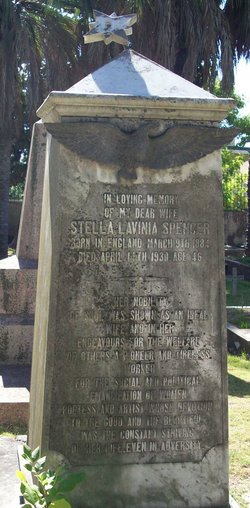
(photo courtesy David Rennie)
The epitaph reads:
In Loving Memory of my dear wife STELLA LAVINIA SPENCER born in England March 9th 1884 died April 14th 1930 age 46. Her nobility of soul was shown as an an ideal wife and in her endeavours for the welfare of others. A pioneer and tireless worker for the social and political emancipation of women. Poetess and artist whose devotion to the good and the beautiful was the constant striving of her life. Even in adversity.
I recently had an enquiry, emanating from Uruguay, as to whether I knew of Stella Lavinia Spencer, who had died in Montevideo in 1930, was buried in the city’s British Cemetery, and had, perhaps, been a suffragette. Well, the short answer was ‘No’ – the name rang no bells – but a quick search showed that a Stella Lavinia Spencer was indeed listed in the Roll of Honour compiled by the Suffragette Fellowship. So the hare was ready to be chased.
Identifying her as a possible suffragette was the easy bit. The attempt to untangle the identity of Stella Lavinia Spencer has been a good deal more complicated. No-one of that name appears in the list of ‘Suffragettes Arrested’ compiled by the Home Office, nor does she appear on any census. It is obvious from the wording on the tombstone that ‘Spencer’ was her married name and the Probate Register revealed that her husband’s name was ‘Alberto John Spencer’. So the hunt was on to establish her maiden name.
One would have thought that, with the relatively unusual forenames of ‘Stella Lavinia’ and a firm birth date of 1884, this wouldn’t be difficult. But, in fact, no-one of those names appears to have been born in England (or anywhere else) in 1884. Was she perhaps a child registered before her parents had selected her name? It’s possible. Or could she have refashioned herself, selecting names more appealing than those with which she had been furnished by her parents? Again, a possibility. There’s probably a quite straightforward reason for her absence from the various registers, civil or ecclesiastical, but, if so, I haven’t found it.
However, thanks to a general Google search for ‘Stella Lavinia Spencer’ I encountered an article (‘You Are Not a White Woman’) by James Heartfield (The Journal of Pacific History, vol 38, no 1, 2003) which sketched something of my quarry’s biography – as well as telling a rather riveting story. The article concerns the trial in Fiji in 1915 of Stella Spencer, which makes clear that she was by now married. But it turns out that ‘Spencer’ was not her husband’s family name; ‘Alberto John Spencer’ was originally ‘Alberto John Sangorski’. This was a surname I knew very well, as Sangorski and Sutcliffe was the leading firm of ‘art’ bookbinders in England at the beginning of the 20th century. Research quickly revealed that Stella’s husband, Alberto Spencer, was the son of Alberto Sangorski, renowned as the firm’s illuminator and calligrapher.
Anyway, armed with this new knowledge, I was now able to search for the marriage of Alberto Sangorski and, sure enough, found that he had married in Kensington in the summer of 1910. But even now matters were complicated by a quirk in the listing on the register that didn’t make clear the name of his bride. I won’t bore you with the ramifications of my further searches but only say that I finally decided that a likely candidate was a ‘Stella L. Mahny’. Needless to say I could find no other record of a woman with that rather unlikely surname, but with this faint lead I returned to the ‘Suffragettes Arrested’ register and discovered that a ‘Stella O’Mahoney’ had been tried in Westminster on 1 July 1908. Without the tedious unravelling of the link to the Spencer surname I could not have been certain that I had the right ‘Stella’. But I am sure now that I have.
And what was it that she had done to merit arrest? Votes for Women (9 July 1908) reported that, on 30 June 1908, Miss Stella O’Mahoney had taken part in a demonstration organised by the Women’s Social and Political Union in the vicinity of the House of Commons and that, with 26 other WSPU members, had been arrested. She was ordered to give a surety of £20 not to take part in any other militant activity, but refused, and was instead sentenced to a month’s imprisonment in Holloway. At the trial she gave her address as that of the WSPU office, 4 Clement’s Inn, so, once again, I could get no closer to her.
There is no other record I can find of Stella O’Mahoney’s involvement with the WSPU but I would presume that she had been a member both before and after this incident. However, a couple of years later, soon after her marriage, she and Alberto set off for Australia, landing in Sydney on 17 November 1910.
The Heartfield article mentions that Stella Spencer had worked as a journalist, but I have been unable to find any articles written by her. The tombstone describes her as a poet and an artist, but, yet again, I can find no trace of her work in any medium.
So, Stella Spencer would remain something of an enigma were it not for the reasons behind her trial in Fiji in March 1915 that James Heartfield reveals in his article. She had arrived with her husband from Melbourne about seven months earlier because he had been employed in a new venture, the Fiji Produce Agency. This organisation had been set up as a means for Fijians to market their own produce, in competition with European traders. The background rivalry, both economic and political, was complicated, but the upshot was that Stella Spencer stood trial, accused of slapping a Fijian in the face. He was a henchman of the European faction and had accused her of being ‘a bad woman’, the implication being that she was sexually involved with a Fijian. The ensuing trial – of a white woman accused of assaulting a Fijian – was remarkable, motivated not from a desire to protect Fijians, but to punish those Europeans who failed to observe the policy of separation from the indigenous population.
Stella Spencer was found guilty but apparently, Heartfield reports, did not have sufficient funds to pay the fine levied and was, therefore, imprisoned. I have no evidence whatsoever for querying this, but did just wonder if, as in 1908, it was rather that she had refused to pay a fine. It seems very surprising that no funds could be mustered if she had been minded to pay. Stella then went on hunger strike, perhaps in emulation of the suffragette stratagem, adopted subsequent to her 1908 imprisonment. However, she abandoned the hunger strike after four days and wrote to the governor asking for passage to Melbourne for herself and her husband. This was granted at the end of April 1915. I don’t know when and why she and Alberto eventually made their home in Montevideo but he remained there for the rest of his life, dying in 1954, twenty years after Stella, and is buried in the same cemetery.
It is not difficult to detect a parallel between Stella Spencer’s interest in the emancipation of women and that of improving the lot of the native population of Fiji. Whatever her background, she was clearly imbued with a spirit of rebellion
Copyright
All the articles on Woman and Her Sphere are my copyright. An article may not be reproduced in any medium without my permission and full acknowledgement. You are welcome to cite or quote from an article provided you give full acknowledgement
Collecting Suffrage: The ‘Census Resisted’ Badge
Posted by womanandhersphere in 1911 Census, Collecting Suffrage on September 25, 2020
NO VOTE – NO CENSUS – CENSUS RESISTED BADGE
Metal badge worn by suffragettes who boycotted the April 1911 census. Around the outside of the badge is ‘No Vote – No Census – Census Resisted and in the centre ‘A census for Gt Britain shall be taken in the year 1911 & the census day shall be Sunday the 2nd day of April in that year’.
The census boycott was an important act of civil disobedience and you can find many posts on this website about the suffragette resisters. Just key ‘census’ into the Search Box.
The round black and grey badge still carries on its reverse the maker’s paper ‘Merchants Portrait Co.’. This badge is extremely scarce and is in fine condition £1100
If interested in buying, email elizabeth.crawford2017@outlook.com
Collecting Suffrage: Portrait Postcard Of Christabel Pankhurst, c. 1908
Posted by womanandhersphere in Collecting Suffrage on September 7, 2020
Head and shoulders photographic portrait of Christabel Pankhurst, probably dating from c. 1908.
She is wearing a rather attractive loose, square-necked dress, with her hair up in her characteristic knot. When Kate Frye attended a meeting of the Actresses’ Franchise League addressed by Christabel in February 1910 she commented, ‘Her hair was very untidy and I think would suit her so much better done low than on top in an ugly little knob.’ But I always think the hint of dishevelment is rather endearing.
The postcard is captioned ‘Miss Christabel Pankhurst. The National Women’s Social and Political Union. 4 Clement’s Inn, WC’, indicating that it was issued after some members, led by Mrs Charlotte Despard, broke away to form the Women’s Freedom League in the autumn of 1907. For a time they hoped to keep the ‘WSPU’ name, which led the Pankhursts to rename their faction ‘The National WSPU’.
The card was published by Sandle Bros. and would have been for sale in WSPU shops. This copy came from a collection put together by three suffragette sisters. Fine – unposted – £40 + VAT in UK and EU. Email me if interested in purchasing. elizabeth.crawford2017@outlook.com
Collecting Suffrage: Photograph Of Mrs Emmeline Pankhurst c 1907
Posted by womanandhersphere in Collecting Suffrage on September 2, 2020
This photograph of Mrs Emmeline Pankhurst probably dates from c 1907, taken at her desk in Clement’s Inn, headquarters of the Women’s Social and Political Union.
The photograph comes from the collection of Isabel Seymour, who was an early WSPU supporter working in the WSPU office.
The photograph is mounted and is 15 x 20 cm (6″ x 8″) and is in good condition for its age. SOLD
Do email me if interested in buying. elizabeth.crawford2017@outlook.com
Collecting Suffrage: 1907 Programme For ‘Votes for Women’, Play By Elizabeth Robins
Posted by womanandhersphere in Collecting Suffrage on August 19, 2020
4-page programme for one of the 8 matinée performances of this so-popular play, staged in April and May 1907 at the Royal Court Theatre, Sloane Square, under the joint management of John Vedrenne and Harley Granville Barker.
The programme includes the cast list, of course, and a notice that ‘At these Matinées, Ladies are earnestly requested to remove Hats, Bonnets, or any kind of head dress. This rule is framed for the benefit of the audience…’
Kate Frye (suffrage diarist) saw the play on 16 April and wrote a long entry that night in her diary where, including, amongst other comments, ‘I loved the piece – it is quite fine – most cleverly written and the characters are so well drawn. Needless to say the acting was perfection as it generally is at the Court Theatre and the second act – the meeting in Trafalgar Square – ought to draw the whole of London. I was besides myself with excitement over it ‘
This programme belonged to Isabel Seymour, an early worker in the WSPU Clement’s Inn office, She folded the programme into her pocket or handbag and then kept it for the rest of her life.
In good condition – extremely scarce £500
Email me if interested in buying – elizabeth.crawford2017@outlook.com
THIS ARTICLE AND PHOTOGRAPHS ARE MY COPYRIGHT.
PLEASE CONTACT ME IF YOU WISH TO USE ANYTHING POSTED HERE.
Collecting Suffrage: The WSPU Holloway Prison Brooch
Posted by womanandhersphere in Uncategorized on August 13, 2020
The Holloway Prison brooch was designed by Sylvia Pankhurst and awarded to members of the Women’s Social and Political Union (WSPU) who had been imprisoned. It was first mentioned in the WSPU paper, ‘Votes for Women’, on 16 April 1909 and was described as ‘the Victoria Cross of the Union’. [It pre-dated the Hunger-Strike medal]. The design of the brooch is of the portcullis symbol of the House of Commons, the gate and hanging chains are in silver, and the superimposed broad arrow (the convict symbol) is in purple, white and green enamel. The piece is marked ‘silver’ and carries the maker’s name – Toye & Co, London, who were also responsible for the hunger strike medals. This brooch is for sale. Such treasures of the suffrage movement are now very scarce. It is in fine condition.
SOLD
Email me if you are interesting in buying. elizabeth.crawford2017@outlook.com
Collecting Suffrage: ‘Punch’ Cartoon, 17 January 1906
Posted by womanandhersphere in Collecting Suffrage on August 11, 2020
Punch cartoon from the issue for 17 January 1906. ‘The Shrieking Sister’. The Sensible Woman (with her fur stole around her neck) addresses the dishevelled ‘suffragette’ (with a ‘Female Suffrage’ flag tied to her umbrella) – ‘You – help our cause? Why, you’re its worst enemy!’ They are standing outside a hall that advertises ‘Great Liberal Meeting’.
Mrs Pankhurst’s Women’s Social and Political Union had recently appeared on the national scene. Just over two months previously Christabel Pankhurst and Annie Kenney had been imprisoned after interrupting a Liberal party meeting – and this is how the WSPU is now personified. The General Election, which resulted in a Liberal landslide, was in full swing when the cartoon was published.
A full-page Bernard Partridge cartoon. SOLD
If interested in buying, do email me elizabeth.crawford2017@outlook.com
Collecting Suffrage: Women’s Social And Political Union Brooch
Posted by womanandhersphere in Uncategorized on August 7, 2020
A silver and enamel Women’s Social and Political Union brooch. It was Sold to raise funds for the WSPU and was made by Toye and Co of Clerkenwell Road, London, the firm that made the WSPU’s hunger-strike medal. There is so much spurious material sold as ‘suffragette jewellery’; this is the Real Thing.
The brooch dates from between 1908 and 1914 and is in fine condition. It’s very scarce – and ready to wear.
For sale: £900 + VAT (in Uk and EU).
Email me if interested: Elizabeth.crawford2017@outlook.com
Collecting Suffrage: ‘Punch’ Cartoon, 21 October 1908
Posted by womanandhersphere in Collecting Suffrage on August 6, 2020
Punch cartoon, 21 October, 1908. Two burglars on their way to ‘suburban night-work’ watch a line of policemen marching the opposite way, into Town, to deal with the Votes for Women demonstration advertised on the poster.
The burglars agree that the ‘sufferajits’ are a good thing, keeping the police occupied as they do. This was the time of the ‘Rush the House of Commons’ demo.
FOR SALE – Full page cartoon by Bernard Partridge. Fine condition £12 SOLD
Lock-Down Research: The Case Of The Mysterious Suffrage Banner
Posted by womanandhersphere in Art and Suffrage, Lock-Down Research on June 29, 2020
I find it so satisfying when I am able to bring a photograph such as this to life. I acquired it two years ago but have not yet catalogued it because I could identify neither the banner nor the occasion. However, a little tenacity, a few idle lock-down hours and – EUREKA – I have found the answer.
The card came, with many others, in the collection of suffrage postcards compiled by the Hodgson Sisters . From this context I assumed the card had a suffrage connection, but I had never seen or heard of the banner. The photographer, as you will see from the imprint, was A. Dron of Brondesbury – so, as the Hodgsons were living in West Hampstead, I assumed the occasion pictured occurred in the area.
Even with a magnifying glass I couldn’t make out much more detail and it was only when I scanned the card and blew up the image that I found at the bottom right of the banner what seemed to be the artist’s monogram and a date – W E G S 1910. I felt I was making progress, but I’d never come across those initials when compiling my Art and Suffrage: a biographical dictionary of suffrage artists – and so was not much further forward.
I had tried searching for variations of ‘The Old Order Changeth’ in the British Newspaper Archive, but nothing relating to a banner had emerged. It was only when I searched for ‘banner’ in what I thought might be the local paper for Brondesbury in 1910, that the answer emerged. And it all seems so easy now.
The newspaper report in the Kilburn Times, 17 June 1910, revealed that the banner, a present to the North West London Union of the Women’s Social and Political Union, had been unfurled by Mrs Saul Solomon and was to be carried in the WSPU ‘Prison to Citizenship’ procession on Saturday 18 June. The artist was William Ewart Glasdstone Solomon [WEGS] (1880-1965), Mrs Solomon’s son.
Mrs Georgiana Solomon (1844-1933) was the widow of the governor-general of Cape Colony and had for many years been active in social reform and suffrage movements. By 1910 she was living in West Hampstead and had already been arrested once. Five months after the photograph was taken she was assaulted in the course of the notorious ‘Black Friday’ debacle in Parliament Square and in March 1912 was imprisoned after taking part in the WSPU window-smashing campaign. Her daughter, Daisy, who was also an active WSPU member, featured in one of their publicity stunts, sent in 1909 as a ‘human letter to 10 Downing Street. She also served a prison term and by 1912 was organizing secretary of the Hampstead branch of the WSPU.
Given the family association, it is not surprising that Mrs Solomon’s son, who had been a student at the Royal Academy Schools, should have put his art to the service of the Cause. He later became director of the Sir J.J. School of Art in Bombay (Mumbai) before eventually returning to South Africa, the land of his birth. He is classed as a ‘South African artist’ but we can now appreciate that one of his earlier works was in support of the British women’s suffrage movement.
The newspaper article includes the information that the banner depicts ‘two life-size figures, a man and a woman, and the idea which the artist apparently means to convey is the dawn of a new era of political sex equality. The lettering ‘Political equality’ and ‘The old order changeth, giving place to new’ is conspicuous on the canvas’. I haven’t been able to spot the words ‘Political equality’, but perhaps they are on the reverse.
The Kilburn Times report tells us that the unfurling of the ‘Old Order Changeth’ banner took place at ‘Plympton House’, 154 Willesden Lane, which was the home of Mr and Mrs A.A. Jones, and that speeches were made by Helen Ogston and Flora Drummond. Mrs Eleanor Penn Gaskell was also present. Alas, I cannot identify the two young women holding the banner. Possible candidates that spring to mind are Daisy Solomon and Helen Ogston, but neither look quite like the women in the photograph. Nor are they, I think, any of the Hodgson Sisters.
I now see that the report for the WSPU N.W. London branch carried in the issue of Votes for Women for17 June 1910 declares ‘Let no local women miss the chance of walking in the great Procession under Mr W. E. Gladstone Solomon’s most beautiful banner’.
And there I rest my case…so pleased to have retrieved the story behind this most intriguing of photographs.
Copyright
Kate Frye’s Suffrage Diary: Buckingham Palace, 21 May 1914
Posted by womanandhersphere in Kate Frye's suffrage diary on May 21, 2014
A hundred years ago today, on 21 May 1914, having failed to influence the government, Mrs Pankhurst’s Women’s Social and Political Union, decided to appeal directly to the King. Kate Frye, although not a militant suffragette, was there – outside Buckingham Palace – to witness the scene. This is the copy of the Daily Sketch that she bought that day and kept all her life.
The following is Kate’s diary entry:
‘Thursday May 21st 1914
To Office.Then in the afternoon I went to Buckingham Palace to see the Women’s deputation – led by Mrs Pankhurst which went to try and see the King. It was simply awful – oh! those poor pathetic women – dresses half torn off – hair down, hats off, covered with mud and paint and some dragged along looking in the greatest agony. But the wonderful courage of it all. One man led along – collar torn off – face streaming with blood – he had gone to protect them. Fancy not arresting them until they got into that state. It is the most wicked and futile persecution because they know we have got to have ‘Votes’ – and to think they have got us to this state – some women thinking it necessary and right to do the most awful burnings etc in order to bring the question forward. Oh what a pass to come to in a so-called civilised country. I shall never forget those poor dear women.
The attitude of the crowd was detestable – cheering the police and only out to see the sport. Just groups of women here and there sympathising, as I was. I saw Mrs Merivale Mayer, Miss Bessie Hatton and a good many women I knew by sight. I stayed until there was nothing more to be seen. The crowds were kept moving principally by the aid of a homely water cart. It was very awful. Mrs Pankhurst herself was arrested at the gates of the Palace. I did not see her but she must have passed quite close to me.
I went to Victoria and had some tea and tried to get cool, but I felt very sick. The King could have done something to prevent it all being so horrible – he isn’t much of a man. Back by bus [to the office of the New Constitutional Society where she was working]. They [Alexandra and Gladys Wright, friends and colleagues ] wanted to hear about it, but they don’t take quite the same view of it that I do. They seem so ‘material’ in all their deductions – it’s all so tremendously more than that.’
For much more about Kate Frye and her diary – published as Campaigning for the Vote: Kate Parry Frye’s suffrage diary – click here
Kate Frye’s Suffrage Diary: The Suffrage Shop in Hythe High Street
Posted by womanandhersphere in Kate Frye's suffrage diary on August 9, 2013

In mid-1912 this shop at what was, before renumbering, 83 High Street, Hythe- now, rather suitably an animal welfare charity shop, opened as the local Suffrage Shop and Club, run by Miss Georgina Cheffins and Miss Eva Lewis, who, although members of the WSPU, were Kate Frye’s most active supporters in the area as she went about her business of organizing meetings for the New Constitutional Society for Women’s Suffrage. I visited it myself in the summer of 2011 and found that the shop is quite large and, as Kate Frye describes, has a room at the back in which the Suffrage Club held its meetings.
Georgina Cheffins (1863-1932) was the daughter of a Portland cement manufacturer. and In the 1901 census, when she was living with Eva Lewis in the St James’s Mission, Temple Street, Sedgley, Cheshire, they are both described as ‘lay sisters’. Eva (Evangeline) Lewis (1863-1928) had been born in Ontario, Canada, the daughter of John Lewis, Lord Bishop of Ontario. She lived with Georgina Cheffins, who was very much the wealthier of the two, from some time before 1901 until her death.
Both women successfully evaded the 1911 census and in 1912 Miss Cheffins was sentenced to four months’ imprisonment after taking part in a WSPU window-smashing raid in London – breaking windows in Gorringes’ store. In court she declared she was a suffragist by conviction, having worked amongst the poor for 20 years.
When Kate first met them the two women lived at ‘Dunedin’, Seabrook Road, the long road connecting Hythe and Folkestone, but in early 1912 they moved to ‘Cravenhurst’, Napier Gardens, Hythe. When I visited Hythe in 2011 I did not know which house in Napier Gardens had been ‘Cravenhurst’ – and it is only today that I have found a piece of information that links the name of the house to a number – 24 – which is ,I think, opposite the house below – one of several in the street that I photographed at random. Anyway, I think no 24 was at the more secluded end of the cul-de-sac that is Napier Gardens .
In the summer of 1912 Votes for Women, the WSPU newspaper, reported that the Hythe Suffrage Shop had been visited by many WSPU members on holiday in the area – and that many volunteers had been out selling copies of the paper.
Campaigning for the Vote: Kate Parry Frye’s Suffrage Diary is full of details of the delights – and tribulations – of spreading the ‘Votes for Women’ message in Hythe. Although Miss Cheffins and Miss Lewis could on occasion be prickly, Kate kept in touch with them well into the 1920s.
See here for much more about Campaigning for the Vote
PS. Update – Thanks to Betty Black for information on the renumbering of Hythe High Street. Nothing beats local knowledge.
Copyright
All the articles on Woman and Her Sphere and are my copyright. An article may not be reproduced in any medium without my permission and full acknowledgement. You are welcome to cite or quote from an article provided you give full acknowledgement
Campaigning For The Vote: Kate Frye and ‘Black Friday’, November 1910
Posted by womanandhersphere in Kate Frye's suffrage diary on May 20, 2013
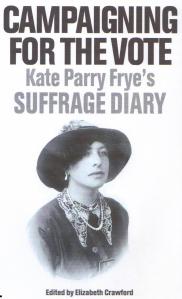 Kate Frye was present on so many important suffrage occasions – including ‘Black Friday’ – 18 November 1910. On this day the suffrage societies learned that the Conciliation Bill, on which they had pinned their hopes, would be abandoned as, with the two houses of Parliament locked in confrontation over Lloyd George’s budget, Parliament was to be dissolved. The police were out in force and employed brutal tactics to break up the women’s demonstration.
Kate Frye was present on so many important suffrage occasions – including ‘Black Friday’ – 18 November 1910. On this day the suffrage societies learned that the Conciliation Bill, on which they had pinned their hopes, would be abandoned as, with the two houses of Parliament locked in confrontation over Lloyd George’s budget, Parliament was to be dissolved. The police were out in force and employed brutal tactics to break up the women’s demonstration.
Only a short excerpt of Kate’s ‘Black Friday’ diary entry appears in Campaigning for the Vote because it occurred in the period before Kate began work as a paid organizer for the New Constitutional Society for Women’s Suffrage. There was, alas, just too much material in her diary to make a book out of her whole suffrage experience. So, for those who would like more, here are full details of Kate’s experience that momentous day.
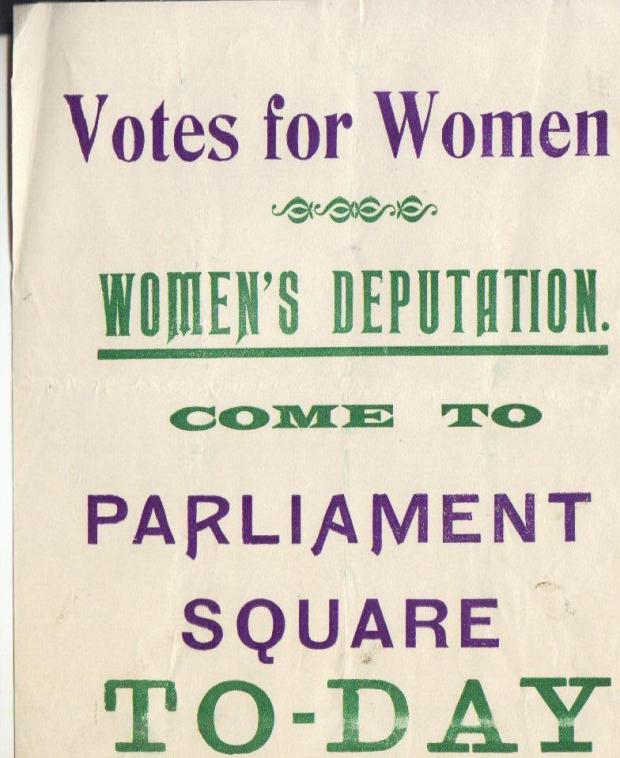
Kate’s invitation from the WSPU to attend the protest, Friday 18 November 1910. Just imagine how many of these fragile flyers lay torn and trampled on the ground at the end of ‘Black Friday’. Kate carefully preserved hers, took it home and laid it in her diary
Friday November 18th 1910
Up in good time. Brushed Mickie [her dog] then took him for a walk – then started at 10.30 for the Caxton Hall. Train from Notting Hill Gate to St James’ Park. I got there about 12 – and the hall was already full and the crowd hanging about were soon after turned out of the vestibule – so I stood some time on the steps. Then from there we were turned into the street and I waited there, chatting with different women, till about 12.40 when the 1st deputation left the Caxton Hall for Parliament Square.
They were soon swallowed up in a seething mob and I simply flew with many other women by short cuts to Parliament Square where I landed more or less by chance in the thick of it. One could hardly see the plan of it all amid the hurly burly excitement, shouts, laughter applause & rushes of the enormous crowd which grew every minute. I was almost struck dumb and I felt sick for hours. It was a most horrible experience. I have rarely been in anything more unpleasant – it was ghastly and the loud laughter & hideous remarks of the men – so called gentlemen – even of the correctly attired top-hatted kind – was truly awful. It made all the men and women seem mad together. And the poor women – the look of dogged suffering & strain on their faces.
I first reached the wall of the moat [round the Houses of Parliament] at the angle so I could see the door plainly and Mrs Pankhurst and the elderly lady [Elizabeth Garrett Anderson] – over 70 years of age – with her. Then I saw policemen breaking up the little standards held by a group of women. I saw deputations pass along and ugly rushes and ever the crowd grew.
I stood some time but I had to give up my place by the wall people pushed so and I was awfully afraid of getting crushed. So I got out to the road and there watched the deputations come along and saw the horrible hustling by the crowds of roughs and overheard the hideous laughter and remarks of the men looking on. Half of them made the remark that it was the funniest thing they had ever seen in their lives – all had their mouths open in an insane grin. One or two were so horrible that I just gazed upon them till they noticed me and moved away, not liking I suppose to be overheard. Several spoke to me – many indignant: ‘What good do you suppose this will do?’ ‘What else would you suggest?’ said I. Then he began the usual – that the militant methods had disgusted all nicely feeling people etc. I turned his attention to my two badges – constitutional societies, as I told him – and asked ‘What help have you ever given us?’ He walked away. Not one man did I hear speak on the women’s side. There may have been some, but not near me.
I saw Captain Gonne led off & heard afterwards of his doings. Many women there were of the WSPU – and a few London Society [ie members of the constitutional NUWSS society] – all standing about perfectly wretched & green – cheering them on to battle and off to Cannon Row when arrested. One poor lady in her wheel chair [probably Rosa Billinghurst]– propelled by hand – followed in the wake of a deputation – generally 6 to a dozen people – she rang her bell violently and the crowd gave way before her – it was a funny but dreadfully tragic sight.
As the crowd grew and the crowd kept being pressed back – I moved away and once, seeing some fighting women & policemen on the pavement coming my way, I stood back to the railing expecting them to go by. But, oh no – a burly policemen, taking me for one of a deputation, caught hold of me with an ‘Out you come’ and for some minutes I was tossed about like a cork on an angry sea, turning round and round – sometimes bumped on to a policeman – sometimes on a hospital nurse, who was fighting for all she was worth – pale to the lips but determined (and I afterwards saw her led off arrested ) – until I was with the others pushed out of the danger zone.
The others went back but I sat down by the railing for a few minutes. I can’t say the man actually hurt me and I was too excited to realise quite what was happening and I was so thickly dressed as not to feel the bumps much – but it wasn’t nice. I don’t know I could have spoken if I had wished to – but I didn’t wish and I didn’t speak. What I felt was – I am not going to get out of the trouble by saying I am not one of them for I am in heart and anyway he will probably think I am trying to trick him and it will do no good and if these women can stand so much I can stand this little. And of course it was nothing really – only a new experience.
Two ladies – one quite elderly came out of their first battle determined not to go back into it. They were a pitiable spectacle – their nerve had gone. One felt so sorry – they were beside themselves and were not aware they had in fact turned ‘coward’. A little lady – evidently there to plead with the faint hearted – spoke quietly to them, urging them to go when they felt rested. ‘But we couldn’t’, they said, ‘we have been half killed’. ‘Oh, but you must – you must go back again and again and again’ and so on. And I spoke to them – thinking an outsider’s word might turn their attention. Their eyes were brimming. They told me that they were supposed to go on till their strength was exhausted – they thought theirs was – but it wasn’t. But poor souls – their fight – of course they had never realised the awfulness of the business and what they would have to endure until they should fall fainting or injured. I wonder if they went back. Perhaps courage did come back to them but who could blame them – they were very saddening.
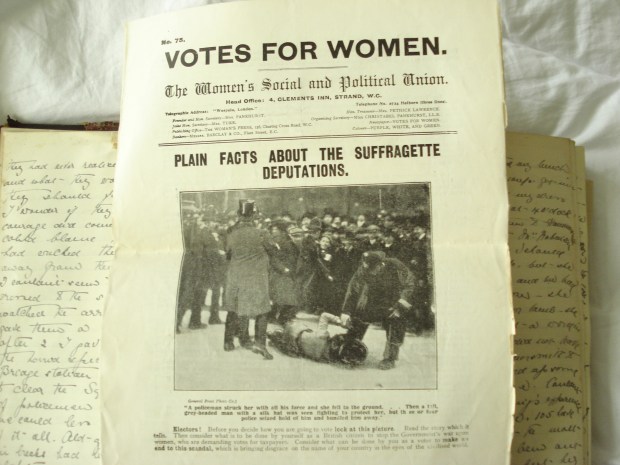
On the next page of the diary entry Kate laid in the WSPU’s pamphlet prepared as a result of ‘Black Friday’
I couldn’t seem to leave even when I had crossed to the station side. I stood and watched the arrested being led off – & gave them a send off – but soon after 2 I gave it up and, leaving the horrid spectacle, went in to Westminster Bridge station. They were beginning to clear the Square of people. Hundreds of policemen were arriving and one could less than ever see the plan of it all. A lot of Yankee sailors had been mystified but delighted and a lot of people were frankly puzzled by it all – and it was a sad business explaining to them. I got back cold to the bone – fetched my lunch on a tray – and was glad of hot soup.
After a visit to friend for tea on way home] grabbed up some evening papers then home. Couldn’t keep my mind off the morning’s experience and we talked of little else. 105 have been arrested. It was about the most bitterly cold night I have ever been out in.’
As a result of what she had witnessed on ‘Black Friday’ Kate Frye joined the WSPU
Campaigning for the Vote: Kate Parry Frye’s Suffrage Diary edited by Elizabeth Crawford. Now, alas, out of print
- ‘Campaigning for the Vote’ – Front and back cover of wrappers
Kate Frye’s Suffrage Diary: Banner Bearer For The 13 June 1908 Procession
Posted by womanandhersphere in Kate Frye's suffrage diary on October 30, 2012
Asquith became prime minister in April 1908. In response to his claim that he needed proof that large numbers of women really wanted the vote, the National Union of Women’s Suffrage Societies – and the WSPU – decided to mount a spectacular summer procession through London. The magnificent banners, such as that for North Kensington, carried some of the way by Kate, were the work of the Artists’ Suffrage League, in particular of Mary Lowndes.

Mary Lowndes’ design for the North Kensington banner – with swatches of suggested material (courtesy of the Women’s Library@LSE)
The design of the North Kensington banner, held in the Women’s Library, can be seen
The banner itself was photographed during the course of the 13 June 1908 procession. ‘North Kensington’ is being held high; unfortunately the ‘Home Makers’ obscure the North Kensington banner bearers. Was one of them Kate?
Saturday June 13th 1908 [Bourne End]
The great day dawned at last looking rather threatening – dull and very windy. I did not know quite what to wear but chanced the day wisely as it fell out and wore my best cream linen skirt and embroidery blouse and made myself look nice. I took a coat with me. Down to breakfast, had a chat to Agnes, who was very disappointed not to be going but really she was not up to it and it would have been no use attempting such an exacting and arduous day. It took it out of me. I was ‘going’ inside all day. Went up to London by the 9.53 train wearing my decorations – my ‘Votes for Women’ disk – my National Union Suffrage brooch and my red and white ribbon – the one that went through that exciting evening at the Paddington Baths. I wore them all day and it was most amusing to see the looks given to them. I went shopping in Whiteleys. Then a bus to Bond Street, walked through Burlington and along to the Strand – there I began to see some of my fellow marchers and the Lyons where I lunched was crowded with them – every one agog, of course, to see us.
Then I went to the A.A. [the Actors’ Association] tidied myself up and went upstairs. Quite an excitement there to see me and I found Eve Erskine wavering as to whether or not she should join the march. She rather aggravated me by some of the things she said about it. Then she is so tactless and really doesn’t know. It was from her I learned that there would be a contingent of Actresses headed by Gertrude Kingston, Lillah McCarthy and Mrs Pat [Campbell] and I must own I did feel deadly disappointed not to be going with them. I am sure Miss Gladys [Wright] kept it from me on purpose as she knew how eager I was to get the theatrical people to go and I said how I should like to march with them. So for that reason she did not send me a plan of the order of procession, I feel sure. Not quite straight because, any way, if she had said they really needed my help in Kensington I should have gone. But she and Alexandra went with the graduates and they wanted me responsible for N[orth] Kensington. There was really no-one else. Mrs Wright could not have carried the Banner or any of the small women if they could have it would not have looked right and comfortable. So I was offered up as a sacrifice. I think it was only right a Frye should be the Banner Bearer for North Kensington and I loved to do it and felt very proud but at first I must own to feeling a bit sick over it. I had a few words with Mr Halliwell Hobbs, who was crimson in the face with annoyance about it all. I said ‘will you shake hands though I am going to carry a banner.’ He simply could not bear himself – it so upset him to see my decorations. Eve walked or rather ran – we got so excited seeing the crowds – to the Embankment and there I lost her. I suppose she found her Block and marched with them for I saw her no more.
The crowds and the excitement was terrific and I really didn’t know how I should find my banner in it all. First I saw Miss Corbett who gave me a plan. Eve had one so I am sure Gladys ought to have sent her Banner Bearer one. And then I found I should be Block 8 – and a nice scamper I had right up Whitehall before I came to my place. Whitehall was quieter, but the crowds on the Embankment were terrific. At last I came to the Block for the London Society and found a messenger boy with the little White and Red Banners we had before. He gave it up to me on hearing my name and I was left alone. As I got there soon after 2 o’clock it was alright but I longed for some friendly face. I had had a glance at some of the Banners as I sped along – they were lovely. At last one or two women whose faces I knew turned up and then three girls with a huge and beautiful banner – one of the Artist League ones – the one Gladys meant me to carry and take the responsibility of. They were in too much of a hurry, the girls, to be off to tell me how to manage it and I had my flapping coat and the wind was terrific. I got one of the others to hold the little one till Mrs Wright and a lot of other people came. Then a tall girl carried the little one at the back of the Kensington Block. Some one very kindly carried my coat and I got the frog fixed round the banner more comfortably. Miss Madge Porter carried one cord, Miss Meyer the other.
We were immediately behind the Holborn section and Lady Grove’s pretty daughters carried that Banner – a huge one – but, lucky beggars, they had two poles to support it. Mine was fearfully heavy, especially in the wind – but I was given a gift with it I think. It was a beauty nauge cloth – brown and yellow silk and cloth of gold. Mrs Percy Harris was just behind. She had to fall out early as she went very strange and there were lots of people I know by sight. We were quite a smart collection – all in our best summer attire. The stewards marshalled us six abreast behind the Banner which had to stand out. The whole thing was most wonderfully organised.
Before we moved off John [her fiance] arrived on the scene with Mr Andrews [a friend] and was most proud to shake hands with me and I think the whole thing quite converted him. They went off to see the Banners, then took up their stand in Trafalgar Square and watched us go. John watched it over an hour. He saw me but I didn’t see him. He says I was laughing away and looked to be enjoying myself. Some of the remarks were enough to make one laugh. I saw Mr Dickenson [the M.P.] go past and G.B. Shaw while I was waiting and there were all sorts of weird and curious men – one dressed up like a Jack in the Box to represent Adam, I think – but I couldn’t make him out.
Before 2.30 we were off to the strains of a Band and marshalled in order and we reached one side of the Embankment. We were given 2.30 to assemble – so those who turned up then must have had a difficulty in finding us. It took some time – then there was half an hour’s wait in line – then we began to manoeuvre about – the police directed us. I don’t really know what we did but we turned back round the road while a stream passed us the other way then round me went again over to the side of the trams which made some of them nervous. The trams were packed with people to see us. Then a long wait again – 3.30 I should say before we moved off – and then a very slow procession up Northumberland Avenue – halts of five minutes at a time, it seemed. We were in the middle of two Bands so we were never dull and sometimes with the clamour of the two together it was terrific but the marches helped me along and we three kept step. Oh the crowds – packed like sardines the other side of Piccadilly – some of the roughest of the rough on the Embankment but for the most part quite friendly and polite. There seemed so few policemen in comparison that if the crowd had liked to be disagreeable it would have been awful. The clubs and hotel windows and steps were thronged. Most of the people seemed interested – some were laughing. We only had passage enough just to pass along till we got to the Square then our pace mended till it grew terrific and had almost to run to keep up and going up Waterloo Place was a great strain. From the bottom we could see the Banners winding up and up.
We were about 10,000 with 70 Artist League banners – lots of others and hundreds of Bannerettes shimmering in the wind. For the most part after Piccadilly the crowd was quite a different class and quiet and respectful – many men raised their hats to us and ladies clapped their hands – lots of children? were in the crowd and ‘Mother’ made one clap his hands at me. One nice old clergyman bared his silver locks to each Banner Bearer. Of course it was a very different thing from last year [ie the February ‘Mud March’] – gigantic in comparison and, as for the crowds, I had never seen anything like them except at Royal Weddings etc and a good long route we had. Up Northumberland Avenue, Lower Regent Street, Piccadilly, Knightsbridge, Exhibition Road to the Albert Hall. The first part of them must have been in the hall soon after we left the Embankment. I was in the last section – No 8, the London Society – but I could not see our end and after us came all the motor cars and carriages. The Social and Political Union people had a four in hand and were up and down distributing notices of their great demonstration on Sunday week in Hyde Park. The Graduates and Doctors looked simply lovely – I am sure they must have got some cheering ‘Well’ I heard one man say, ‘what I like about them is there isn’t one with a bit of powder on’.
‘Lucky you have dropped your garter’ ‘Have you mended the socks’ Have you washed the baby’ and such remarks as those were rife and, of course, lots of comments on one’s personal appearance – rather painful some of them –‘Oh look at this nice girl’ ‘isn’t she a beauty’ etc but really most of the people were quite kind and sympathetic. I think it must have been rather a stirring sight – it seemed to me ‘magnificent’. I felt it was moving the people. I heard people say in awestruck tones ‘I don’t believe it will ever end’ Miss Meyer took the Banner from me in Piccadilly and carried it to the end – she hadn’t had all that tiring first part and the long waits and she was strong and capable. I must say I was getting a bit done with it but I would have liked it again later only she seemed quite happy and I did not like to take it from her. Gladys had written to say she would help me with it. She took it in the hall and sat with it also.
The approach to the [Albert] hall was very slow again – but the pace all along Piccadilly had been tremendous. I think we must have been catching the first lot up where it had been broken at Trafalgar Square for the traffic. I got in the hall about 5.10 and they started the meeting just as I sank down. I must own to feeling completely done when I left the Banner. I got cramp in both feet at once and felt 1,000 but I dashed into the hall found the seat in my box with the Wrights and Alexandra, like an angel, got me a cup of tea. She, Gladys and another girl looking most awfully charming in cap and gown. Mrs Stanbury was there and Mrs Lambert and several people I knew. I had to keep my eye on the clock but I heard Lady Henry Somerset, Dr Anna Shaw, Mrs Fawcett and [then] Miss Sterling present the Bouquet to Mrs Fawcett – then the procession of Bouquets till the platform looked like a garden. They were just singing ‘For she’s a jolly good fellow’ when I came out. I got a cab, still very lame, and drove to Paddington. There I met John and Mrs Harris and the train was looking out for me – so we travelled down together, talking all the way…
The Actors Association, a club to which both Kate and John belonged, was at 10 King Street, Covent. Garden.
Halliwell Hobbs, 30-year-old actor, was clearly a young fogey.
Margery Corbett (1882-1981- later Dame Margery Corbett-Ashby) was the daughter of a Liberal MP. At this time she was secretary of the NUWSS
Lady Henry Somerset (1851-1921) was a wealthy philanthropist and leader of the temperance movement.
Mrs Percy Harris, née Marguerite Frieda Bloxam, wife of Percy Harris (later Sir Percy Harris), who became a Liberal MP in 1916, lived in Bourne End.
Anna Howard Shaw (1847-1919) US physician, temperance reformer and, at this time, leader of the National American Woman Suffrage Association.
Frances Sterling (1869-1943) joint honorary secretary of the NUWSS.
Campaigning for the Vote: Kate Parry Frye’s Suffrage Diary edited by Elizabeth Crawford
For a full description of the book click here
Wrap-around paper covers, 226 pp, over 70 illustrations, all drawn from Kate Frye’s personal archive.
ISBN 978 1903427 75 0
Copies available from Francis Boutle Publishers, or from Elizabeth Crawford – e.crawford@sphere20.freeserve.co.uk (£14.99 +UK postage £3. Please ask for international postage cost), or from all good bookshops. In stock at London Review of Books Bookshop, Foyles, National Archives Bookshop.
Book of the Week: Margaret Sanger, Woman And The New Race – Kitty Marion’s copy – rich with suffrage and Sanger associations
Posted by womanandhersphere in Book of the Week on October 2, 2012
Margaret Sanger, Woman And The New Race, published by Brentano’s (NY), 1921 (3rd printing) – Kitty Marion’s copy
Margaret Sanger spearheaded the birth-control campaign in the US. In this book, first published in 1920, she writes: ‘The most far-reaching social development of modern times is the revolt of woman against sex servitude. The most important force in the remaking of the world is a free motherhood’. The Introduction to the book is by Havelock Ellis, one of several leading thinkers with whom she had an affair.
In October 1914 Margaret Sanger fled from the US to England while on bail for violating US postal obscenity laws – the charge was that of sending through the post copies of her radical feminist journal, The Woman Rebel, which advocated the use of contraception. She remained in England until October 1915. Coincidentally it was in October 1915 that Kitty Marion, a former, German-born, militant suffragette, set sail for the US. Once in New York she worked for many years for Margaret Sanger, her role being that of street seller of Sanger’s Birth Control Review.
In England in 1913 Kitty Marion had been sentenced to three years’ imprisonment for her part in the burning of the grandstand at the Hurst Park racecourse (as retaliation for the death of Emily Wilding Davison)- although, after going on hunger and thirst strike, she was released under the Cat and Mouse Act. It would appear that, on the run, she was one of the WSPU’s most active arsonists, although she evaded detection for much of the destruction she committed. In New York, on 14 October 1918, she was again given a prison sentence – this time for distributing Birth Control Review.
This particular copy of this book brings together these various histories. The free front endpaper bears the ink inscription, in Margaret Sanger’s handwriting – ‘Margaret Sanger, New York, Oct 14-1921.
Underneath this is written ‘zum Andenken! Kitty Marion’ [translated from German: In Memory!]. This inscription obviously commemorates the 3rd anniversary of Kitty Marion’s imprisonment – of which Margaret Sanger had at the time written ‘We glory in her deed’. I think the second part of the endpaper inscription may be Kitty Marion’s hand. For although the ink looks much the same as the Sanger message, I think the writing is different.
Yet another layer of suffrage association is revealed by the ownership signature, written faintly in pencil in the top right corner of the same page. It is that of Maud Fussell, another former member of the WSPU – and, again, one who suffered imprisonment.
My reconstruction of the history of the book is that it was signed by Margaret Sanger for Kitty Marion and was subsequently given by Kitty Marion to Maud Fussell. It was sold to me along with other books that had been in Maud Fussell’s possession.
The book is in good condition and is a particularly interesting association copy. Price £165 plus postage.
To buy: please contact me at e.crawford@sphere20.freeserve.co.uk
Kate Frye’s Suffrage Diary: Spring 1908 – Suffrage Hope – WSPU in Albert Hall ‘a little too theatrical but very wonderful’
Posted by womanandhersphere in Kate Frye's suffrage diary on September 26, 2012
Another extract from Kate Frye’s manuscript diary. An edited edition of later entries (from 1911), recording her work as a suffrage organiser, is published as Campaigning for the Vote: Kate Parry Frye’s suffrage diary.
Kate’s MP, Henry Yorke Stanger, was the promoter of the current Enfranchisement Bill – the latest in the long line that stretched back through the latter half of the 19th century. Despite, as Kate describes, the bill passing its second reading, the government eventually refused to grant facilities to further the debate. However, that blow was yet to come as Kate records in these entries details of the suffrage meetings she attended in February and March 1908. She had the knack of always being present on the great occasions – and on 19 March was in the Albert Hall to witness the rousing – and profitable – reception given to Mrs Pankhurst on her release from prison.
Dramatis personae:
Miss Harriet Cockle, was 37 years old, an Australian woman of independent means, lving at 34 de Vere gardens, Kensington.
Mrs Philip Snowden – Ethel Snowden (1880-1951) wife of the ILP politician, Philip Snowden.
Mrs Clara Rackham (1875-1966) was regarded as on the the NUWSS’s best speakers. In 1910 she became president of the NUWSS’s Eastern Federation, was founder of the Cambridge branch of the Women’s Co-operative Guild, and was sister-in-law to Arthur Rackham, the book illustrator.
Margery Corbett (1882-1981- later Dame Margery Corbett-Ashby) was the daughter of a Liberal MP. At this time she was secretary of the NUWSS.
Mrs Fanny Haddelsey,wife of a solicitor, lived at 30 St James’s Square, Holland Park.
Mrs Stanbury had been an organiser for NUWSS as far back as 1890s.
Tuesday February 25th 1908 [London-25 Arundel Gardens]
We got home at 5.15 and had tea. Then I did my hair and tidied myself and Agnes and I ate hot fish at 6.30 and left soon after in a downpour of rain for the Kensington Town Hall – we did get wet walking to the bus and afterwards. We got there at 7 o’clock to steward – the doors were opening at 7.30 and the meeting started at 8.15. I was stewarding in the hall downstairs and missed my bag – purse with 6/- and latch Key etc – very early in the evening which rather spoilt the evening for me as I felt sure it had been stolen. It was a South Kensington Committee of the London Society for Woman’s Suffrage and we were stewarding for Miss Cockle. It was a good meeting but not crowded but, then, what a night. Miss Bertha Mason in the Chair. The speech of the evening was Mrs Philip Snowdon, who was great, and Mrs Rackham, who spoke well. The men did not do after them and poor Mr Stanger seemed quite worn out and quoted so much poetry he made me laugh. Daddie had honoured us with his presence for a little time and had sat on the platform – so I feel he has quite committed himself now and will have no right to go back on us. We were not in till 12.20 and then sat some time over our supper.
Wednesday February 26th 1908
Before I was up in the morning Mother came up in my room with my bag and purse and all quite safe. It had been found and the Hall Door Keeper had brought it. I was glad because of the Latch Key. Daddie generously had paid me the 6/- which I was able to return.
Friday February 28th 1908
Mr Stanger’s Woman’s Suffrage Bill has passed the second reading. I had to wait to see the Standard before going to my [cooking] class. That is very exciting and wonderful – but of course we have got this far already in past history. Oh! I would have liked to have been there.
MargWednesday March 11th 1908
To 25 Victoria Street and went to the 1st Speakers Class of the N.[ational] S.[ociety] of W.[omen’s] S.[uffrage]. I was very late getting there and there was no one I knew so I did not take any part in the proceedings and felt very frightened. But Alexandra Wright came in at the end and I spoke to Miss Margery Corbett and our instructoress, Mrs Brownlow. And then I came home with Alexandra from St James’s Park station to Notting Hilll Gate.
Thursday March 12th 1908
Mother went to a Lecture for the NKWLA [North Kensington Women’s Liberal Association] at the Club and Agnes and I started at 8 o’clock and walked to Mrs Haddesley [sic] for a drawing-room Suffrage Meeting at 8.30. Agnes and I stewarded and made ourselves generally useful. The Miss Porters were there and a girl who I saw at the Speakers’ Class on Wednesday. Alexandra was in the Chair and spoke beautifully – really she did. And Mrs Stanbury spoke. Mrs Corbett and Mrs George – all very good speakers. Mrs Stanbury was really great and there were a lot of questions and a lot of argument after, which made it exciting. It was a packed meeting but some of the people were stodgy. Miss Meade was there with a friend – her first appearance at anything of the kind she told us and she said it was all too much for her to take in all at once. The “class” girl walked with us to her home in HollandPark and we walked on home were not in till 11.45. I was awfully tired and glad of some supper and to get to bed.
Mrs Pankhurst had been arrested on 13 February as she led a deputation from the ‘Women’s Parliament’ in Caxton Hall to the House of Commons. She was released from her subsequent imprisonment on 19 March, going straight to the Albert Hall where the audience waiting to greet her donated £7000 to WSPU funds. Kate was there.
Thursday March 19th 1908
I had a letter in the morning from Miss Madge Porter offering me a seat at the Albert Hall for the evening and of course I was delighted….just before 7 o’clock I started for the Albert Hall. Walked to Notting Hill gate then took a bus. The meeting was not till 8 o’clock but Miss Porter had told me to be there by 7 o’clock. We had seats in the Balcony and it was a great strain to hear the speakers. It was a meeting of the National Women’s Social and Political Union – and Mrs Pankhurst, newly released from Prison with the other six was there, and she filled the chair that we had thought to see empty. It was an exciting meeting. The speakers were Miss Christabel Pankhurst, Mrs Pethick Lawrence, Miss Annie Kenney, Mrs Martel and the huge sums of money they collected. It was like magic the way it flowed in. It was all just a little too theatrical but very wonderful. Miss Annie Kenney interested me the most – she seems so “inspired” quite a second Joan of Arc. I was very pleased not to be missing so wonderful an evening and I think it very nice of Miss Porter to have thought of me. She is quite a nice girl of the modern but “girlie” sort – a Cheltenham girl and quite clever – but very like a lot of other girls. Coming out we met, strangely enough, Mrs Wright and Alexandra (Gladys was speaking at Peckham) and after saying good-bye to Miss Porter I walked home with them as far as Linden Gardens. Got in at 11.30 very tired indeed and glad of my supper. Mother was waiting up.
Campaigning for the Vote: Kate Parry Frye’s Suffrage Diary edited by Elizabeth Crawford
For a full description of the book click here
Wrap-around paper covers, 226 pp, over 70 illustrations, all drawn from Kate Frye’s personal archive.
ISBN 978 1903427 75 0
Copies available from Francis Boutle Publishers, or from Elizabeth Crawford – e.crawford@sphere20.freeserve.co.uk (£14.99 +UK postage £3. Please ask for international postage cost), or from all good bookshops. In stock at London Review of Books Bookshop, Foyles, National Archives Bookshop.
Collecting Suffrage: The Game of ‘Suffragette’
Posted by womanandhersphere in Collecting Suffrage on September 17, 2012
I will shortly be issuing a new book and ephemera catalogue – number 175. It will comprise books and ephemera by and about women – with special sections on Women’s Suffrage and Women in the First World War. If you would like a copy of the printed or email version please let me know. A short time after these have been sent out, I shall post the catalogue on this website.
Amongst several rare items that I shall be including in the ‘Women’s Suffrage’ section is ‘The Game of “Suffragette”‘.
This card game was invented by the Kensington branch of the WSPU, probably in the late summer of 1907, and, as such, is, I think, the earliest of the games that were marketed as a tool of suffragette propaganda. It was described in the second issue of ‘Votes for Women’, November 1907.
The first issue of ‘Votes for Women’, October 1907, had on its cover the picture of the ‘Haunted House’ by David Wilson, which had first appeared in the ‘Daily Chronicle’ in April 1907. Depicting a seated woman brooding over the Houses of Parliament, a demand for ‘Votes for Women’ in her hand, this image appears on the reverse of every card in this game – and on the base of the box. David Wilson (1873-1935) was an Irish-born illustrator, soon to become chief cartoonist for ‘The Graphic’.
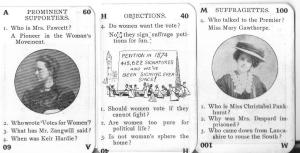 The game comprises 54 cards (all present) divided into 13 sets of 4 cards each – one of the odd ones being known as ‘The Bill’ – and the other a spare which has been used to record the score of a game played long ago by 6 people, designated by their initials. All the sets have names: eg. Prominent Supporters, Arguments, Freewomen, Voteless Women etc – and each card poses a series of questions. Some of the cards also carry photographs – of Christabel Pankhurst, Annie Kenney, Mrs Fawcett, Elizabeth Robins, Israel Zangwill, and Mary Gawthorpe.
The game comprises 54 cards (all present) divided into 13 sets of 4 cards each – one of the odd ones being known as ‘The Bill’ – and the other a spare which has been used to record the score of a game played long ago by 6 people, designated by their initials. All the sets have names: eg. Prominent Supporters, Arguments, Freewomen, Voteless Women etc – and each card poses a series of questions. Some of the cards also carry photographs – of Christabel Pankhurst, Annie Kenney, Mrs Fawcett, Elizabeth Robins, Israel Zangwill, and Mary Gawthorpe.
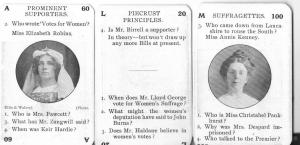 Along with the cards – and the original box – is the original, all-important, set of rules. These describe in detail the various ways in which the game can be played – it seems very inventive.
Along with the cards – and the original box – is the original, all-important, set of rules. These describe in detail the various ways in which the game can be played – it seems very inventive.
This is an incredibly scarce item. Although I wrote of it in The Women’s Suffrage Movement: a reference guide, this is the first set I have ever seen. An amazing survival.
Collecting Suffrage: Punch cartoon: Ulysses and the Steam Sirens
Posted by womanandhersphere in Collecting Suffrage on August 10, 2012
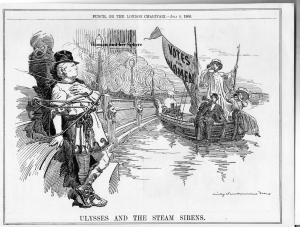 ULYSSES AND THE STEAM SIRENS -full page from 8 July 1908 issue of Punch.
ULYSSES AND THE STEAM SIRENS -full page from 8 July 1908 issue of Punch.
Asquith is tied to the Embankment as a tug bearing suffragettes with loudhailers and a ‘Votes for Women’ saild approaches. The reference is to the boat the WSPU used to announce to the House of Commons, from the river, their forthcoming Hyde Park demonstration.
Very good condition – £12 post free. NOW SOLD
To buy contact e.crawford@sphere20.freeserve.co.uk
